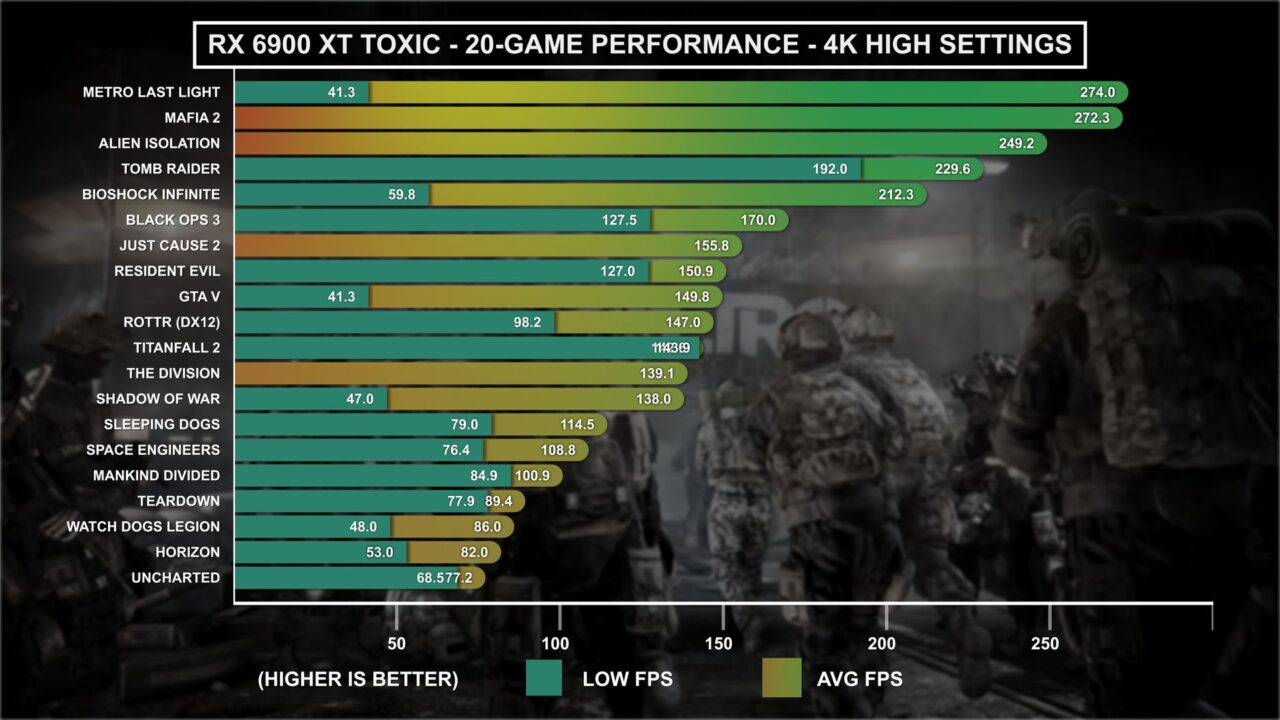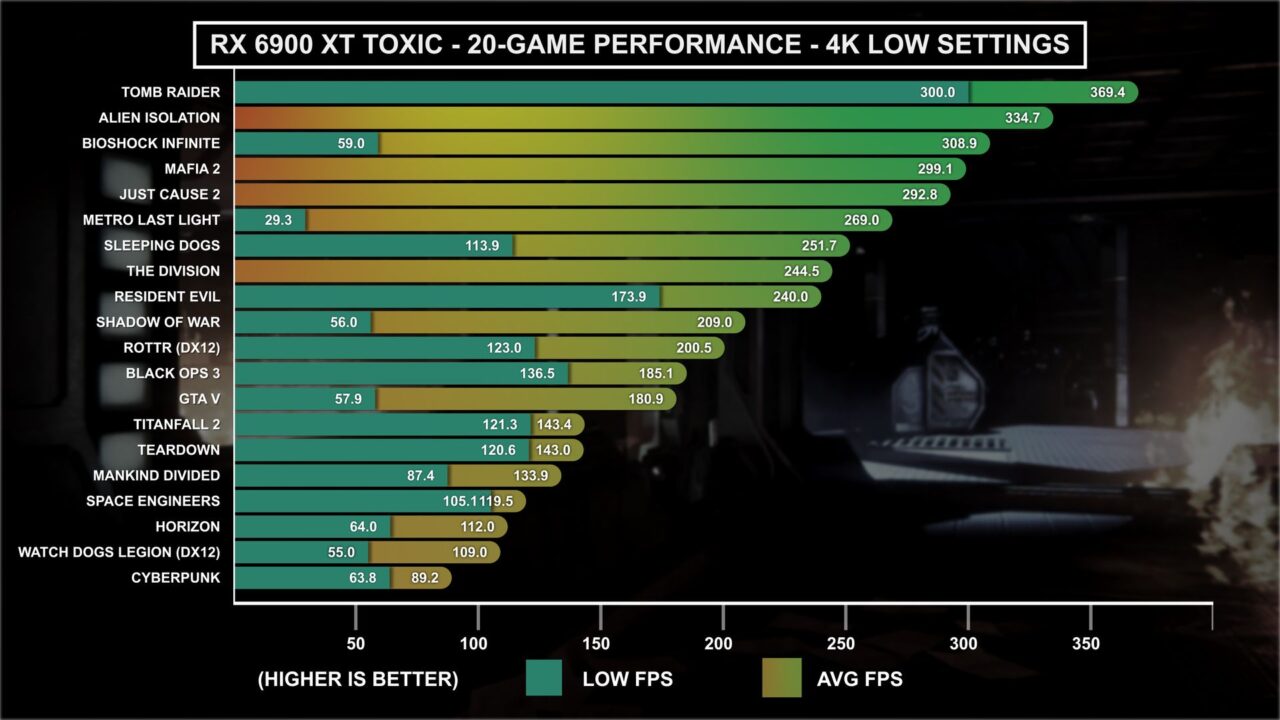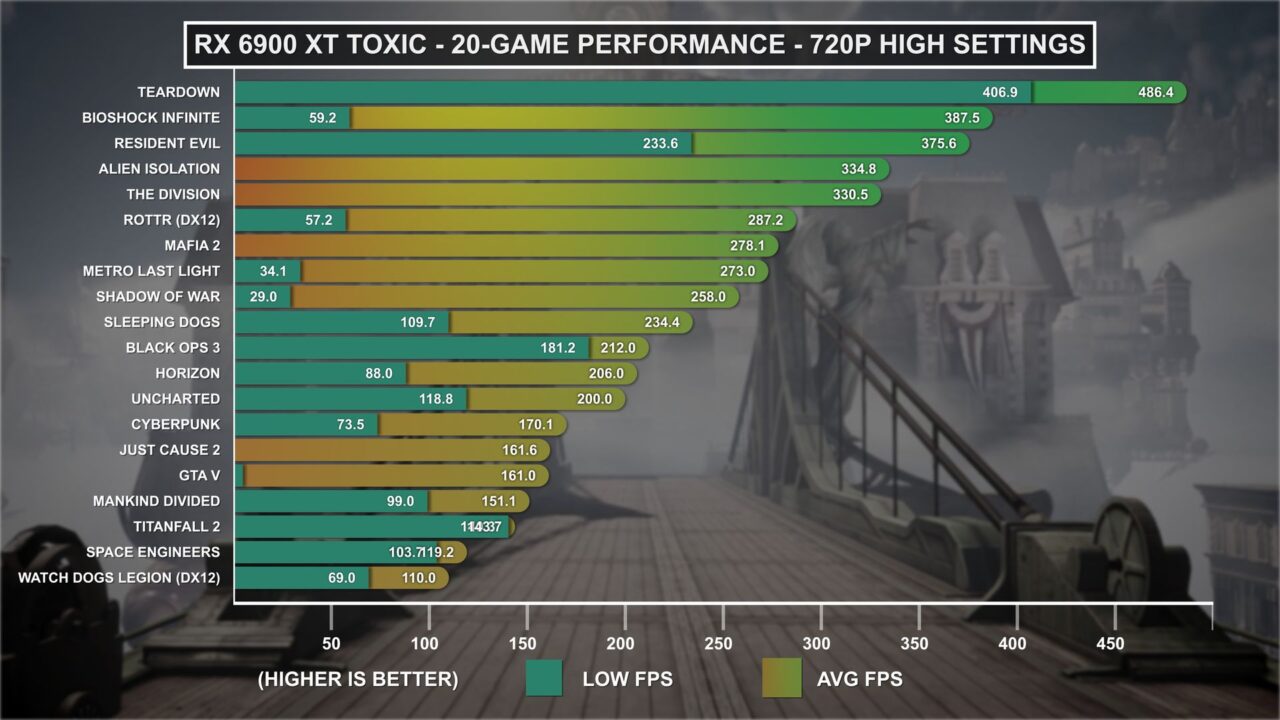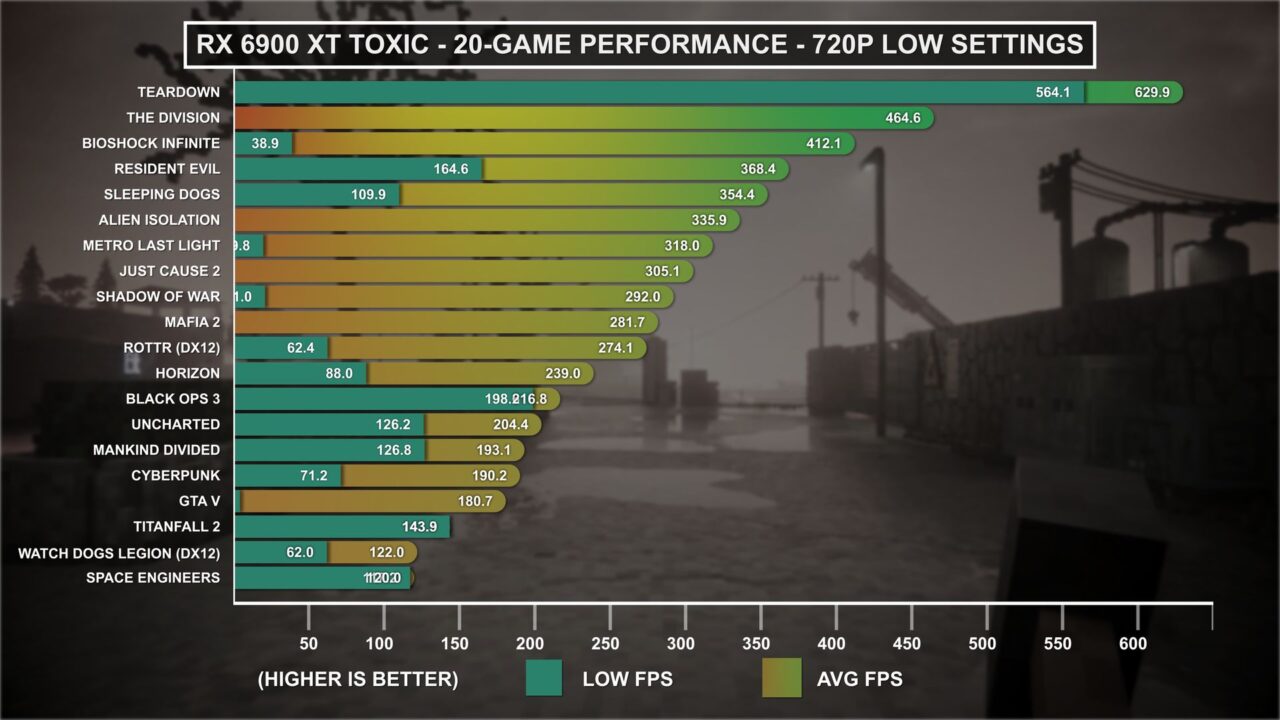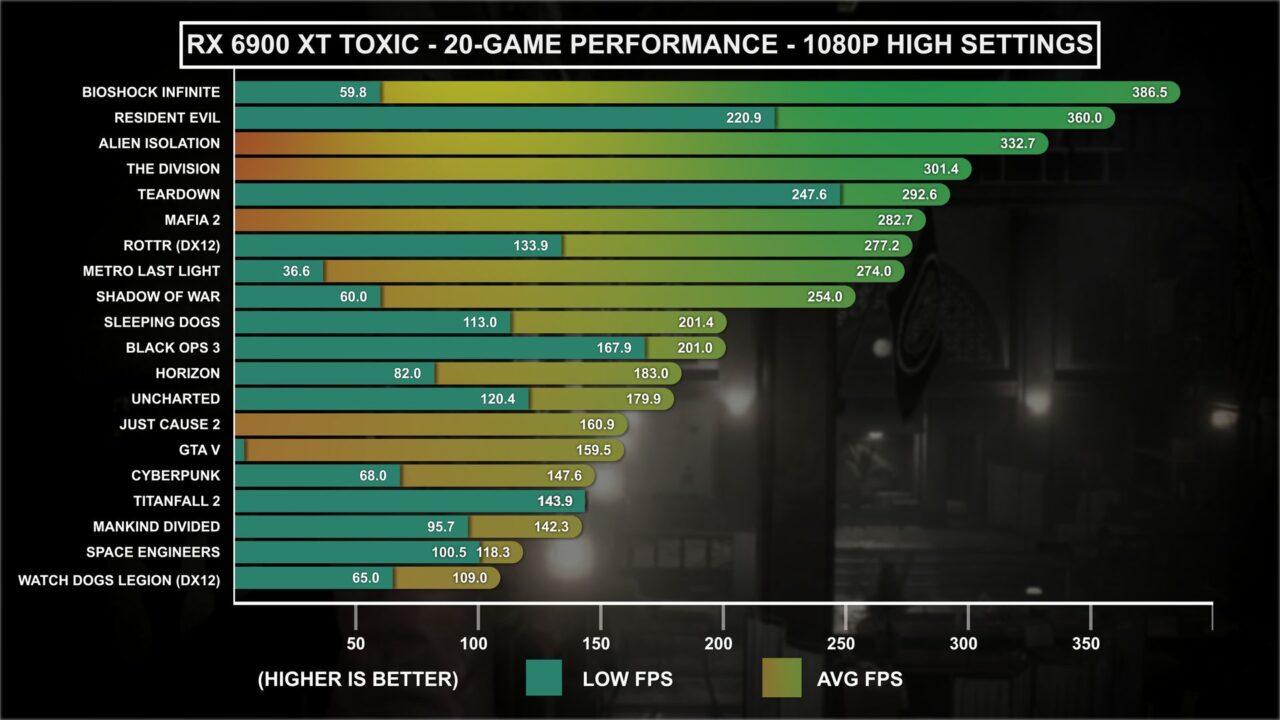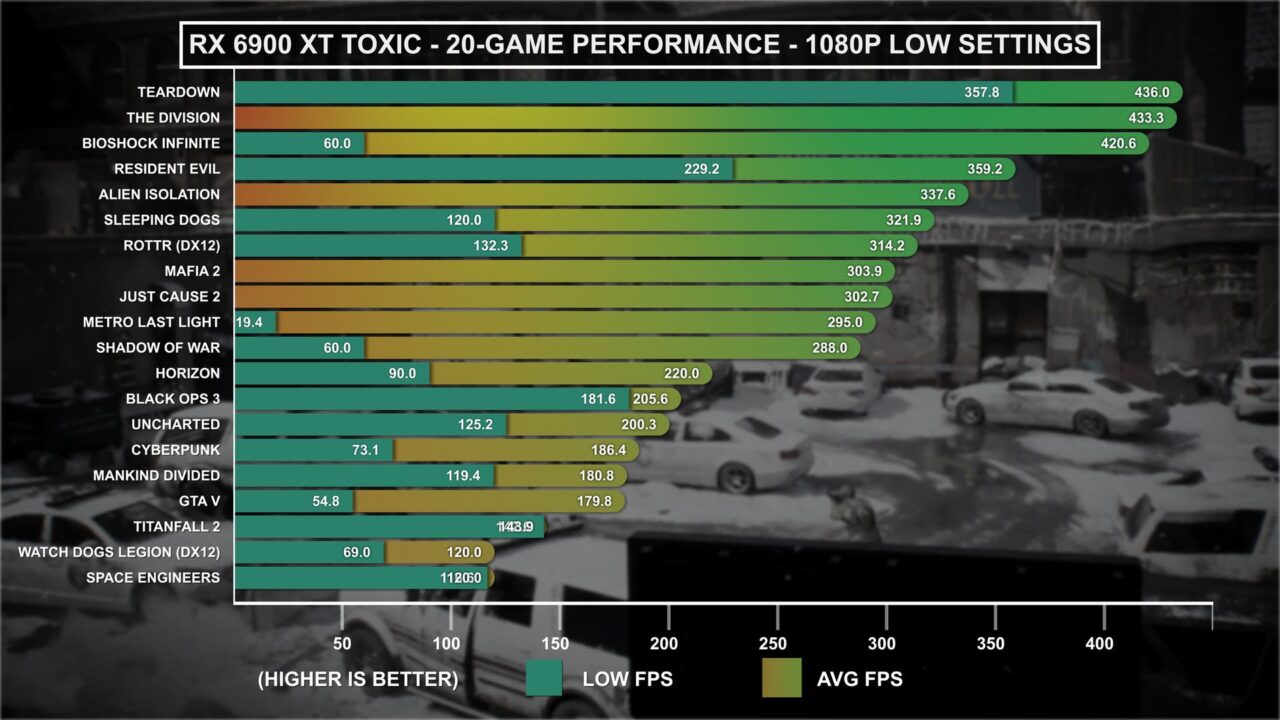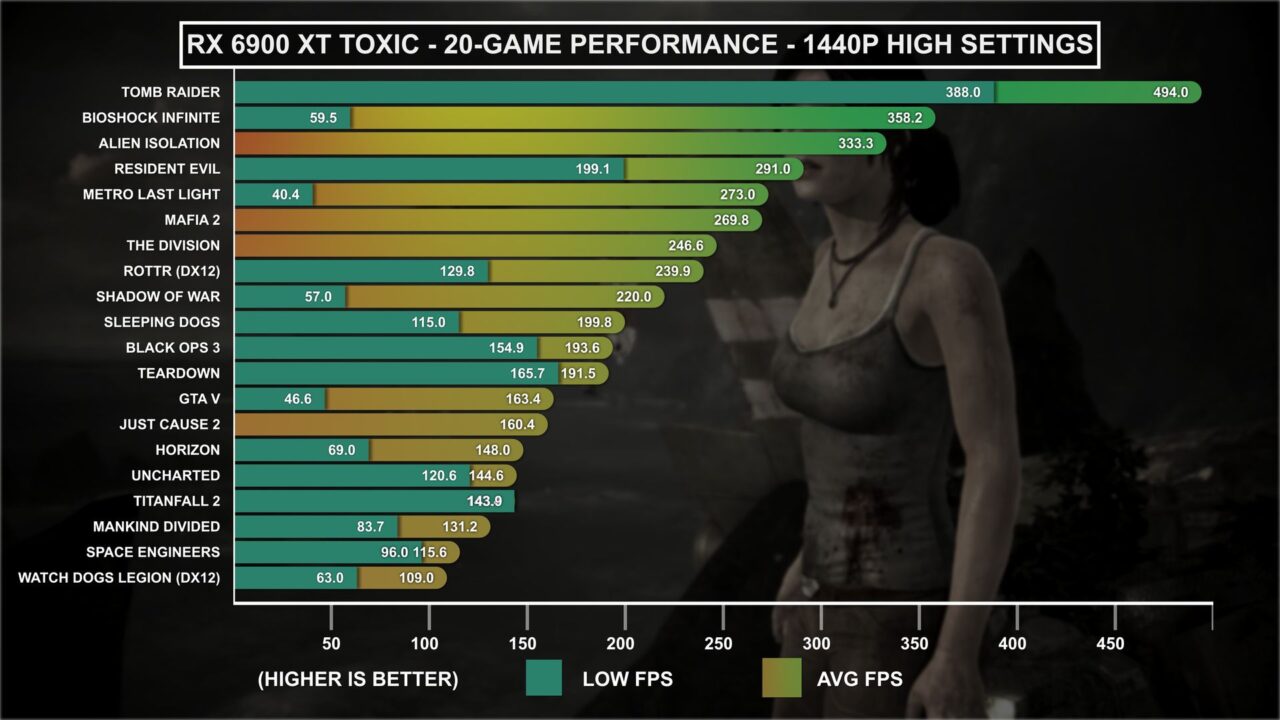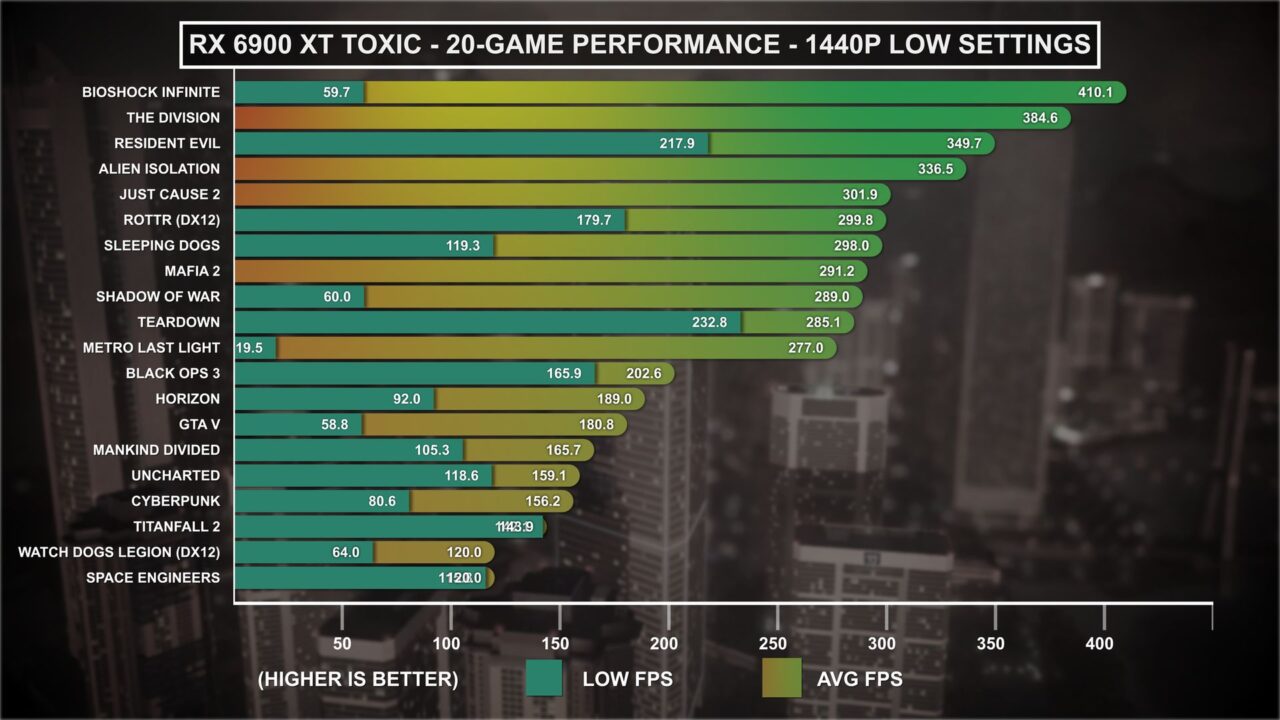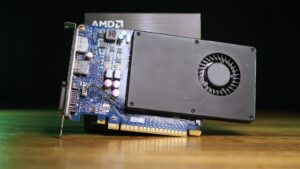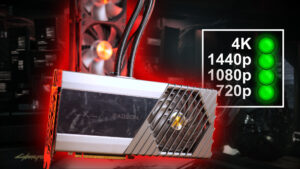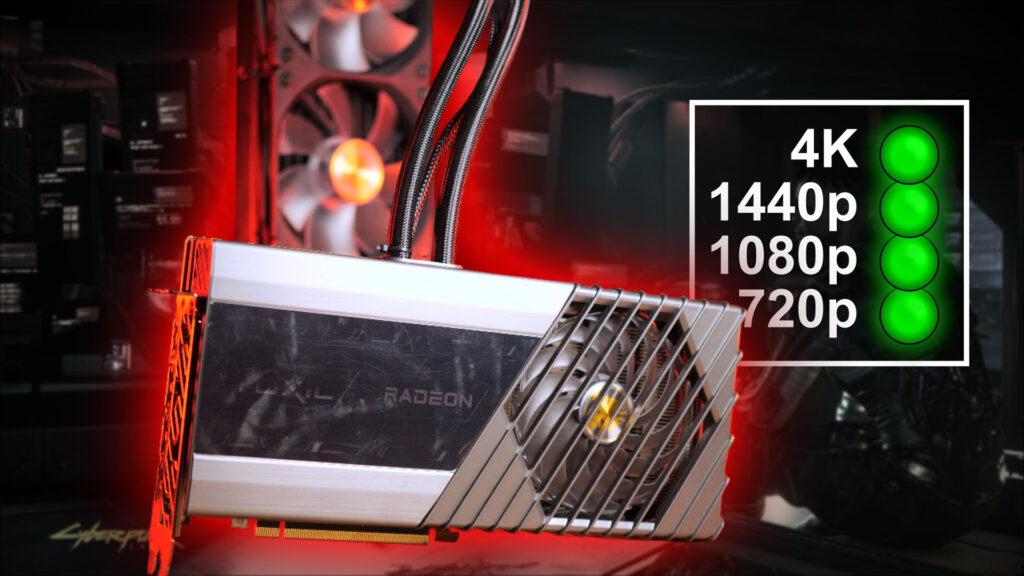
TESTED IN 21 GAMES FROM 720P TO 4K PLUS POWER, NOISE, THERMALS, VALUE AND MORE
AN ALL-OUT TAKE ON A FLAGSHIP.
Today I’m reviewing the RX 6900 XT TOXIC Liquid Version; Sapphire’s all-out take on AMD’s already very fast RX 6900 XT. This model was released in early 2021 at an eye-watering price of $1,499, but can be had today on the used market for less than $600. This card was briefly on loan to me, so I only had a couple days to do all of my testing, but I was able to run it through my entire review suite.
Despite being a powerful modern graphics card, I’m going to completely take it out of context, and run it through a selection of 21 games released over the last 13 years. I’ll be testing at 4 resolutions: 720p, 1080p, 1440p, and 4K. For each resolution, I will be testing with both LOW quality settings and HIGH quality settings. Then I’m going to go over price to performance, software tuning limits, power draw, and thermals.
Prefer video reviews? Watch on YouTube: https://youtu.be/dfOpWmyH4-A
RX 6900 XT CARD SPECS.
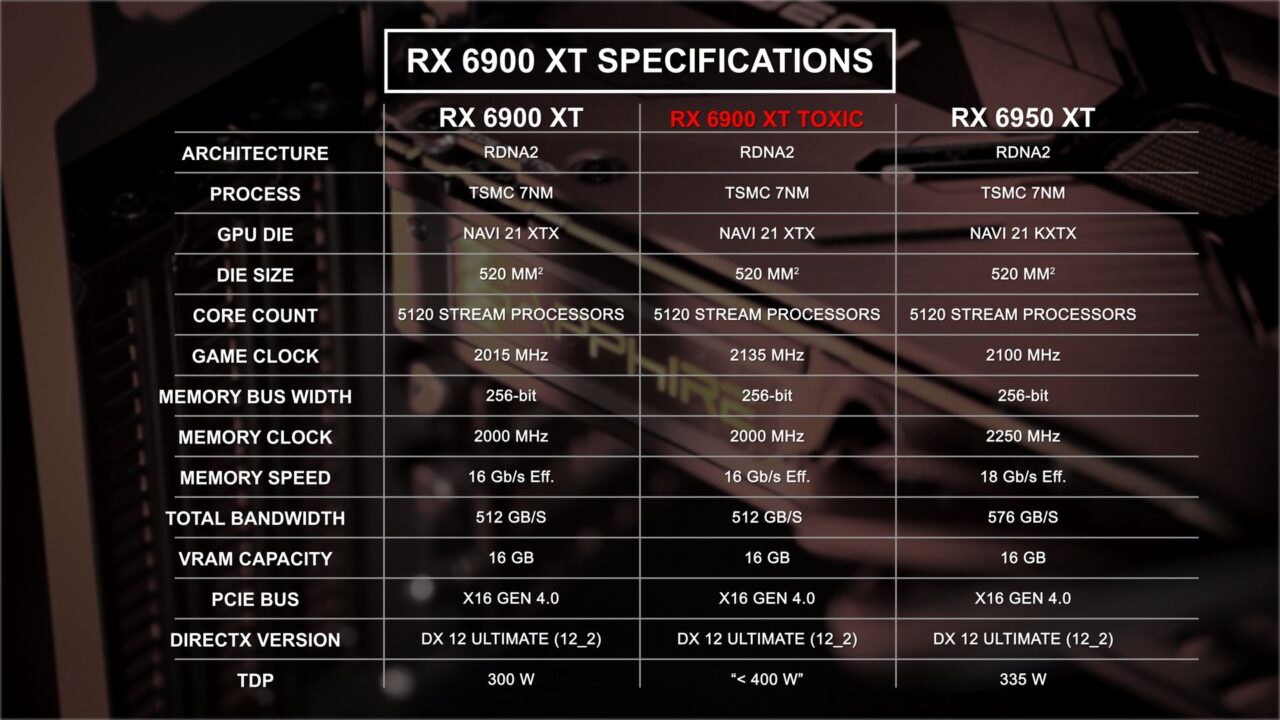
But first, let’s get into the card’s specifications.
The GPU die is based on the 520 mm² NAVI 21, in this case the XTX variant, same as the standard RX 6900 XT. This gives the TOXIC 5120 Stream Processors from 80 compute units with a rated game clock of 2135 MHz, 120 MHz higher than the reference card, and 35 MHz higher than the newer reference 6950 XT. Memory is accessed over a 256-bit bus running at 2000 MHz for an effective memory speed of 16 Gb/s resulting in a total bandwidth of 512 GB/s. Critically, however, the memory system is further bolstered by 128 MB of on-die infinity cache.
The 6900 XT TOXIC, like all other GPUs based on AMD’s NAVI 21 architecture, features 16GB of VRAM allowing for comfortable use of generous textures and other game assets. It also features PCI Expression x16 Gen 4.0 to help move data into and out of VRAM faster. As we’ll see in the gaming benchmarks, this GPU does allow for excellent 4K performance even in very demanding games. However, in the most demanding games 4K high settings does begin to challenge this card, possibly due to the VRAM and cache design.
RX 6900 XT FEATURES SUPPORT.
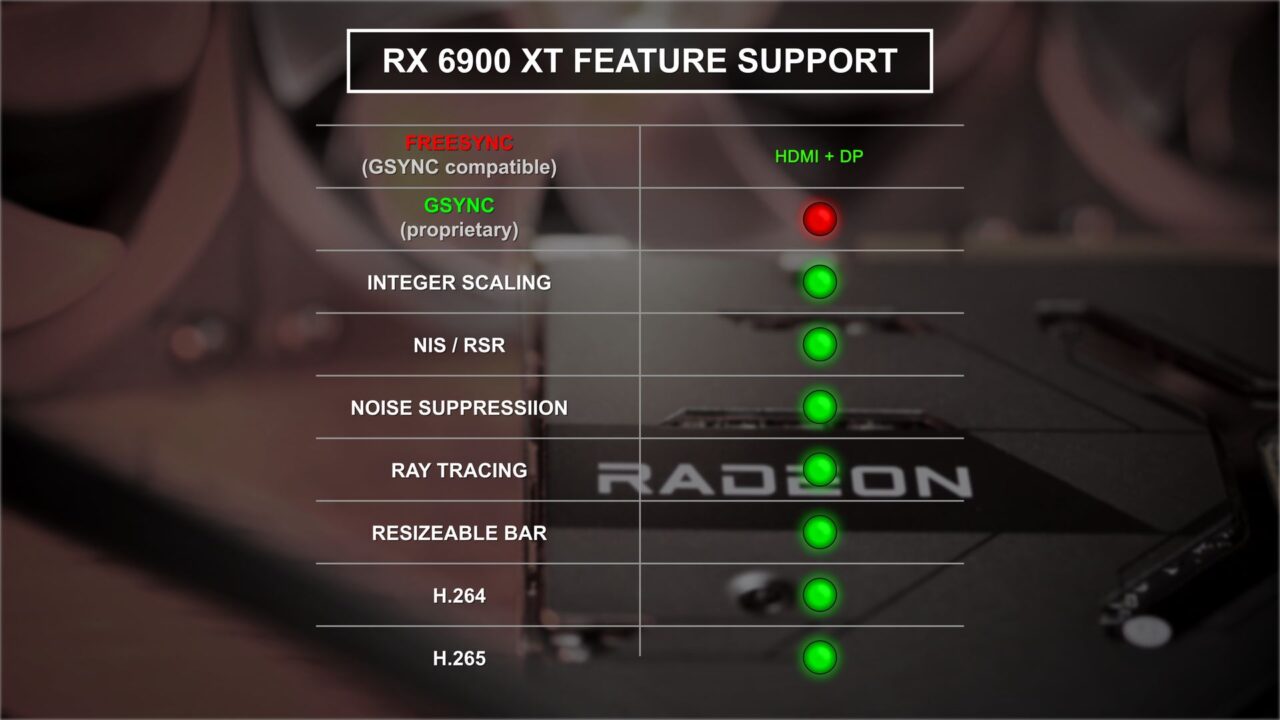
Nearly all graphics card features are supported here, with the exception of NVIDIA’s proprietary technology like the original GSYNC proprietary adaptive sync system, DLSS, and CUDA. Thankfully, most newer gaming monitors instead make use of FreeSync, or “GSYNC Compatible” adaptive sync technology, so that won’t be a big loss. DLSS is largely replaced by FSR 2.0 and its newer incarnations. The lack of CUDA support is probably a significant detriment to some users, but this card is still very capable in programs that support OpenCL. All the usual driver features are present, and video encoding/decoding is fully supported for H.264 and H.265. AV1 support is limited to decode-only.
A LOOK AT THE RX 6900 XT
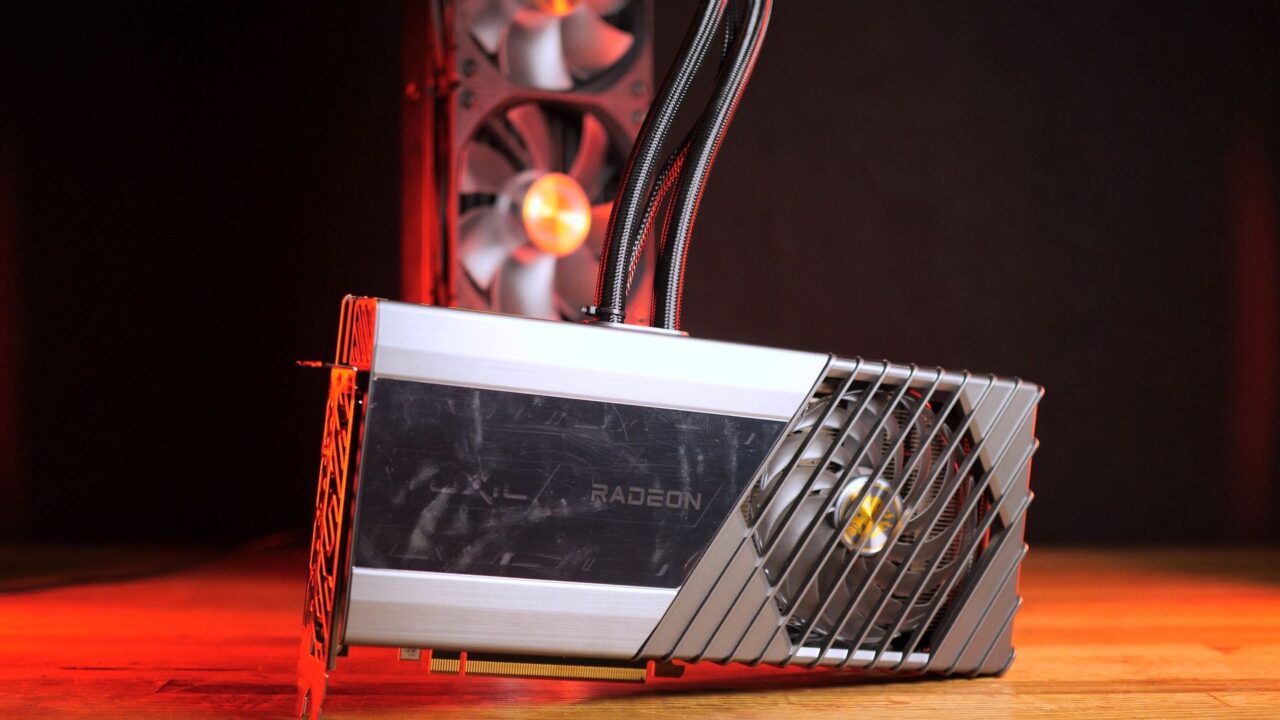
The most noteworthy feature of the Sapphire Toxic card is the enormous 360mm radiator. The massive cooler is able to dissipate the nearly 400 Watts of power draw effortlessly, and quietly using the three RGB 120mm fans. The body of the card is a sleek silver brushed finish divided by a mirror finished section featuring RGB lit TOXIC and RADEON logos. A single RGB fan is built into the shroud to allow for cooling board components not directly cooled by the liquid cooler.
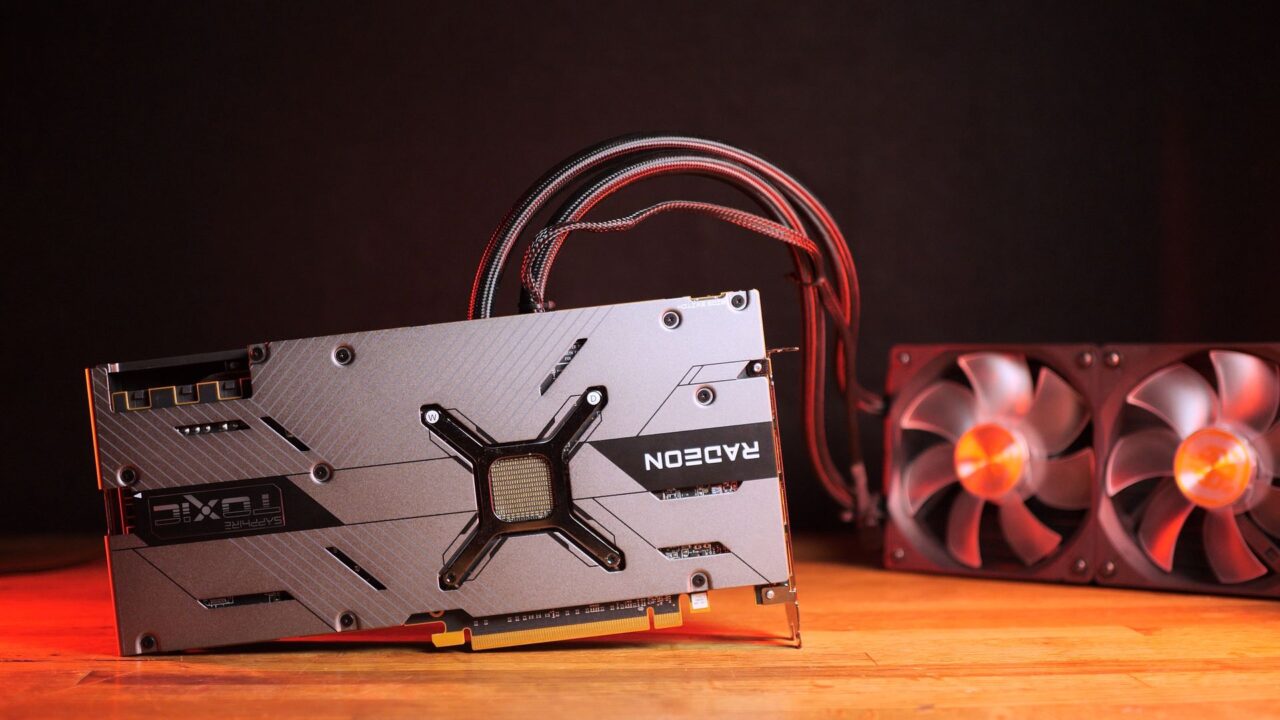
The back of the card maintains the sleek silver look of the front, with another RGB-lit TOXIC logo on the end toward the power connectors. The liquid cooler tubes extend straight up from the edge of the card, and do not attempt to hide the fan and RGB control wires that run to the radiator.
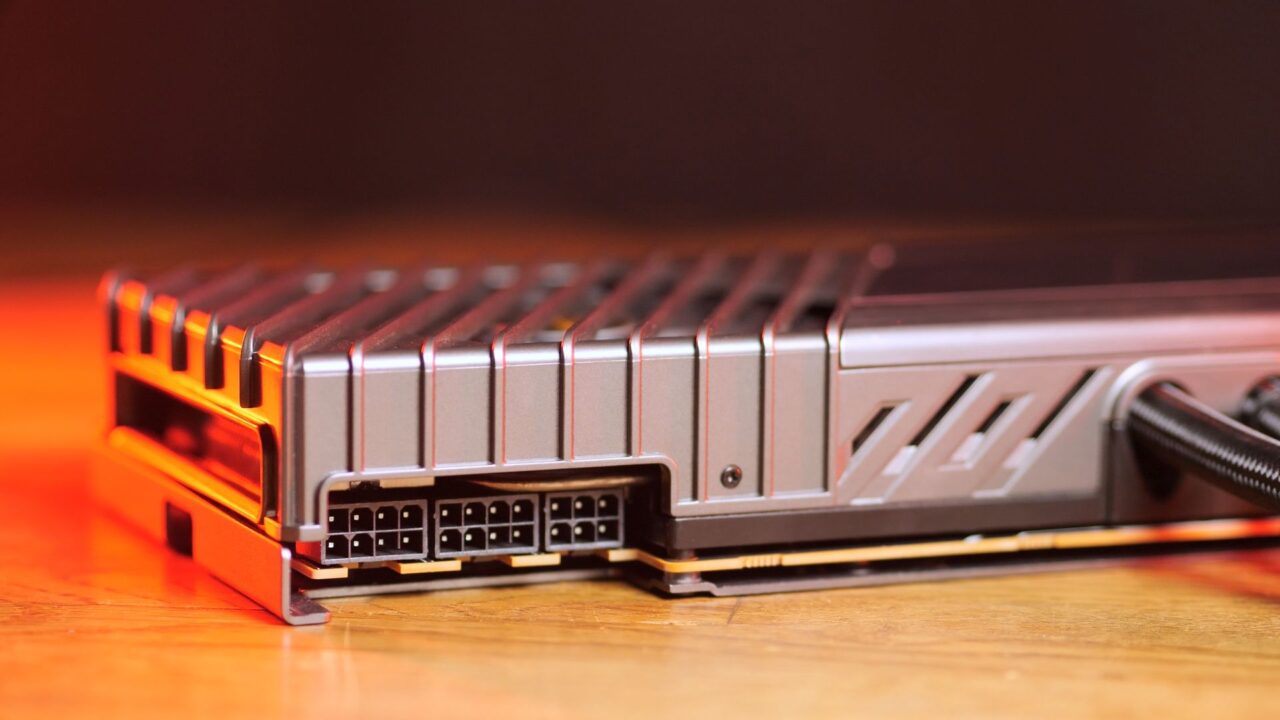
While the AMD reference model of the RX 6900 XT features just two 8-pin power inputs, Sapphire has added an additional 6-pin input. All inputs combined with the PCIe slot power should comfortably handle 450 Watts.
THE SYSTEM.
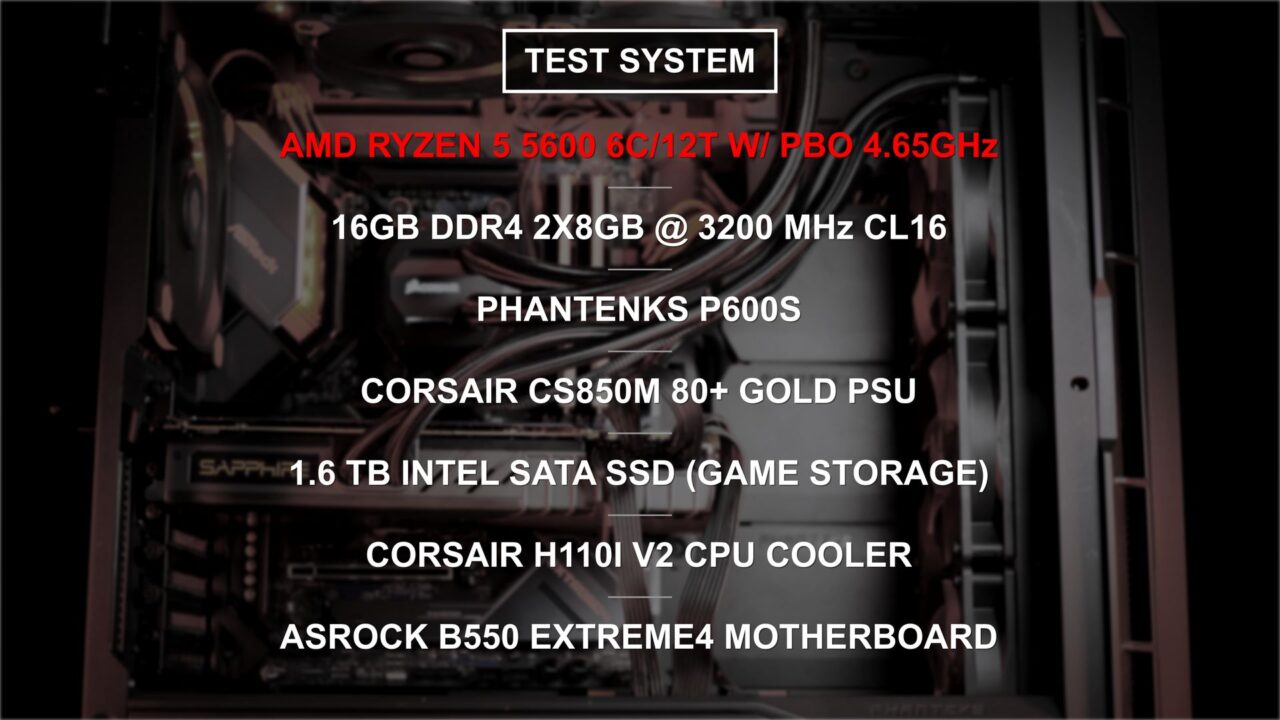
The system used for testing is based around the AMD Ryzen 5 5600, 6-core 12-thread processor on an AsRock B550 Extreme 4 motherboard. PBO has been enabled for a constant 4.65GHz all-core frequency. 16GB of dual channel DDR4 have been clocked at 3200 MHz CL 16. The driver version used for testing is Radeon Adrenalin 22.11.2.
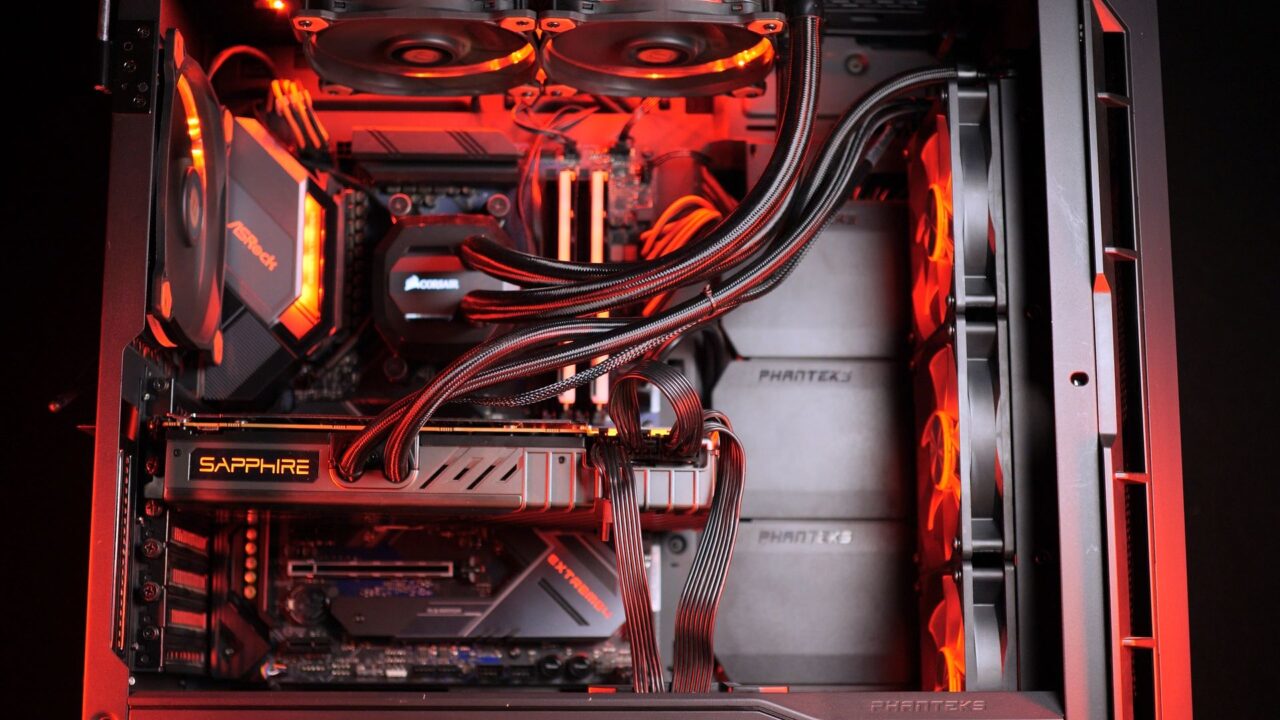
Because I had limited time with the card, I wasn’t able to spend the time to re-arrange my test system’s fans the way I’d like. I was left front-mounting the radiator with the included fans left in an exhaust configuration. This meant the whole system had a negative pressure layout. Keep this in mind for the noise and thermals section.
RX 6900 XT IN PRODUCTIVITY.
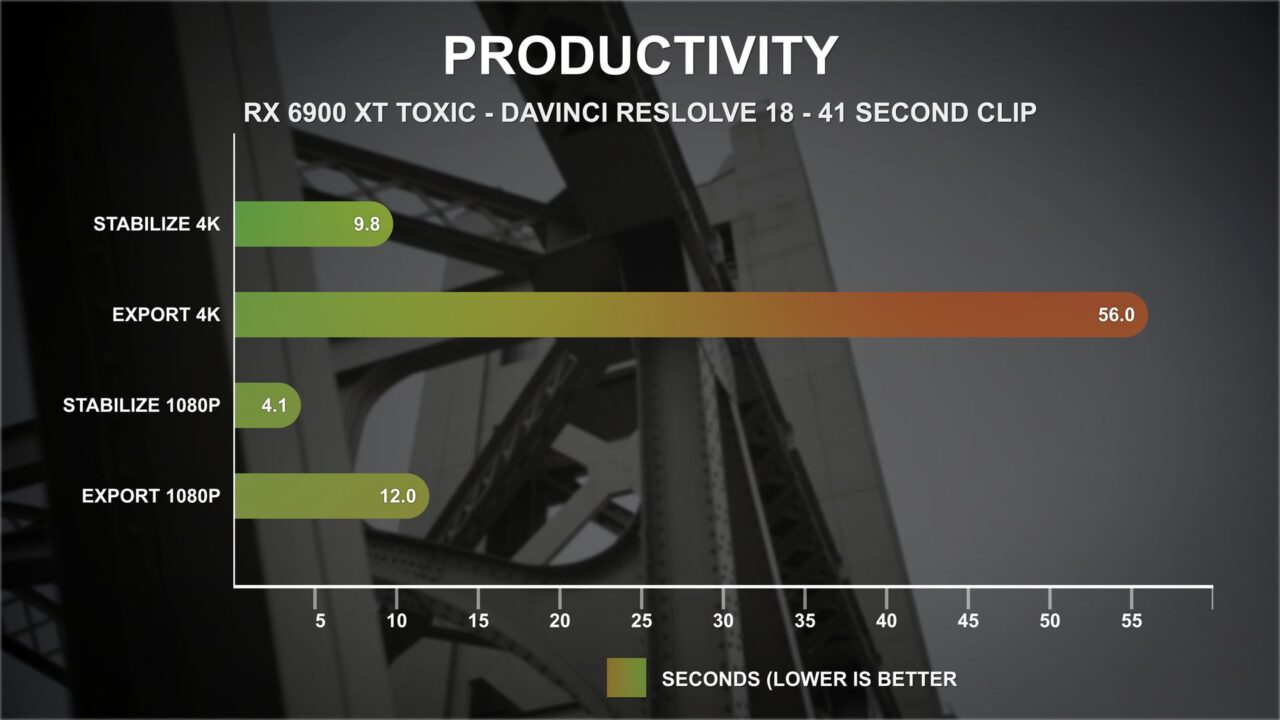
First things first, I want to do a quick productivity test. For this I’m using DaVinci Resolve 18 with a 41 second clip at both 4K and 1080p. The stabilization test records the time to stabilize the unedited clip, then the export test records the time to export the stabilized clip with a corrective LUT applied. The test leverages both the CPU and GPU, so these results may be limited by the comparatively budget Ryzen 5600 used.
So now I’ll just move into the game benchmarks.
MAFIA II.
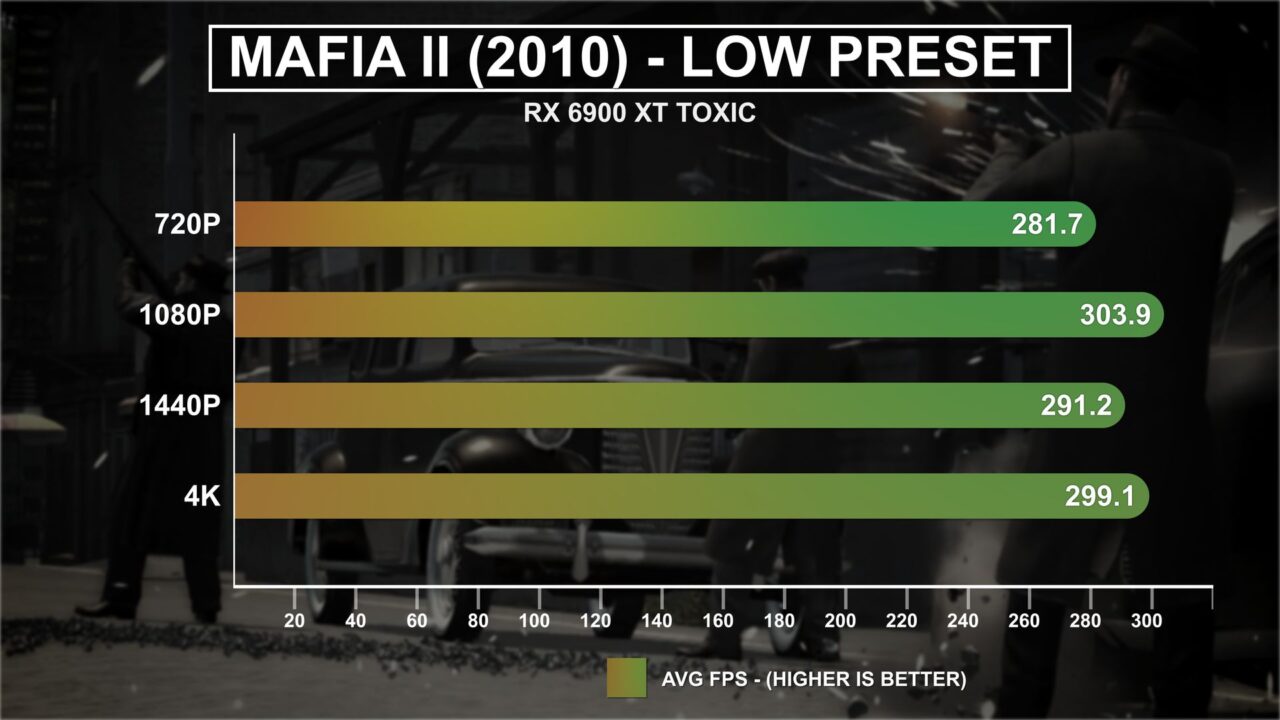
I’ll start with Mafia 2 Classic released in 2010. First looking at the results using the low preset. It’s clear looking at this chart that there is a limit around the 300 FPS mark. At different points during the test run, FPS was capped at different rates depending on the exact scene in the test. This seems to be a limitation of the game engine.
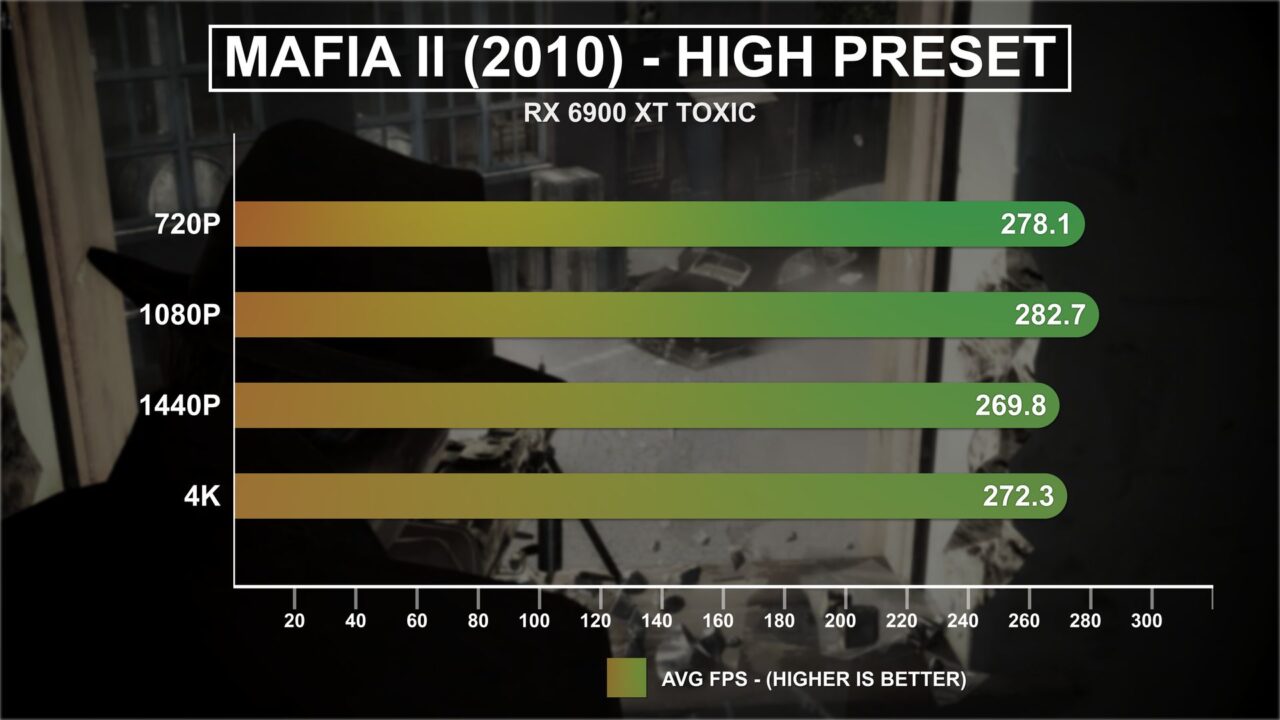
Looking at the High settings, performance has not fallen much at all. This first game tested makes an excellent case for enabling a framerate limit in AMD’s Radeon control center.
JUST CAUSE 2.
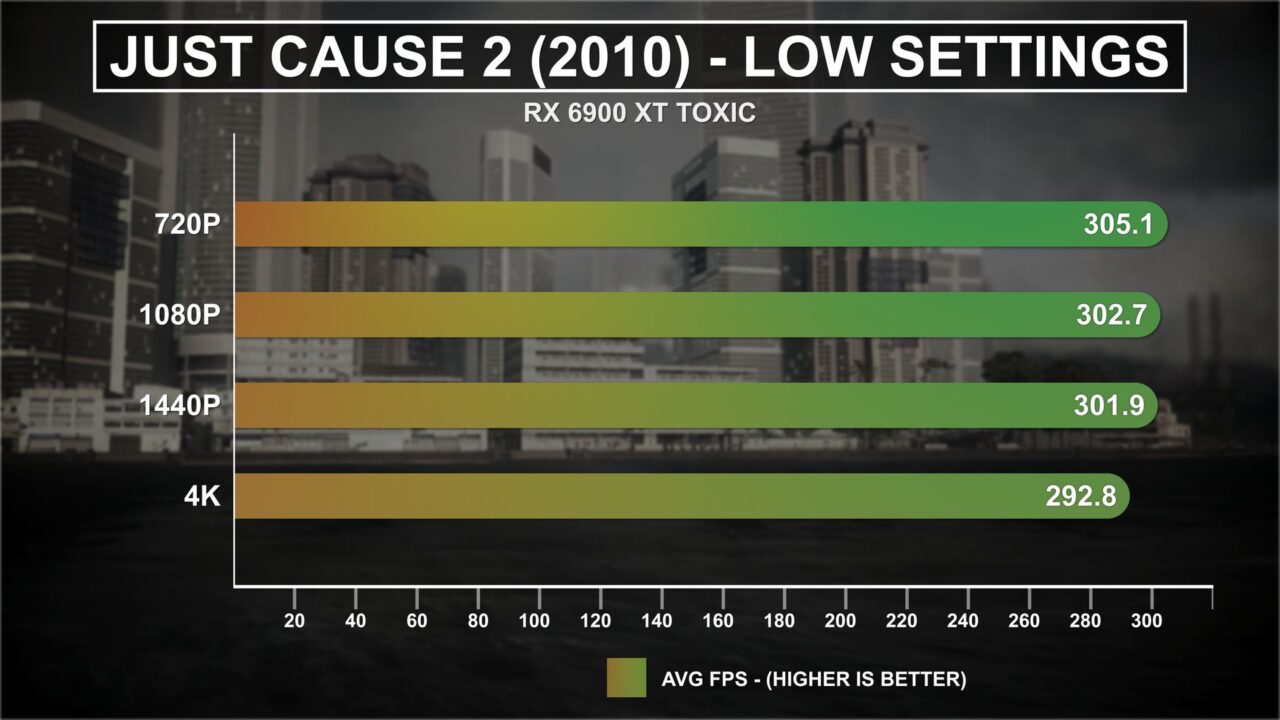
2010’s Just Cause 2 at low settings saw a similar framerate ceiling as Mafia 2, around 300 FPS. Again, making a strong case for a driver framerate cap.
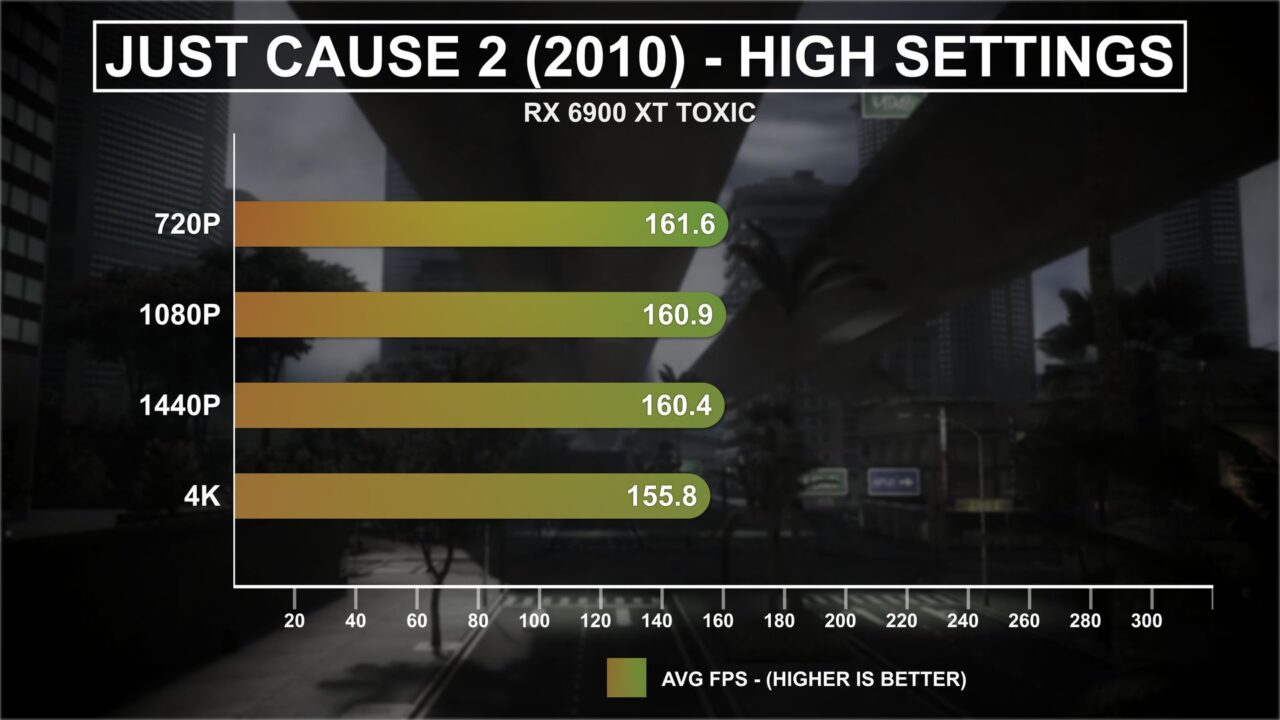
The High settings are another matter entirely. With a spread of results ranging from 156 FPS at 4K to “just” 162 FPS at 720p, it’s clear that something is holding the card back. In this case, the limit appears to be CPU single-thread performance. The increased CPU overhead of the game’s High settings, and the limited optimization for multithreading result in the much more limited performance using the High settings.
TOMB RAIDER 2013.
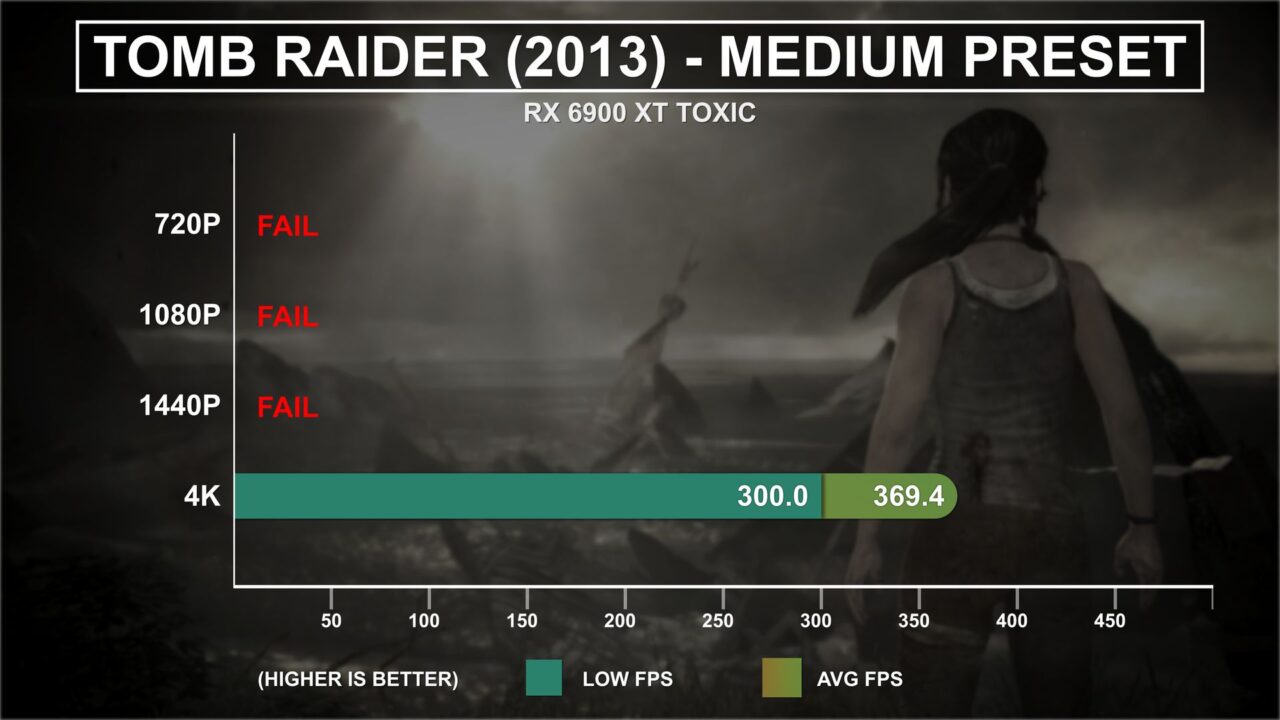
2013’s Tomb Raider reboot is very light on the CPU, allowing the RX 6900 XT to run into the several hundred FPS range. In fact, framerates are so high (over 600 FPS) at 1440p and below using the Medium preset, that the built-in benchmark tool freezes up during the test; the camera stops moving but the scene continues to animate and the test never ends. Therefore, despite rending an incredibly high framerate, it counts as a fail.
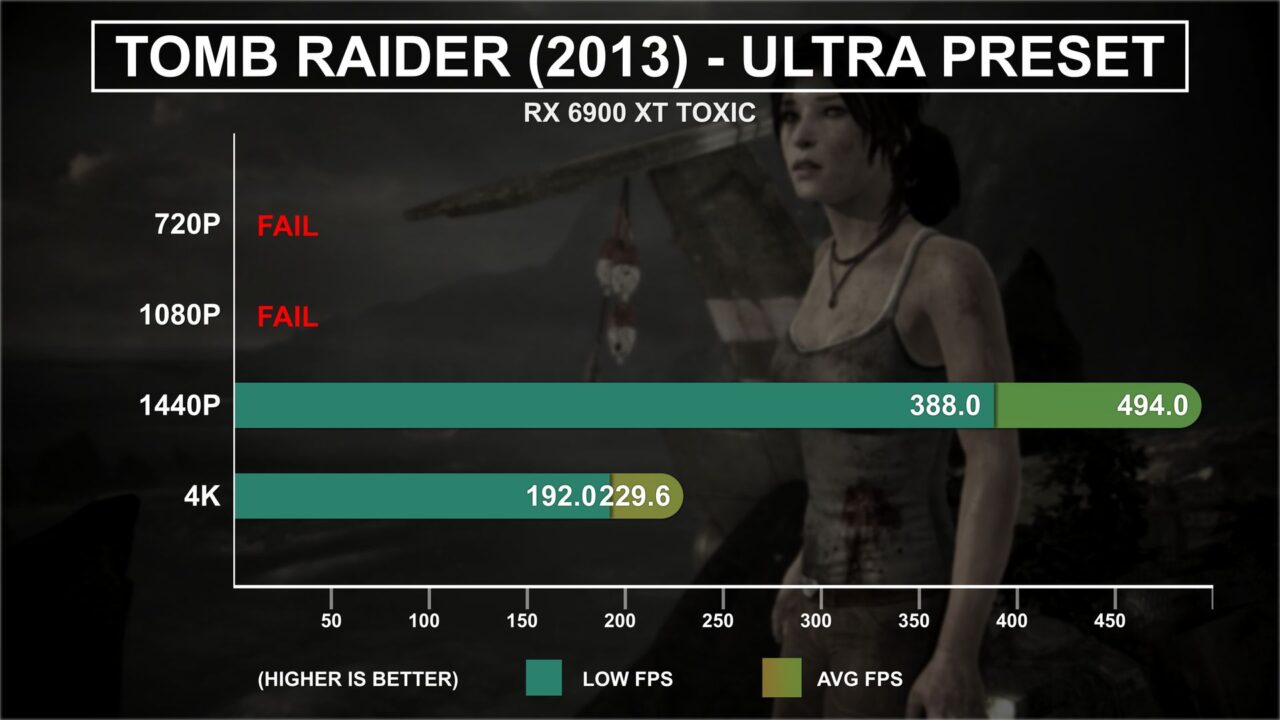
At the Ultra preset frame rates are still incredibly high, though 4K does see the RX 6900 XT humbled some. With 230 FPS on average, the game was certainly playable.
BIOSHOCK INFINITE.
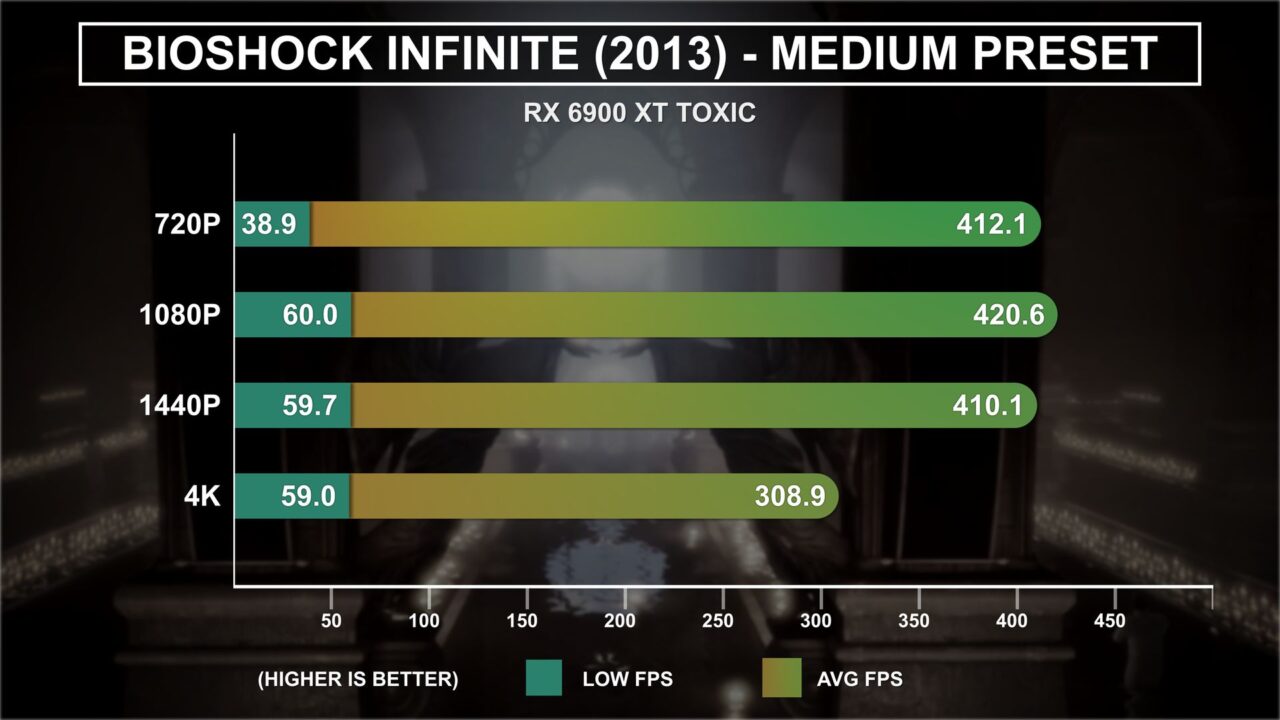
The next title tested is Bioshock Infinite, again from 2013. Once again the lower preset tested is the Medium preset. At this setting the game still looks beautiful, and is accessible even to much less powerful GPUs. This game is another example of strong framerate limitations at lower resolutions for the RX 6900 XT.
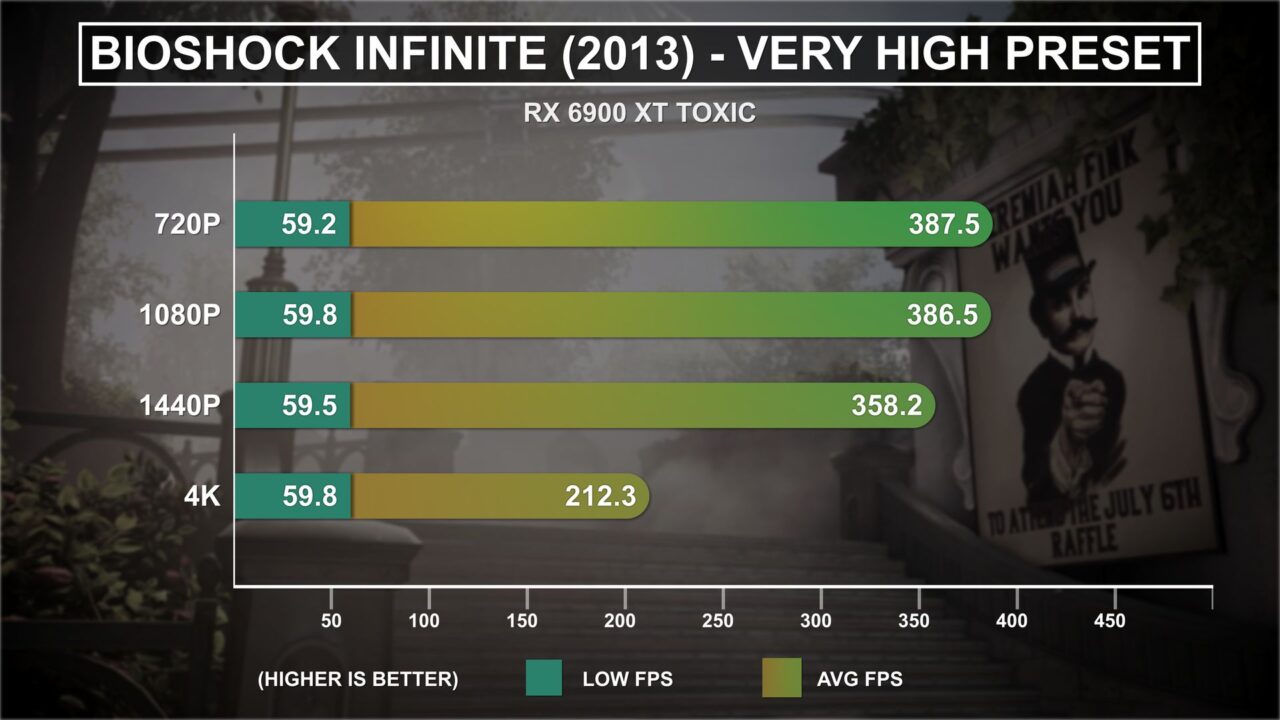
Switching to the Very High preset sees a similar limit for 1080p and 720p, though 1440p and especially 4K do begin to put the GPU to work. In this test it’s clear that 4K can be quite demanding, even on older titles like this.
METRO LAST LIGHT REDUX.
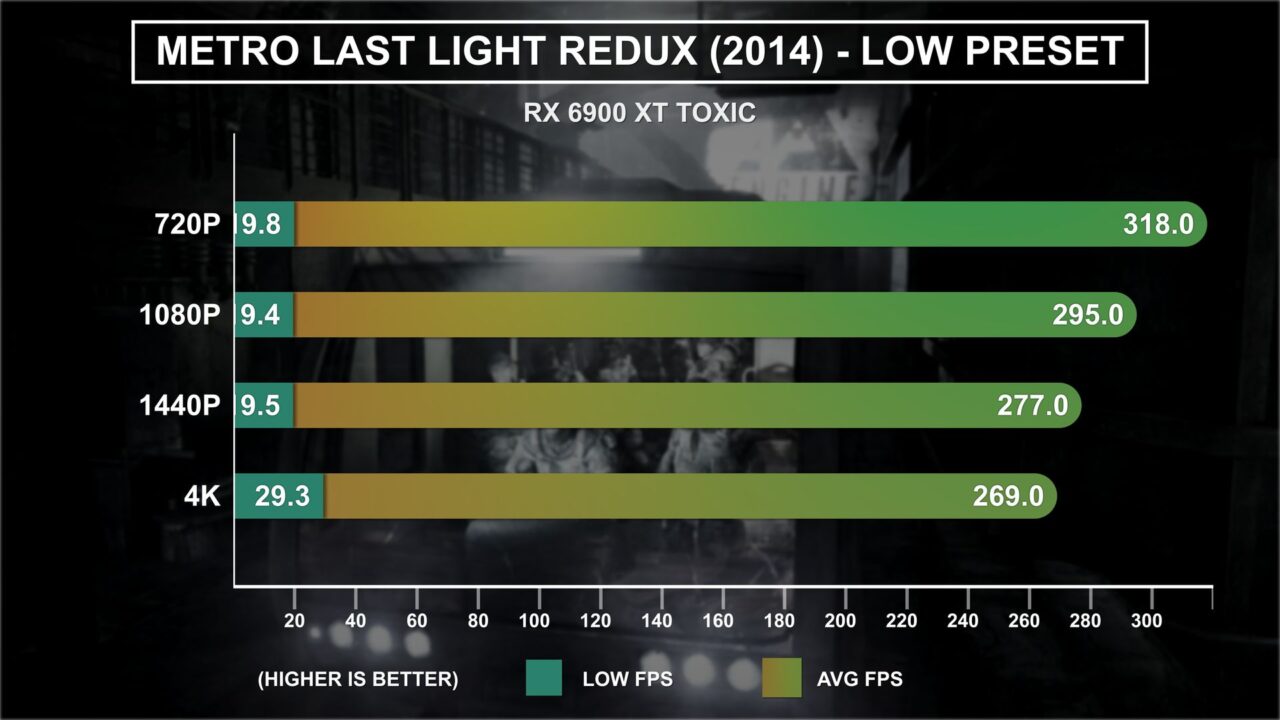
2014’s Metro Last Light Redux is an updated release of Metro Last Light from the year before. In this title framerates see arbitrary limits at different points in the benchmark run, similar to Mafia 2. This inconsistency leads to significant stuttering.
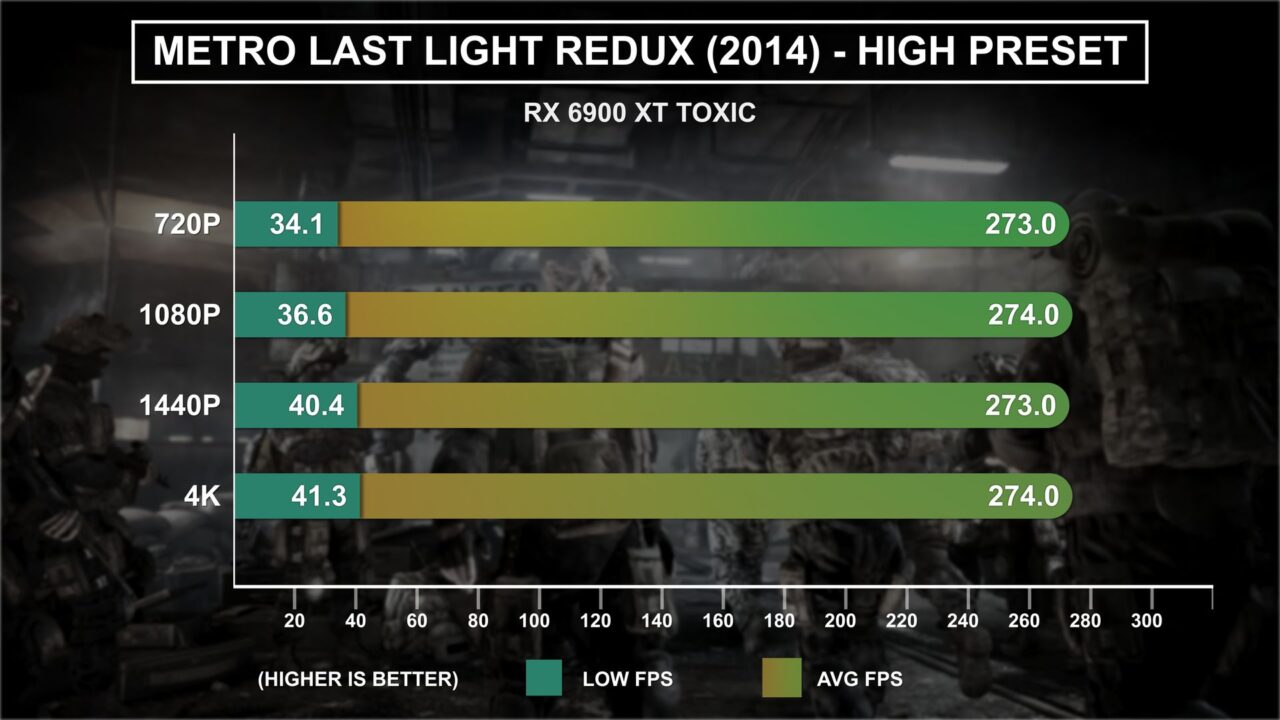
The High preset sees a reduction to the average framerate even at 720p, likely due to increased CPU overhead because of the higher graphics settings. In the case the minimum framerates see a large improvement, despite a bottleneck at 274 FPS even at 4K.
SLEEPING DOGS DEFINITIVE EDITION.
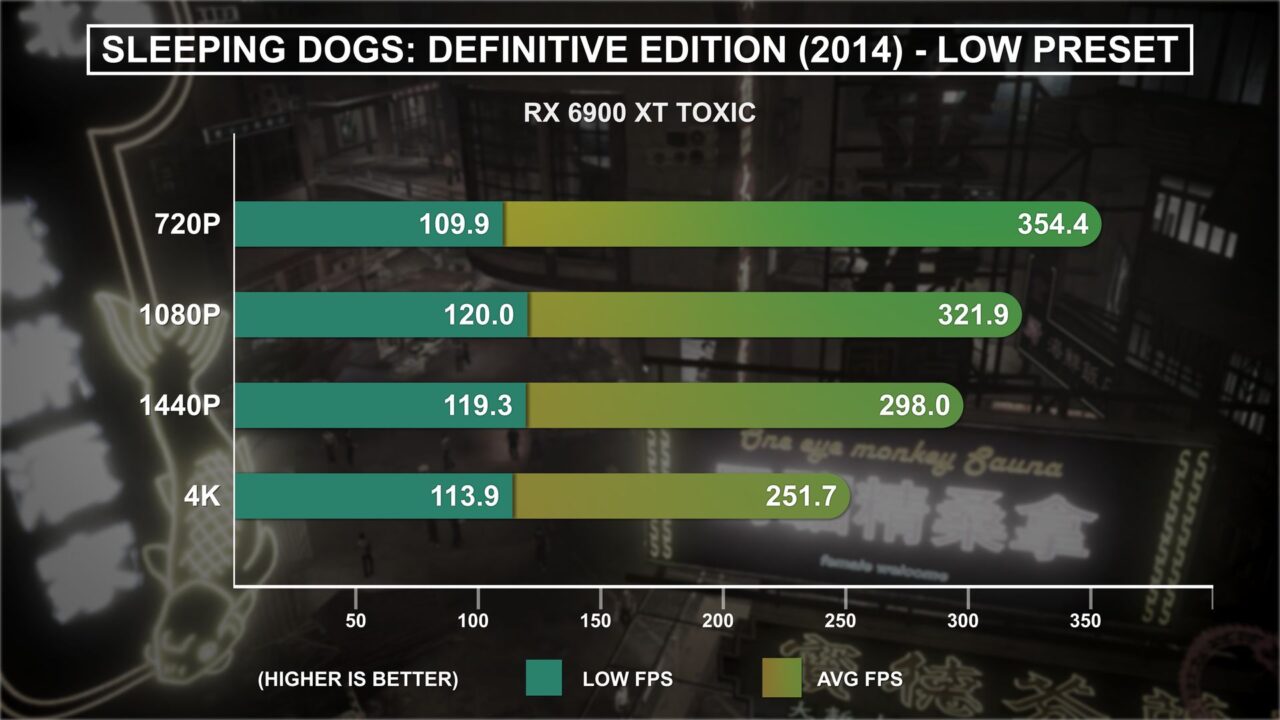
Another 2014 classic is Sleeping Dogs Definitive Edition. This open-world classic set in Hong Kong plays more nicely with the powerful RX 6900 XT. Minimum FPS is relatively stable around 100 FPS, and average FPS does increase as the resolution decreases.
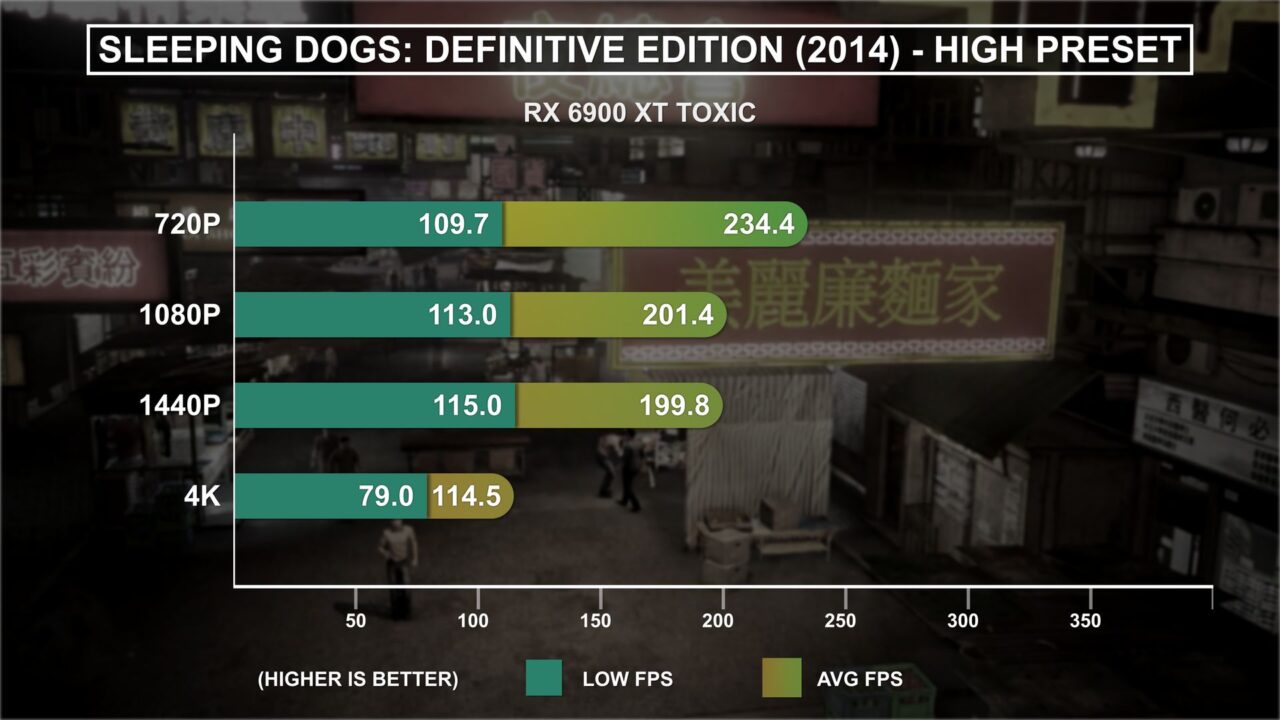
The High preset proves to be much more demanding on the GPU. Minimum framerates remain similar below 4K, but average FPS has seen a big drop. Performance at 4K went from 252 FPS to just 115 FPS, a 54% drop. The Minimums framerate saw “just” a 30% drop to 79 FPS. Of course, this result is still highly playable, though does speak to how demanding older games can become at higher resolutions.
ALIEN ISOLATION.
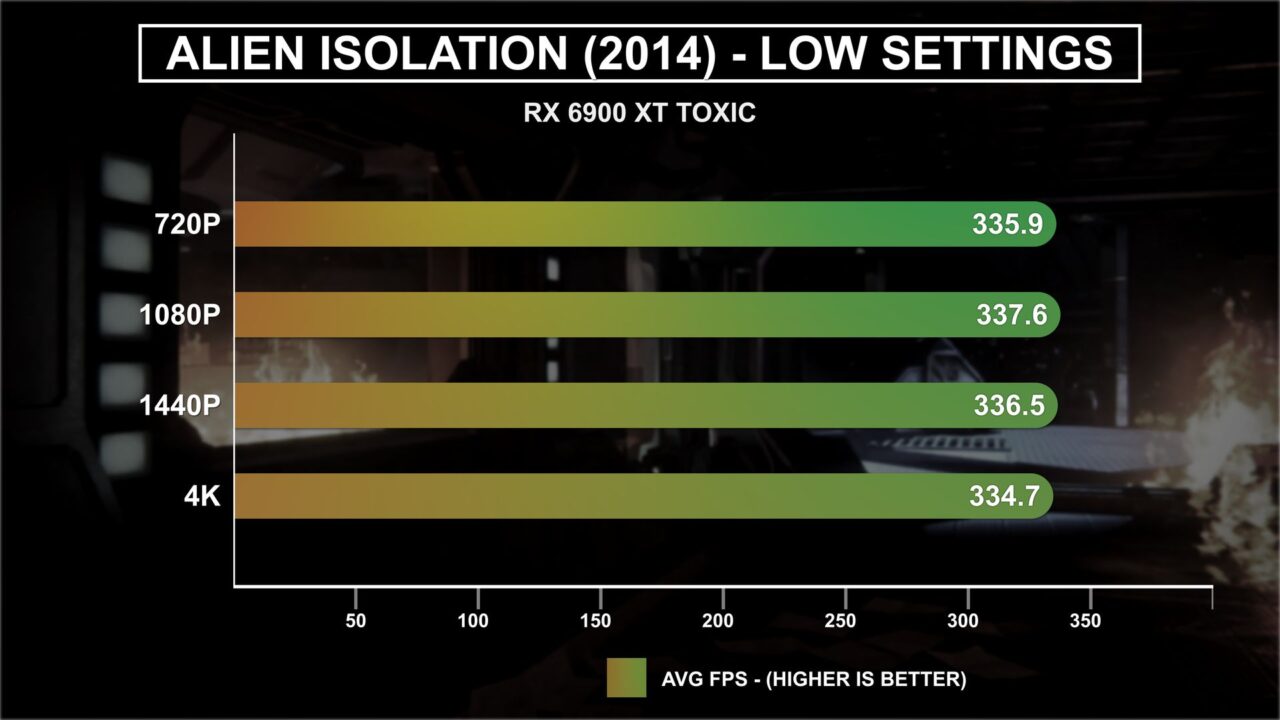
Now nearly ten years old, Alien Isolation is still a great experience for fans of the classic Alien franchise. Using the built-in benchmark, RX 6900 XT pushes the game engine to the limit. Averages are capped around the 335 FPS even at 4K when using the Low settings.
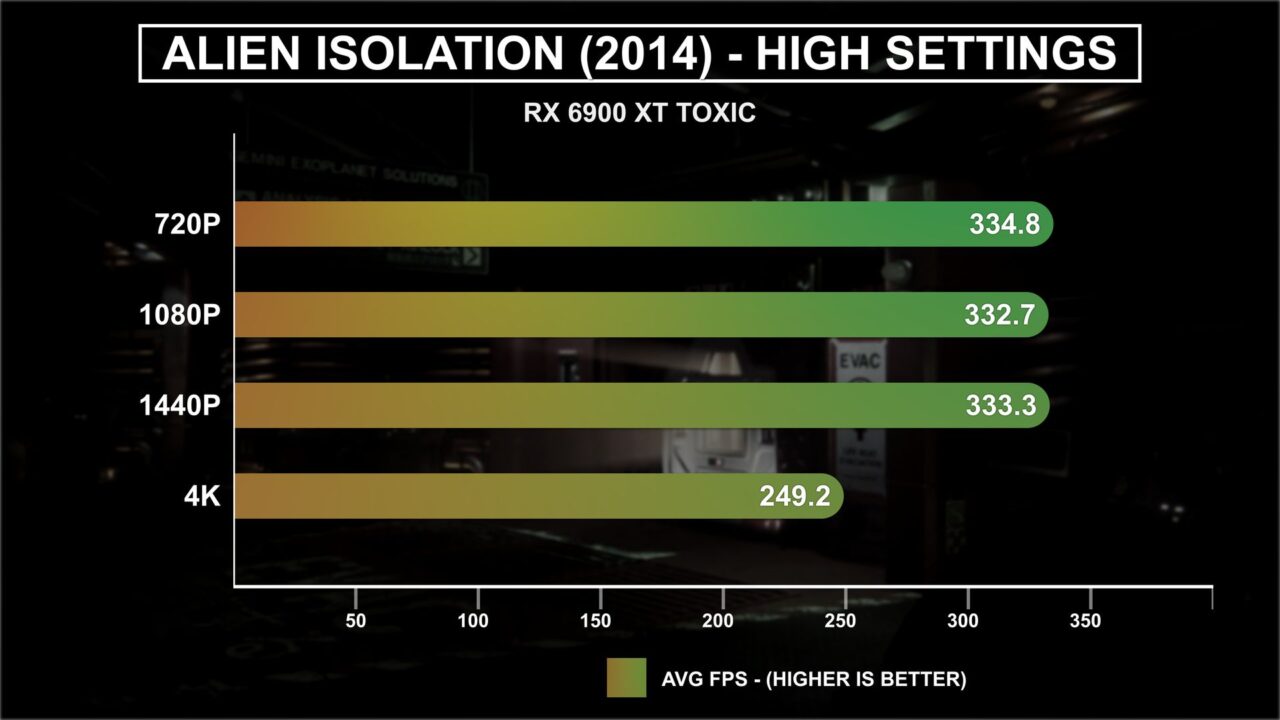
Dialing up the visuals a bit sees performance drop only at the extreme 4K resolution, even then FPS only drops to 250. It’s safe to say this card can handle this game with ease.
RISE OF THE TOMB RAIDER (DX11).
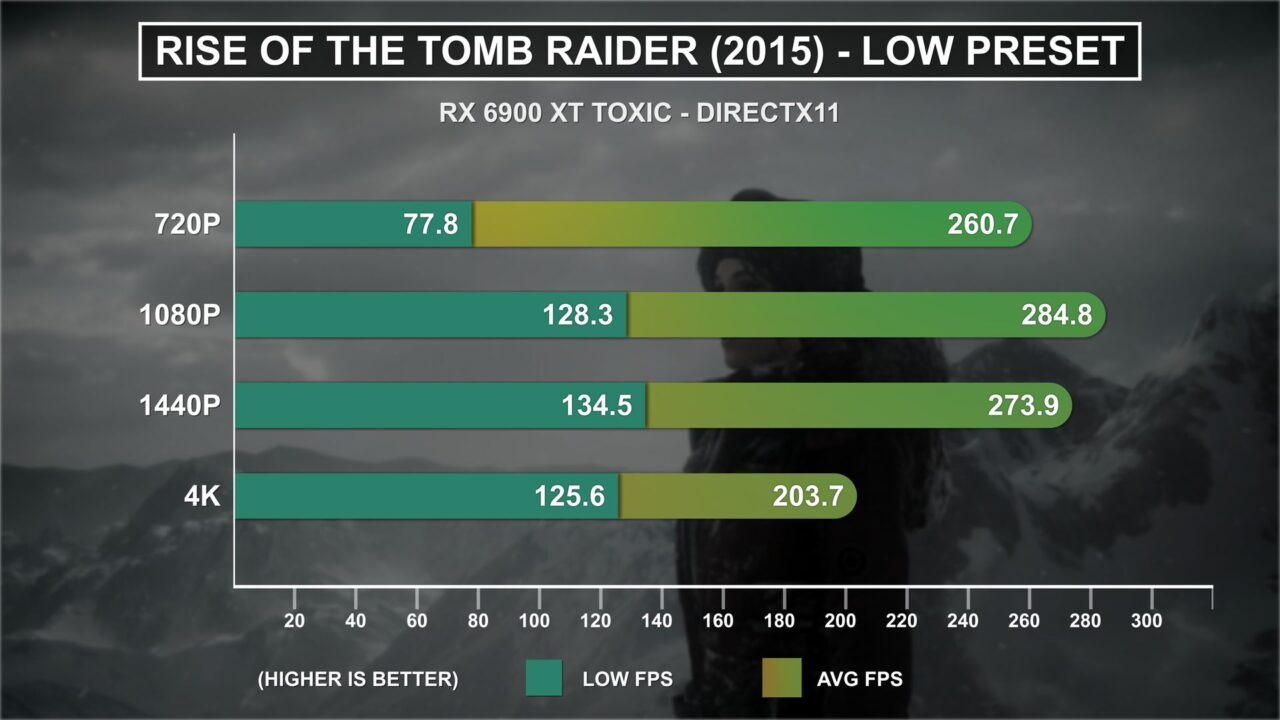
The first game in the lineup that supports both DirectX11 and DirectX12 is 2015’s Rise of the Tomb Raider. I’ve decided to run all tests using both APIs to see how they compare on this card. We can see that when using the Low preset, DirectX11 does run into a CPU limit at 720p, though average and minimum framerates fare well at 1080p and above.
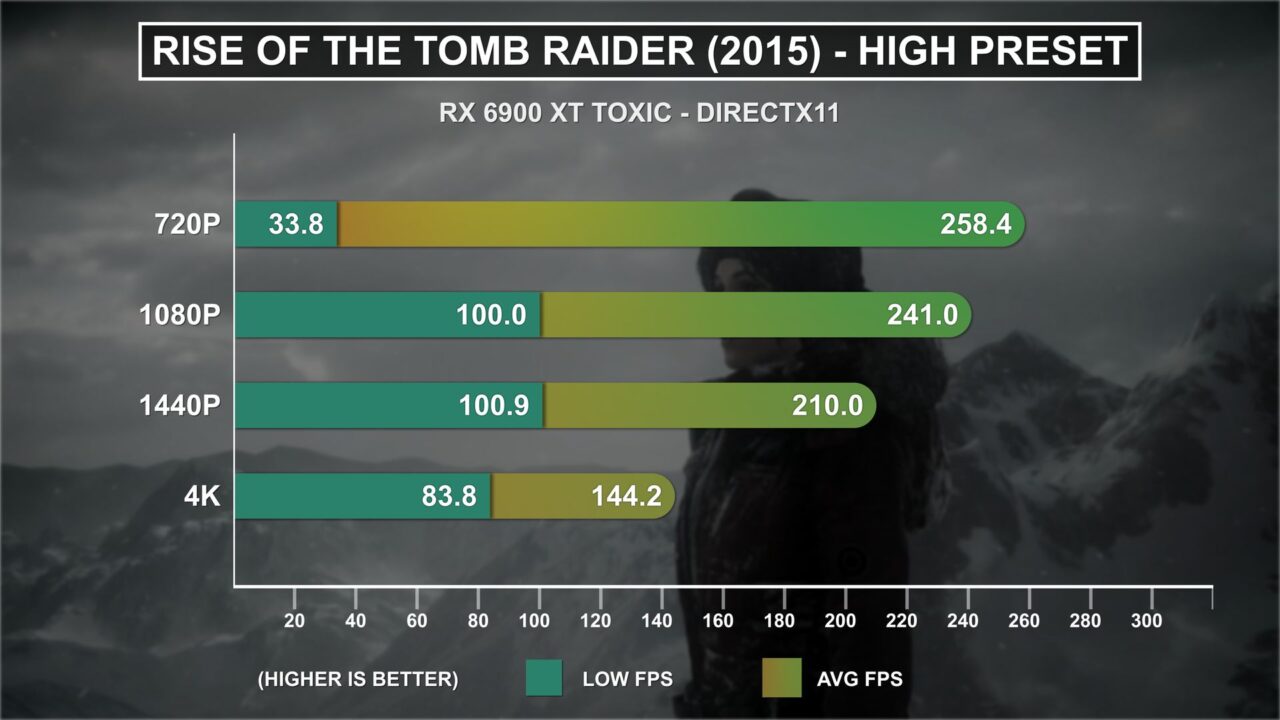
At the High settings, minimum FPS at 720p struggles more, and performance at 4K does see a 29% drop to 144 FPS. These results are still quite respectable, but let’s take a look at how things hold up when switching to DX12.
RISE OF THE TOMB RAIDER (DX12).
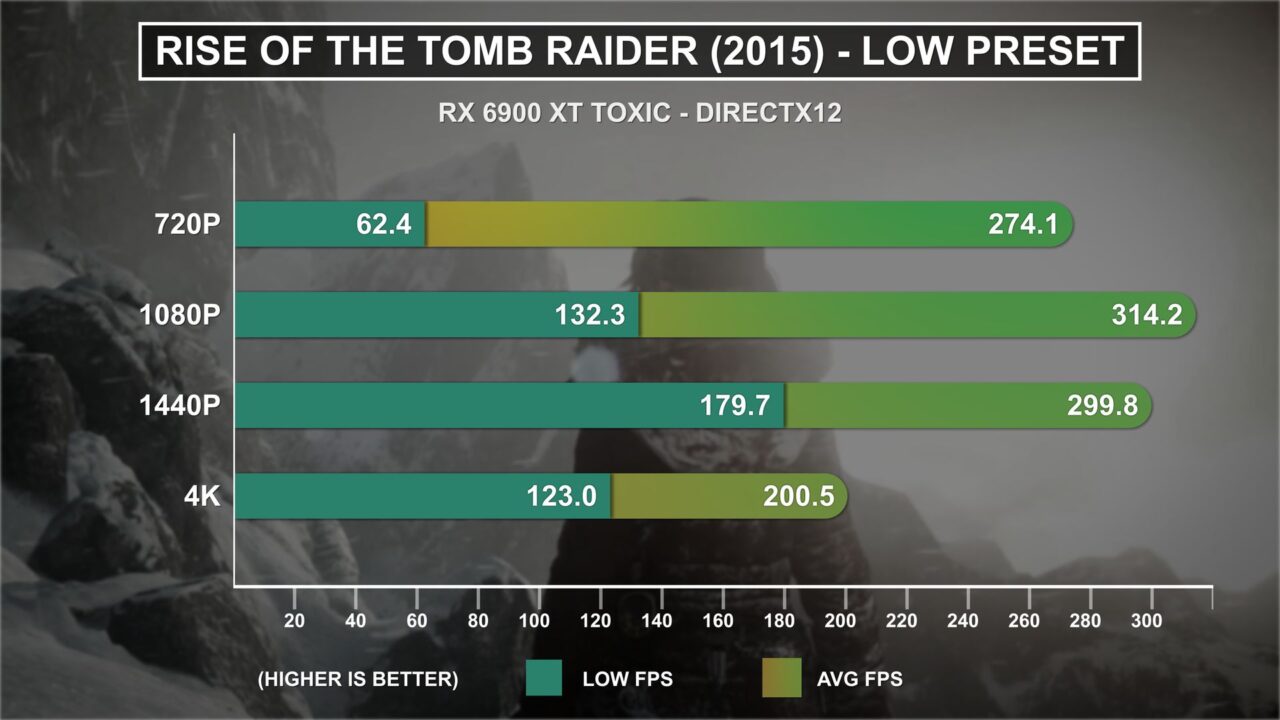
Using the Low preset, we can once again see minimum framerates at 720p struggle, with obvious stuttering occurring in the benchmark run. However, performance at 1080p and 1440p see noticeable improvements to both average and low numbers.
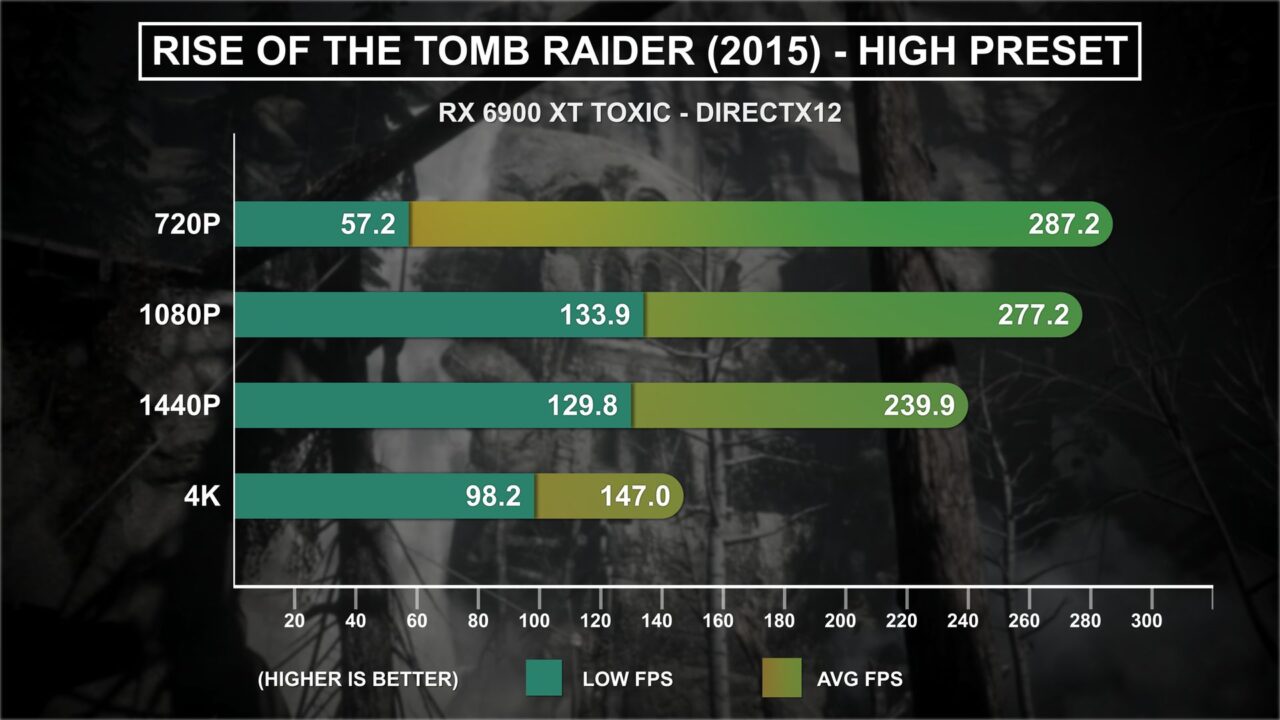
With graphics settings turned up to the High preset, DirectX12’s advantage is most clear. Minimum FPS sees a 37% increase across all 4 resolutions, and averages see a more modest 10% improvement. As we’ll see in later titles, however, DirectX12 does not always benefit the AMD GPU to the same extent as Rise of the Tomb Raider.
CALL OF DUTY BLACK OPS 3.
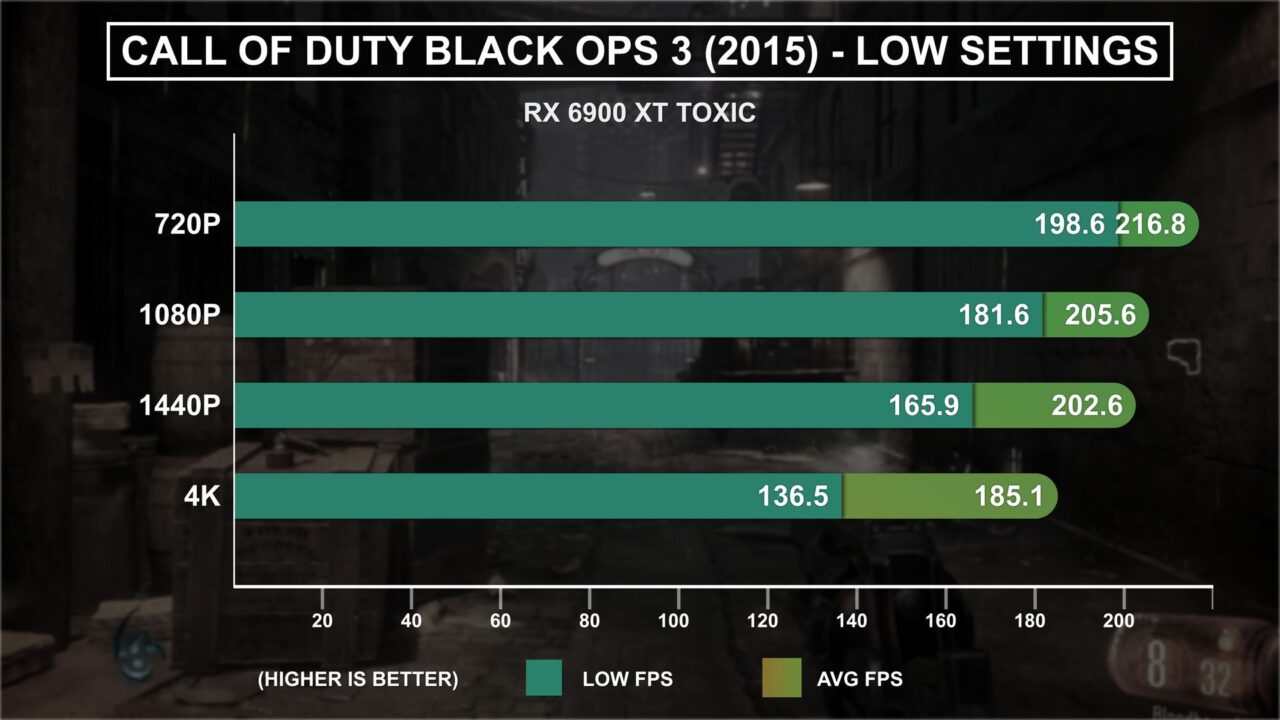
Zombie slaying runs as smooth as a knife through butter using the Low settings in Black Ops 3 with the RX 6900 XT Toxic. Average FPS is a steady 185 with minimum FPS of 136.5 at 4K. FPS is capped around the 200 mark, so even at 720p average FPS is just 217, but lows are also very high at 199 FPS.
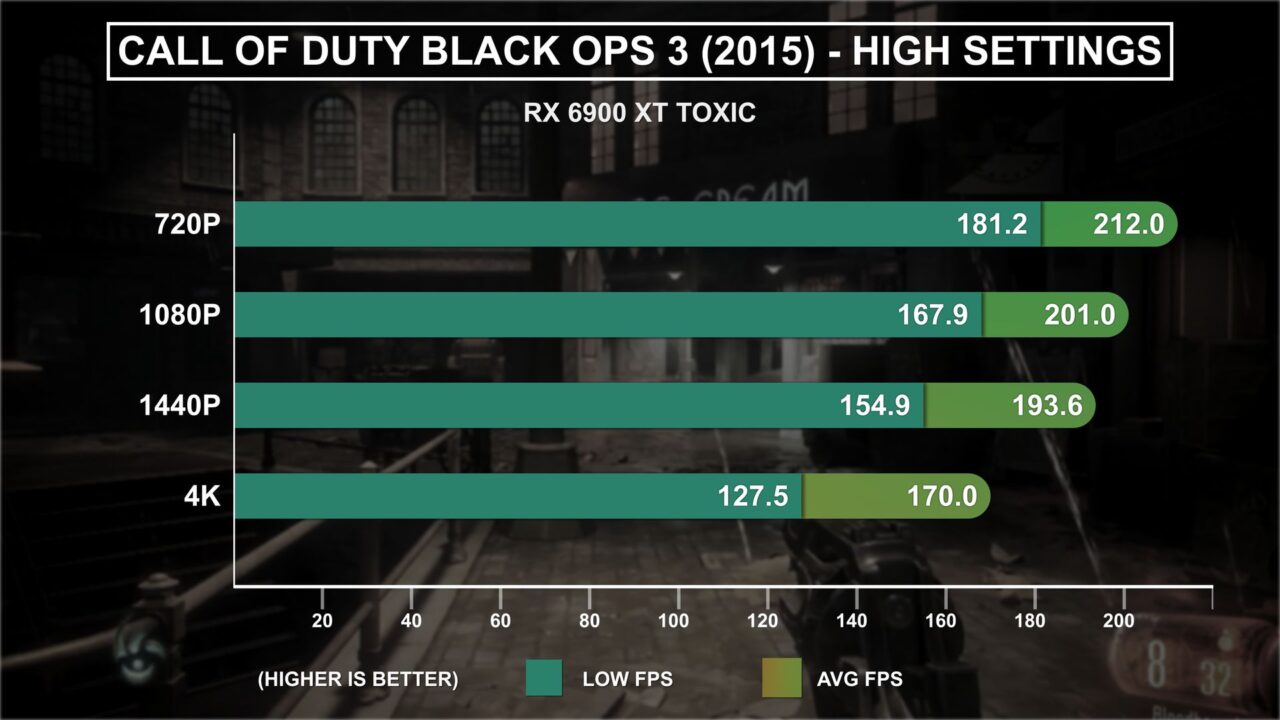
At the High settings the game looks much better, and still runs very smoothly. At 4K averages are still well above the refresh rate of a typical gaming display, and minimums are not far behind.
GRAND THEFT AUTO V.
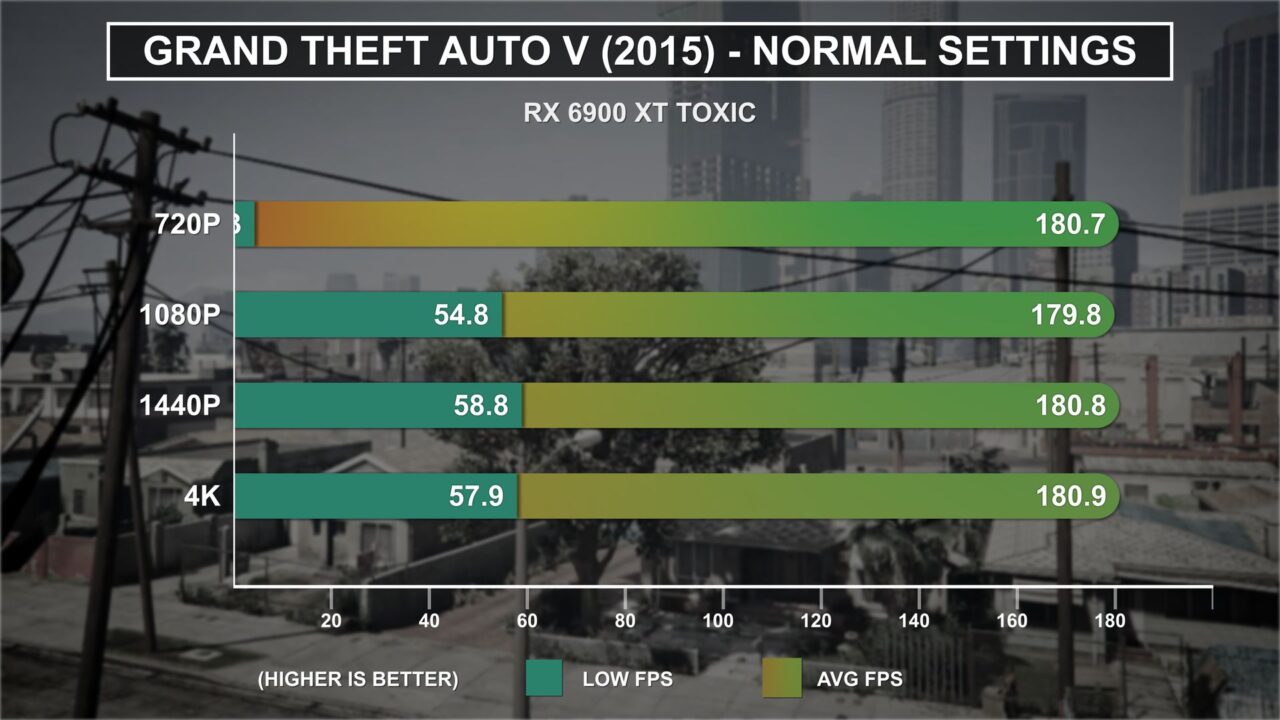
The 2013 game released in 2015, GTA V has a known issue when running at or near the 180 FPS frame limit. Doing so results in significant stuttering, which can be seen even at 4K using the RX 6900 XT at Normal settings.
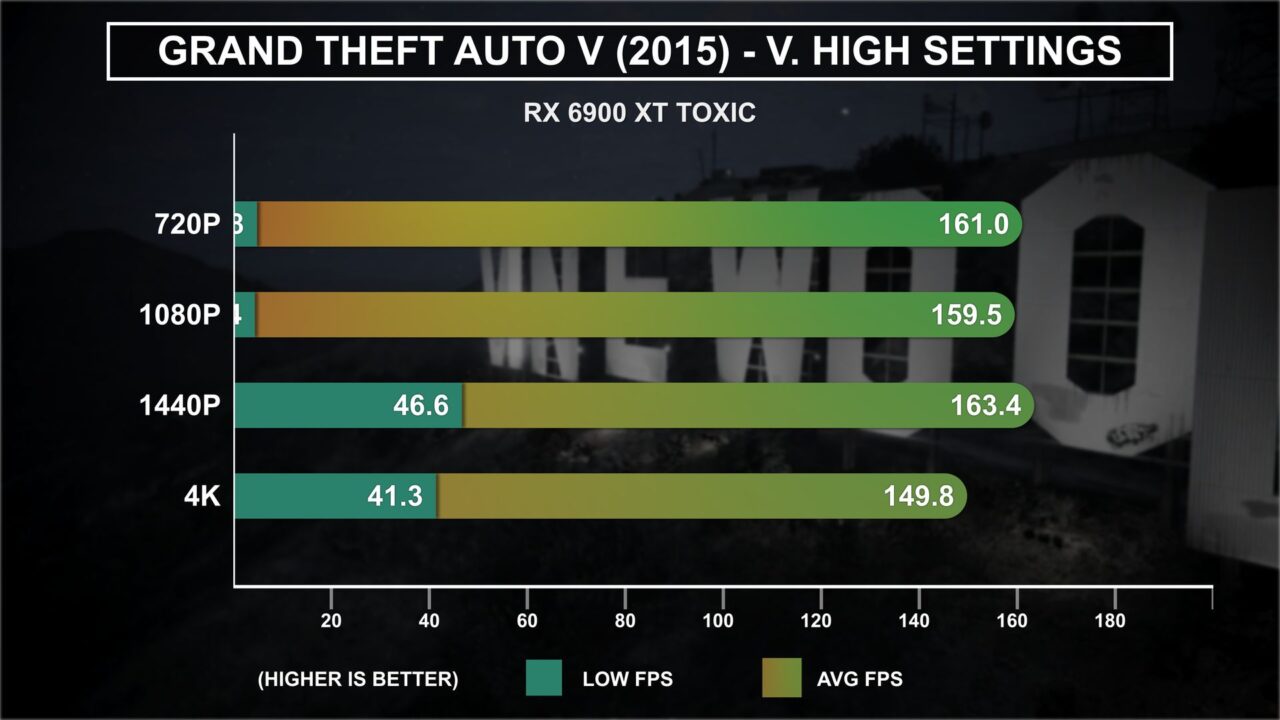
At Very High settings, framerates are still very high causing the minimum FPS to suffer. Thankfully, the game does offer many options to further increase graphics load, including Ultra settings for many of the settings, and a resolution scale to further increase the rendered resolution. Alternatively, an FPS cap in the driver to something like 150 would result in much smoother gameplay.
DEUS MANKIND DIVIDED (DX11).
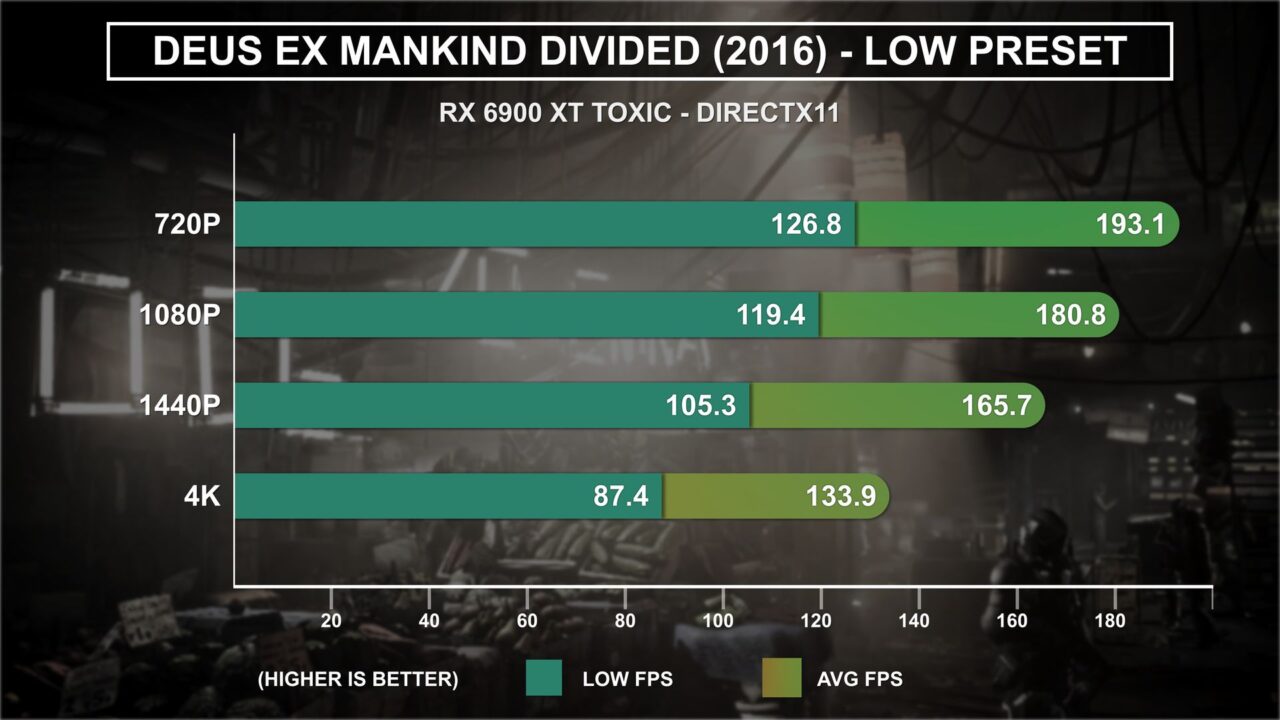
2016’s Deus Ex Mankind Divided was four years old when the RX 6900 XT was released, but this title still proves to be a demanding task even for powerful GPUs. First using the DirectX11 API and the low preset, the RX 6900 XT puts out respectable, if not impressive, performance even at 4K. With 134 FPS on average, the game certainly runs smoothly.
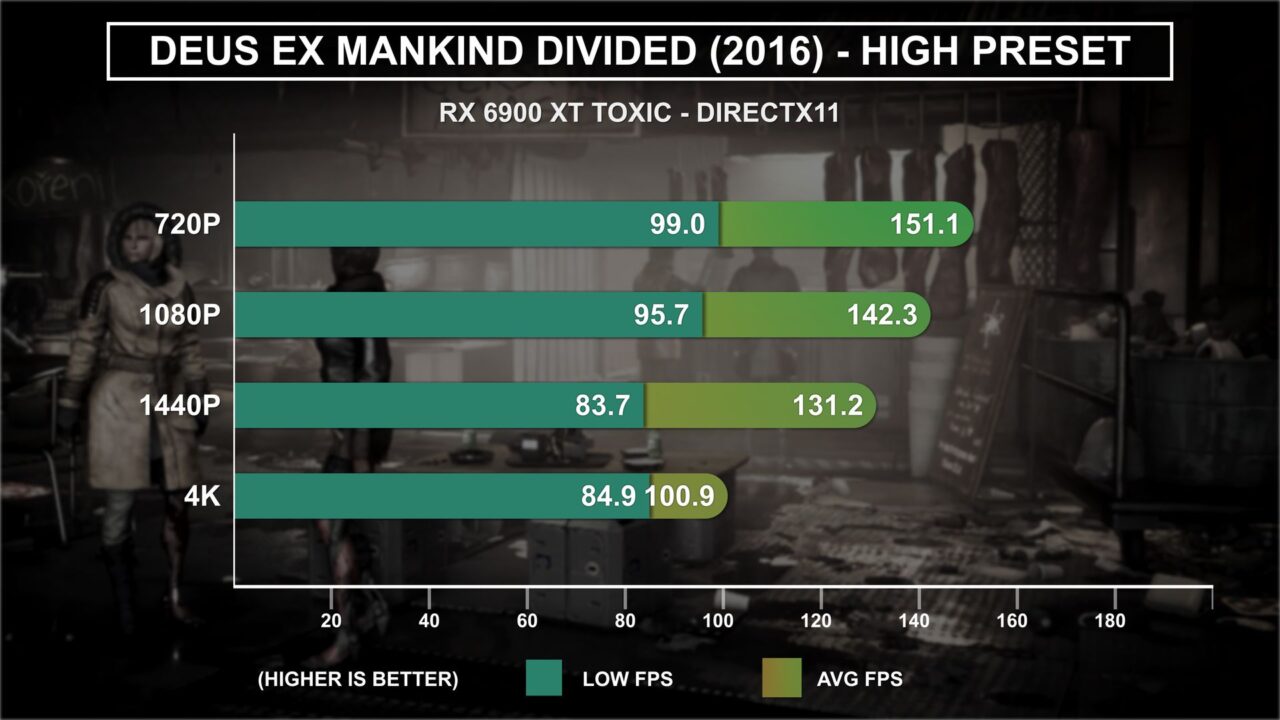
At the high preset, performance does not fall far. Average FPS at 4K stays above 100, just barely.
DEUS MANKIND DIVIDED (DX12).
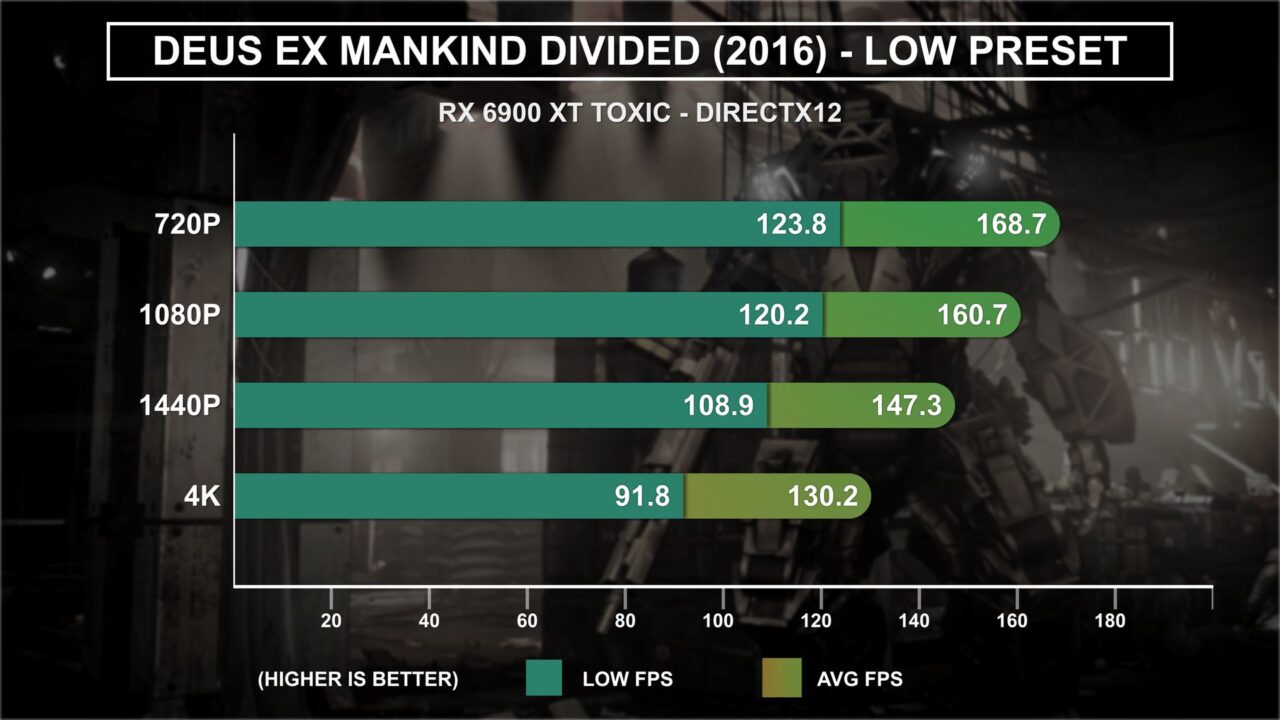
In contrast to Rise of the Tomb Raider’s uplift when switching to DirectX12, Mankind Divided does not react so positively. At the low preset, average FPS falls by 9.4% on average, though minimums see a slight 1.7 % increase.
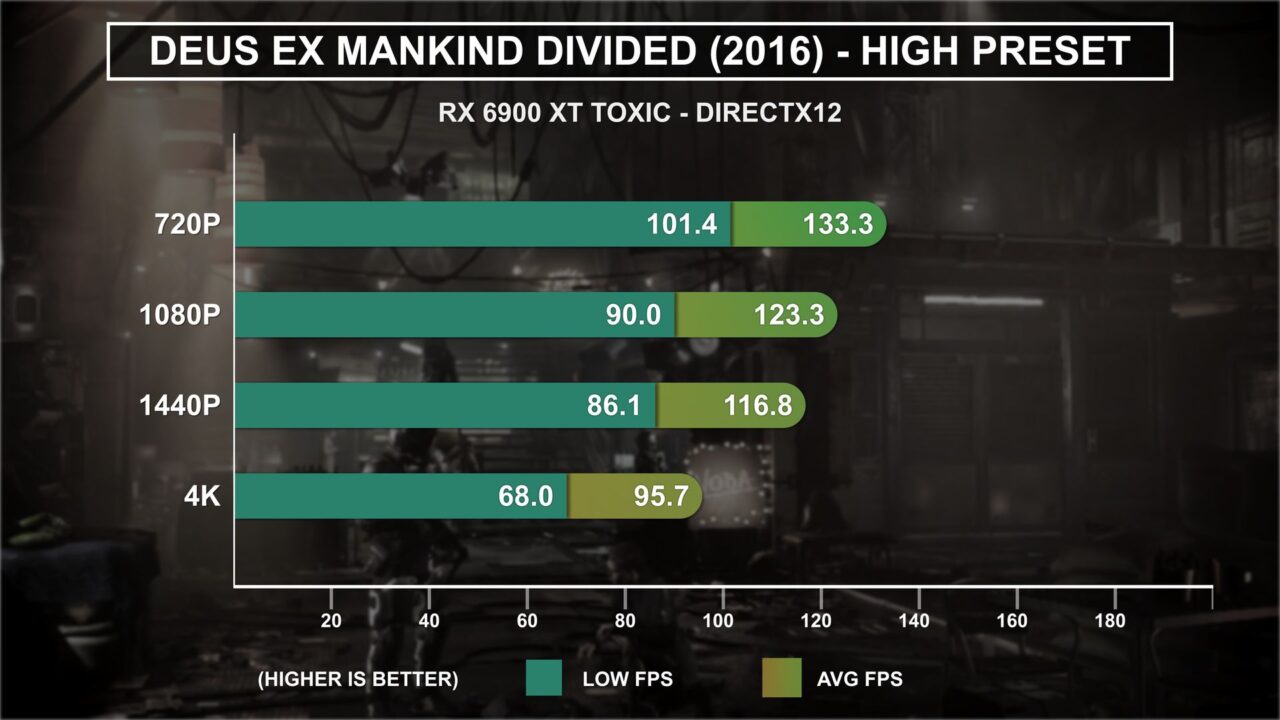
At the high preset, DX12 is decidedly slower than DX11 on the RX 6900 XT. Minimum FPS falls by 5% on average across the 4 tested resolutions, and average FPS figures fall by 10%.
TITANFALL 2.
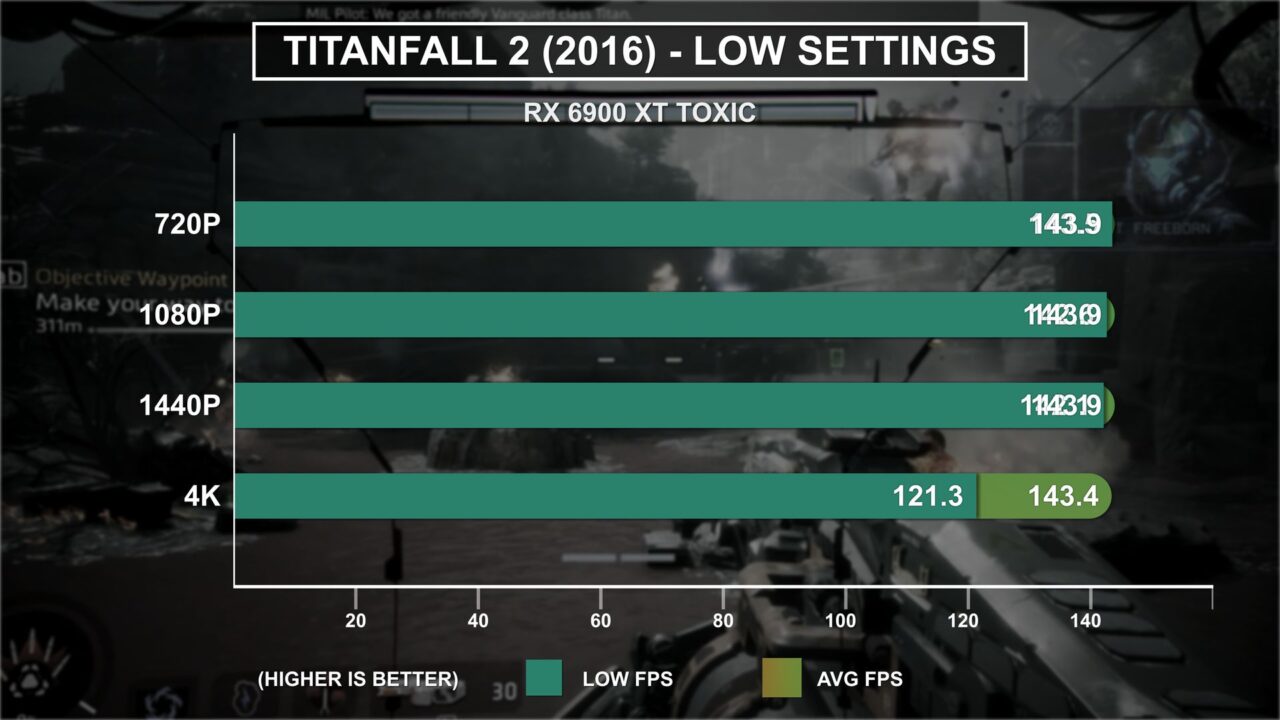
In contrast to Mankind Divided, Titanfall 2 stands no chance against the powerful RDNA 2 GPU. The game has a 144 FPS cap in place, and below 4K, average and minimum FPS stay steadfastly stuck to the limit. At 4K, the results show a drop in minimums to 121.3, but I suspect that was a strange hiccup in the run.
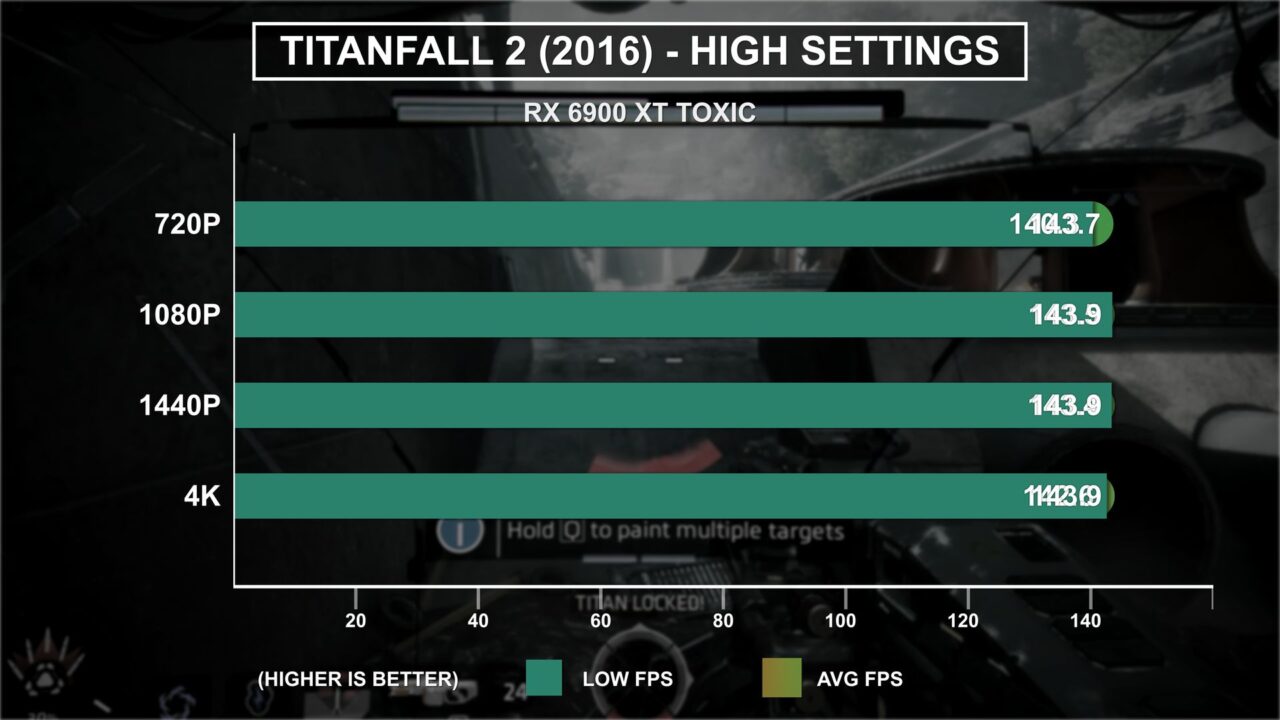
The high settings again sees the 144 FPS frame limit holding the RX 6900 XT back.
TOM CLANCY’S THE DIVISION (DX11).
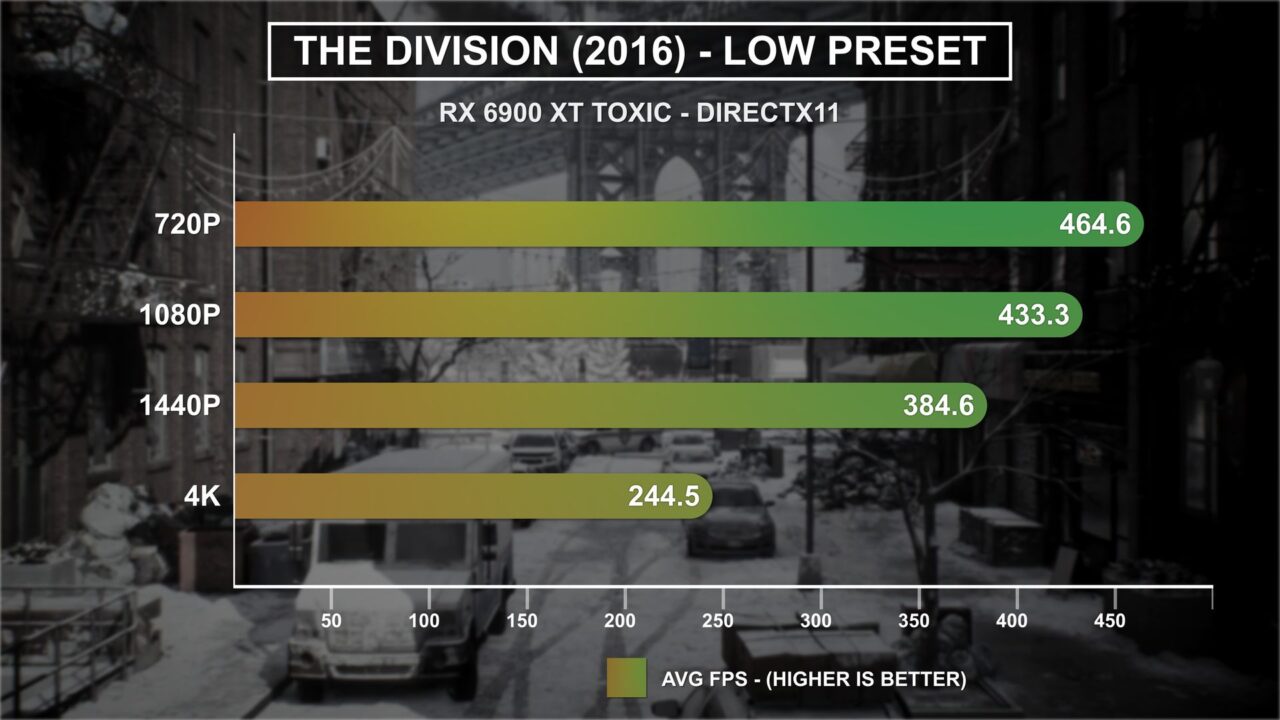
Tom Clancy’s The Division is another game that features both DirectX11 and DirectX12 support. Naturally, I’ve taken it upon myself to test using both APIs. Since this game’s built-in benchmark does not report low FPS results, I don’t have that data. But the average FPS results will tell a sufficient story here. The low preset at DX11 sees very high FPS, scaling down predictably at 4K.
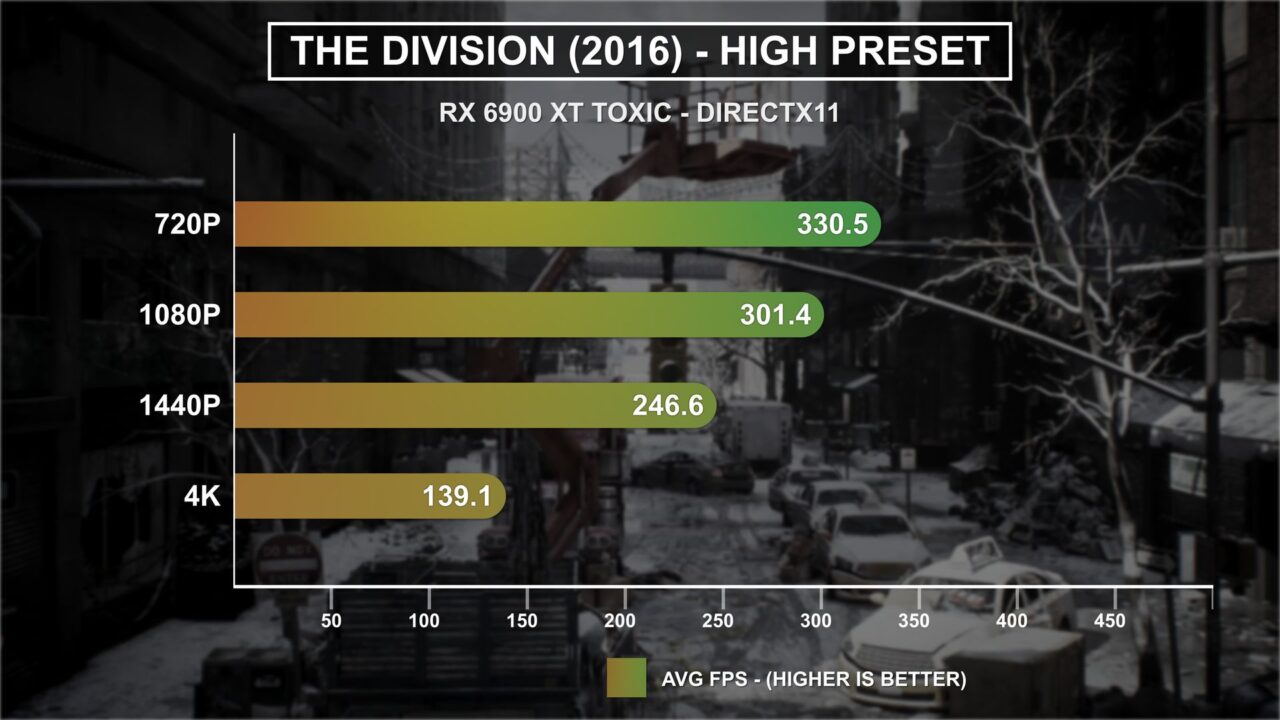
Switching to the High preset does put much higher load on the GPU, we now see average FPS at 4K drop by 43%. Across all 4 resolutions performance drops by 35% on average going from low to high using DirectX11.
TOM CLANCY’S THE DIVISION (DX12).
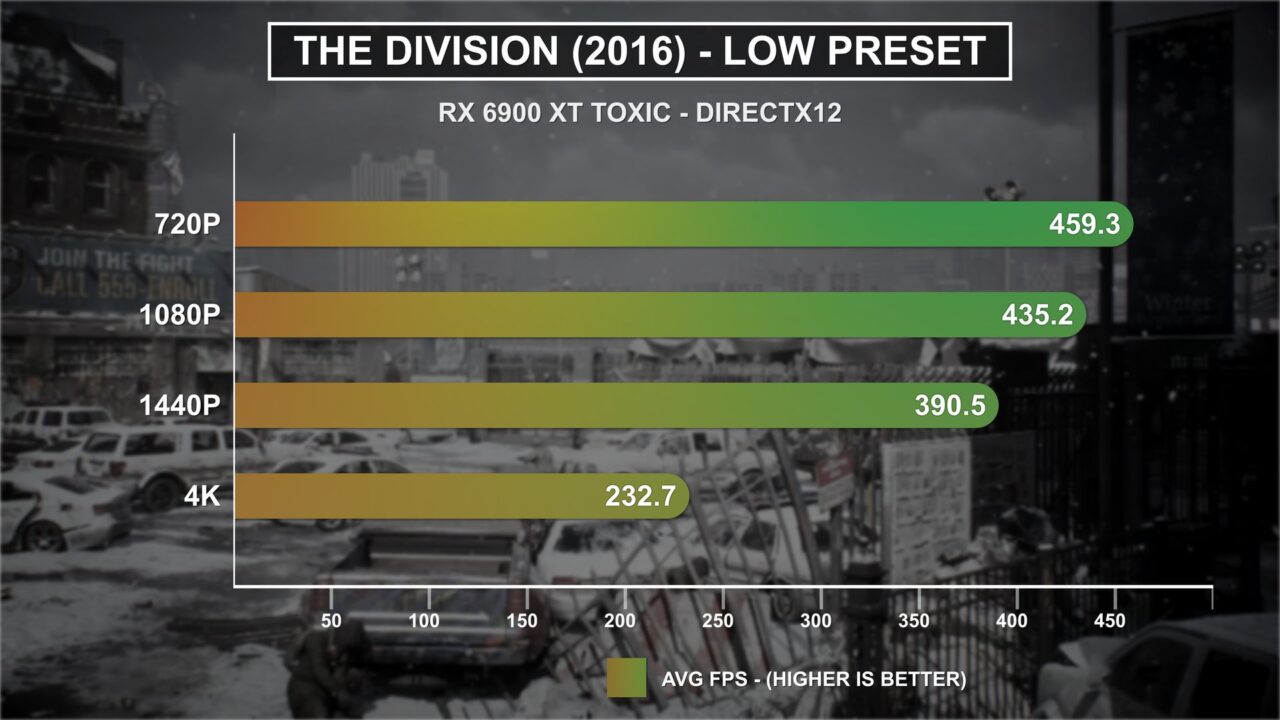
Again we see DX12 result in slightly lower performance compared to DX11. Using the low preset, performance dropped by 5% at 4K.
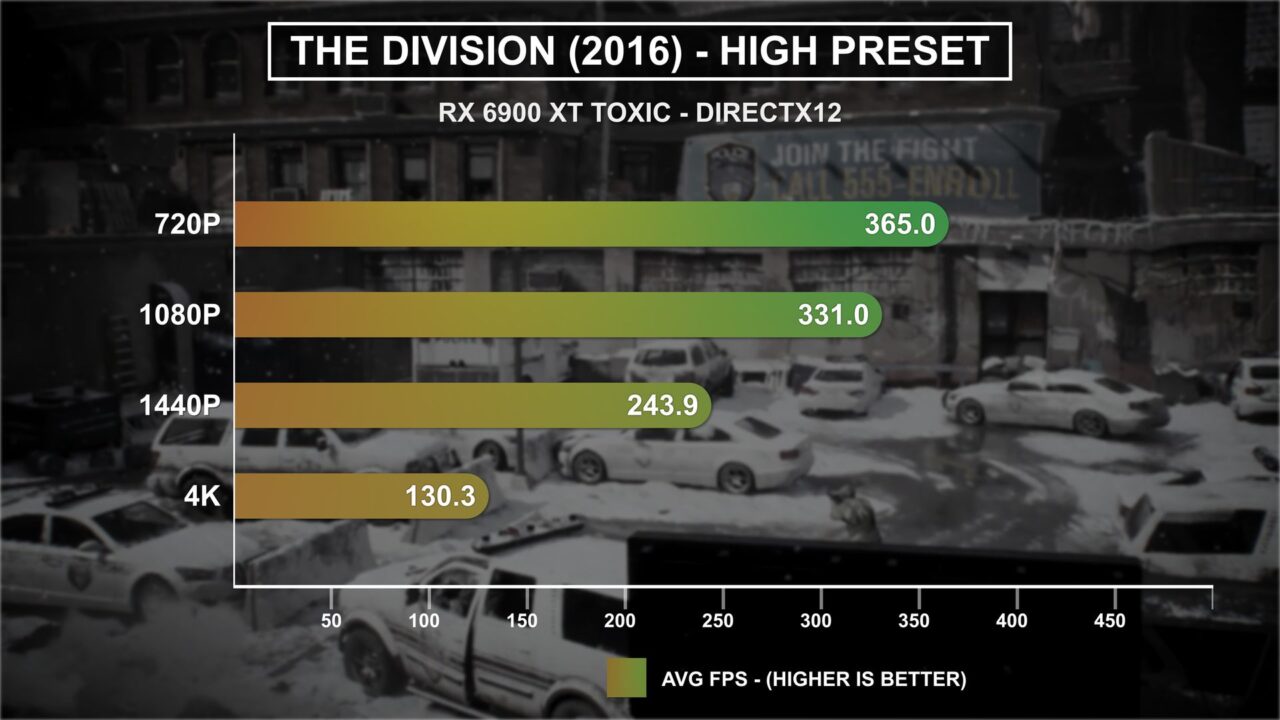
The high preset was more mixed comparing DX11 to DX12. At 720p, average framerate went up by 10% from 330 to 365, but performance at 4K went down by 6%. Neither API resulted in noticeable stuttering in my testing, but it would appear performance does improve when CPU limited at the low 720p resolution. This may be important to gamers on less powerful CPUs, but the CPU-bound improvements are observed over 300 FPS using the Ryzen 5600. For the benefits to be seen at a more typical 60 FPS, the CPU would need to be much weaker. Something like an i5 4670k or slower, but this would need further testing.
MIDDLE EARTH SHADOW OF WAR.
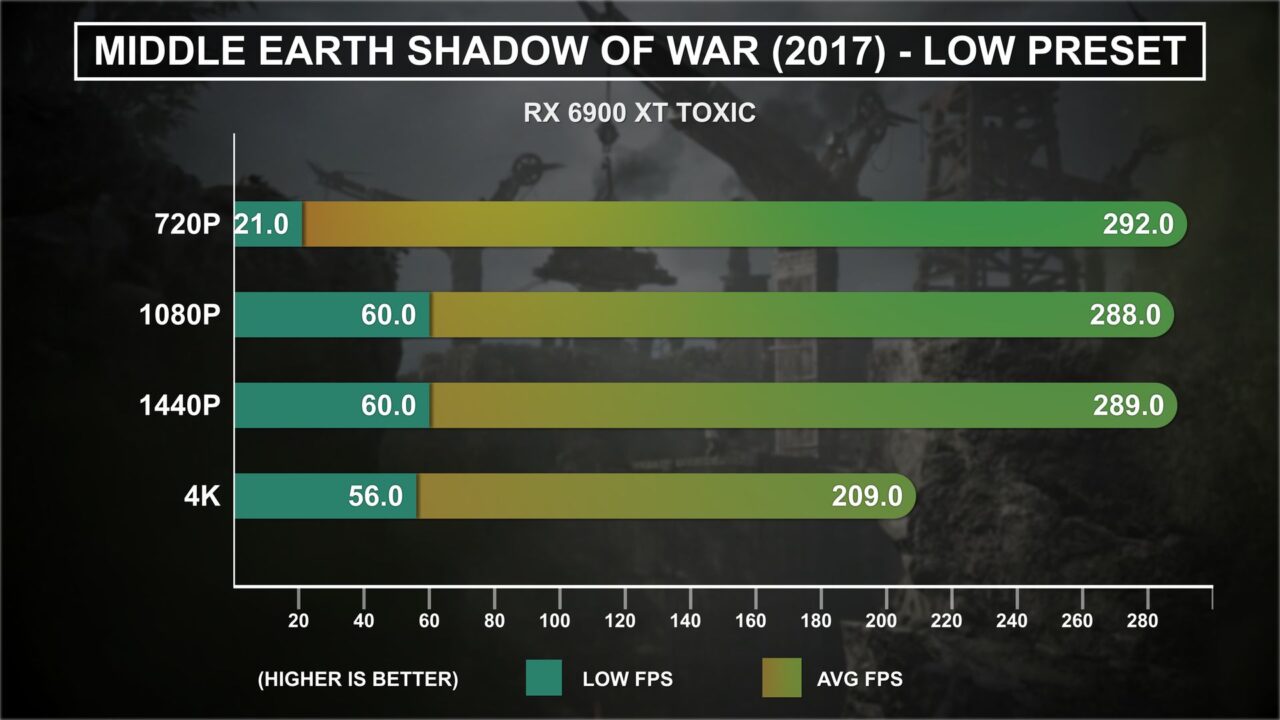
Shadow of War again sees the RX 6900 XT struggling with low FPS performance due to extremely high averages. At the low preset, FPS is limited around the 300 mark, but noticeably stuttering results in fairly low minimums.
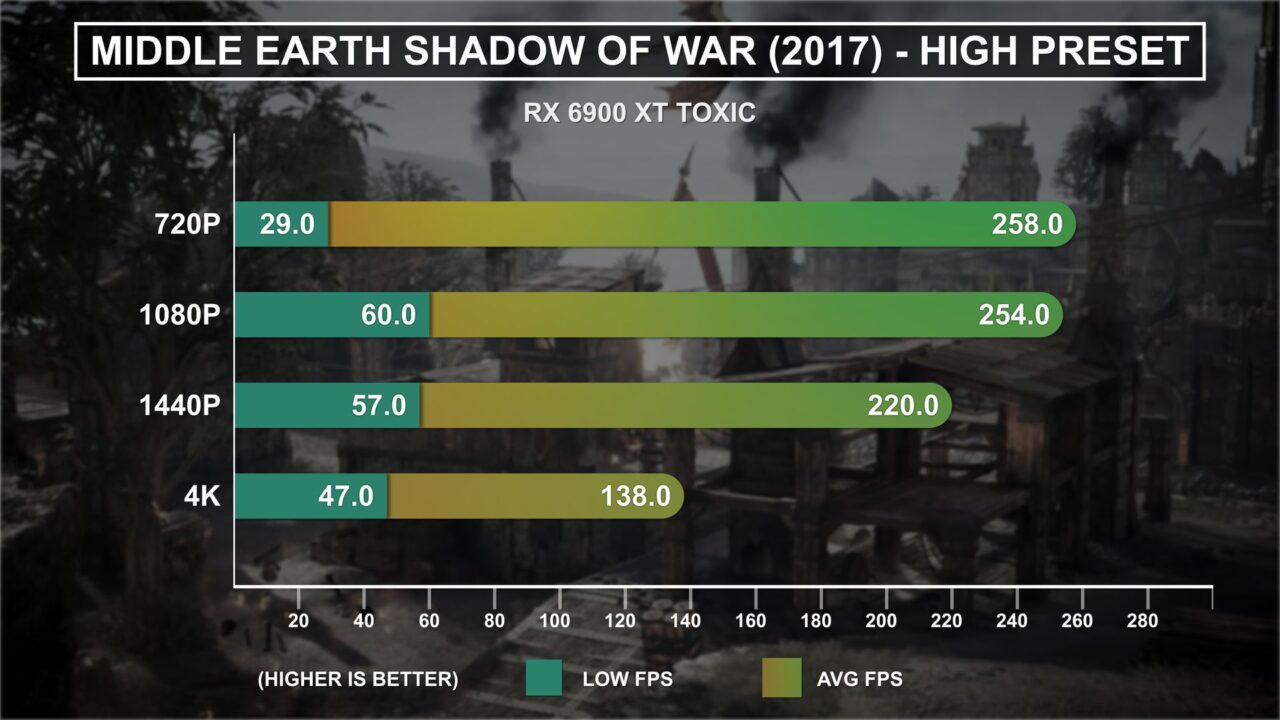
Switching to the high preset doesn’t see much decline to 720p and 1080p performance, but averages at 4K do fall by 34% from 209 to 138. Minimum FPS is still in the sub-60 FPS territory, though stuttering is significantly improved using the high preset.
SPACE ENGINEERS.
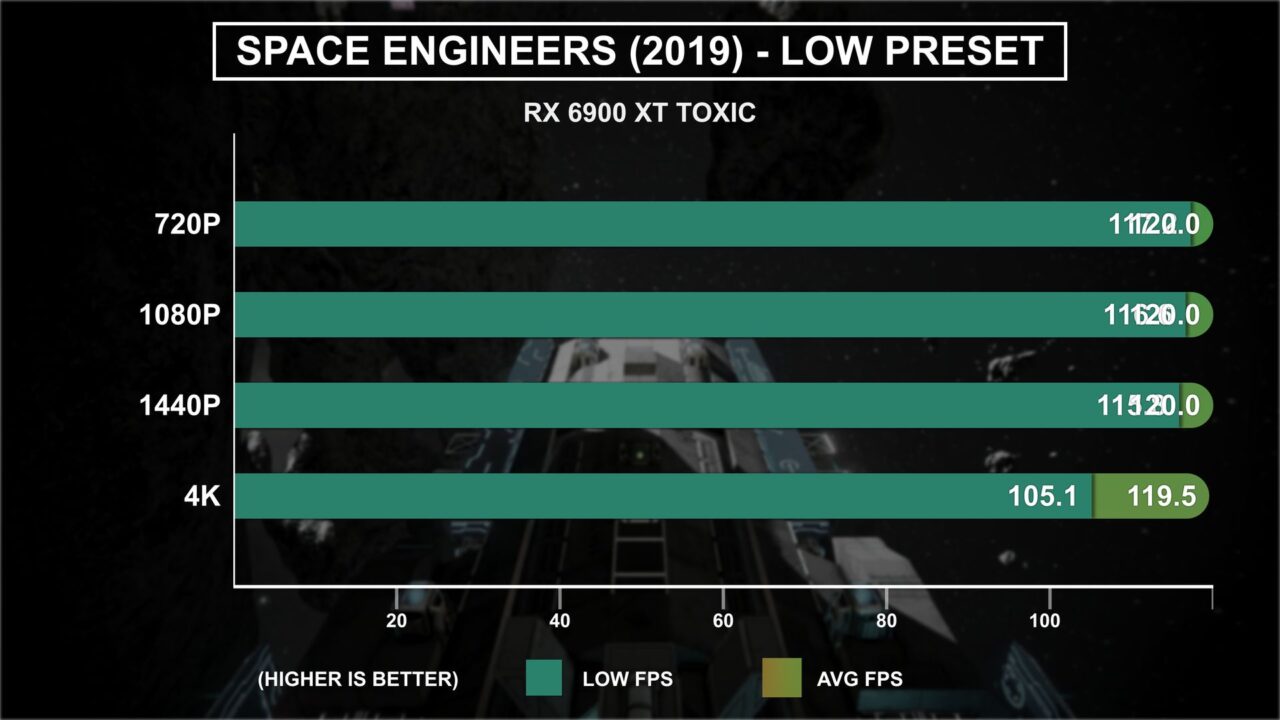
The next title in the game testing lineup is the indie sandbox, Space Engineers. This game does have a framerate cap at 120 FPS, and using the low preset the RX 6900 XT has no trouble. Only at 4K do the low FPS figures begin to fall below the cap. It should be noted that performance of this game can vary greatly based on what is in the world, and what is in the current view. The area used for testing is the Sparks of the Future scenario, which should be representative of the worst case for most players.
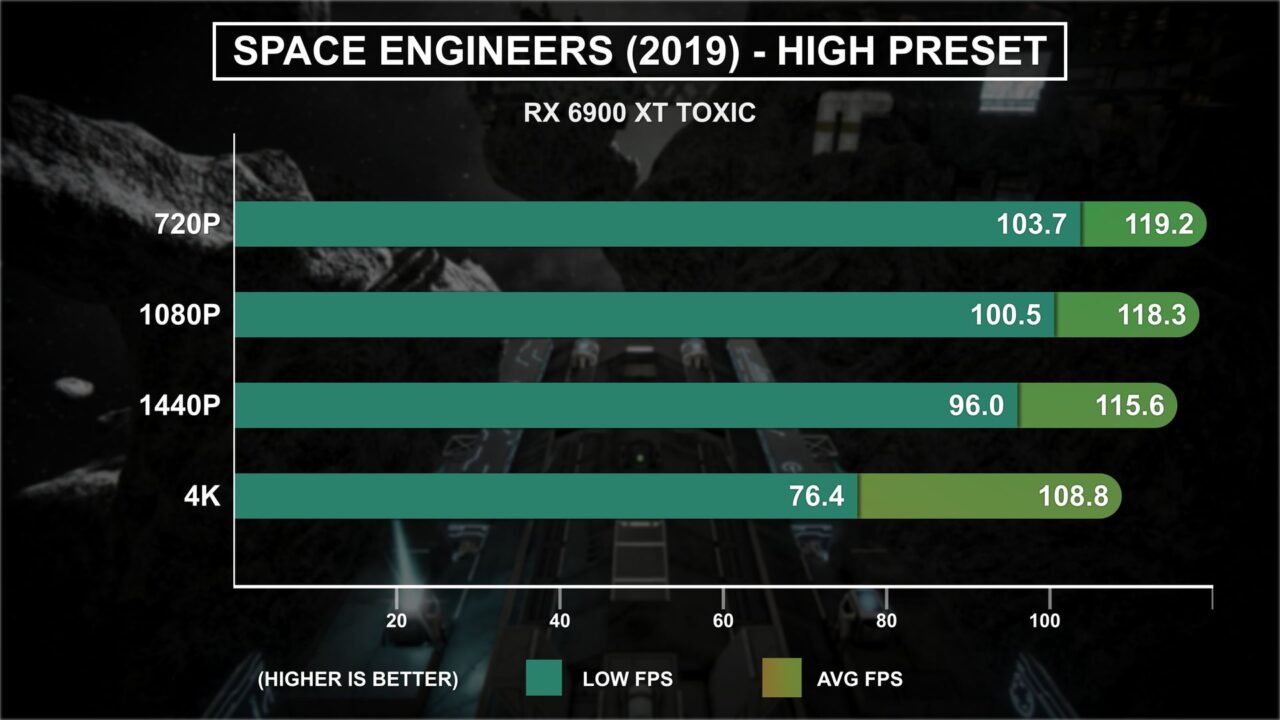
The Big Navi’s 16GB frame buffer is well-appreciated when using the high preset, and allows the game to still run quite smoothly. Average FPS results stay quite high, though the low FPS figures do fall some. Still, the minimum framerate of 76 at 4K did allow for a pleasant experience.
RESIDENT EVIL 2 REMAKE (DX11).
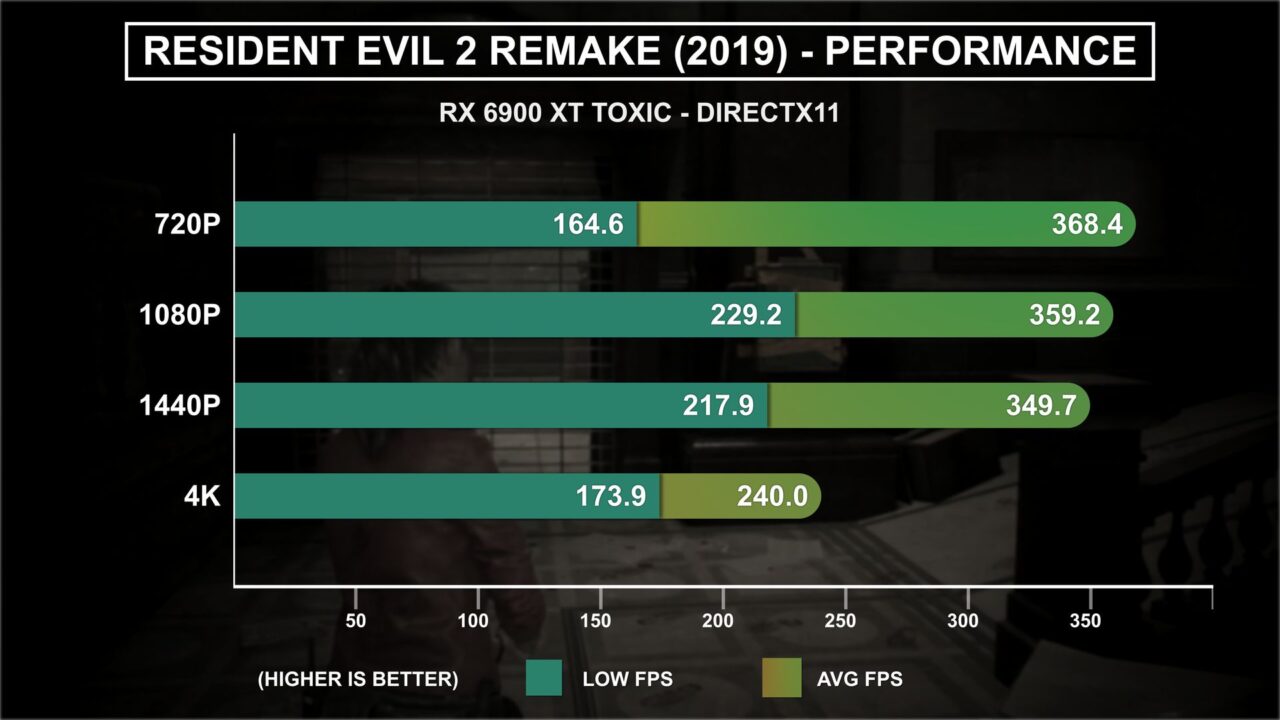
The next game in the lineup that features both DX12 and DX11 is Capcom’s 2019 remake of Resident Evil 2. In DX11 using the “Performance Priority” preset, the RX 6900 XT is clearly running into a limit at the lower resolutions. Though, at 4K an average of 240 FPS and low of 174 FPS is quite strong.
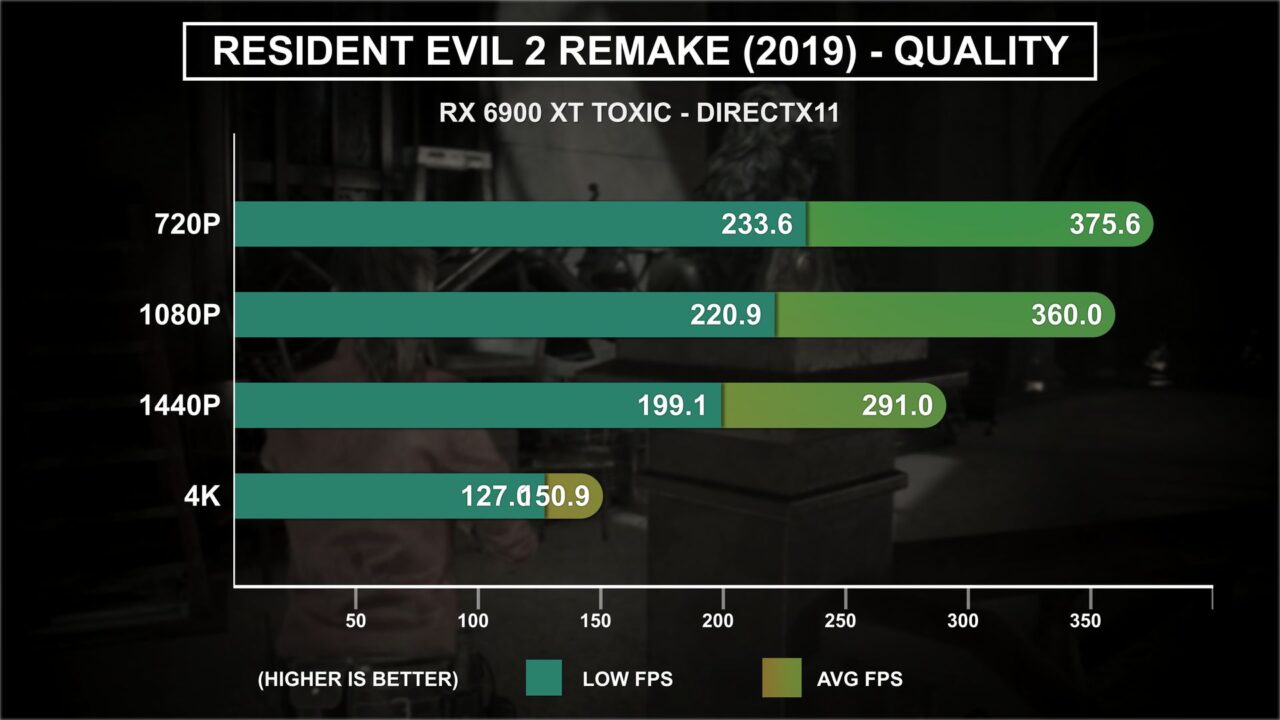
Using the “Graphics Priority” preset, the GPU sees more load at 1440p and 4K. Performance at the highest resolution does slide by 37% to 151 FPS on average with the low FPS result at 127 FPS.
RESIDENT EVIL 2 REMAKE (DX12).
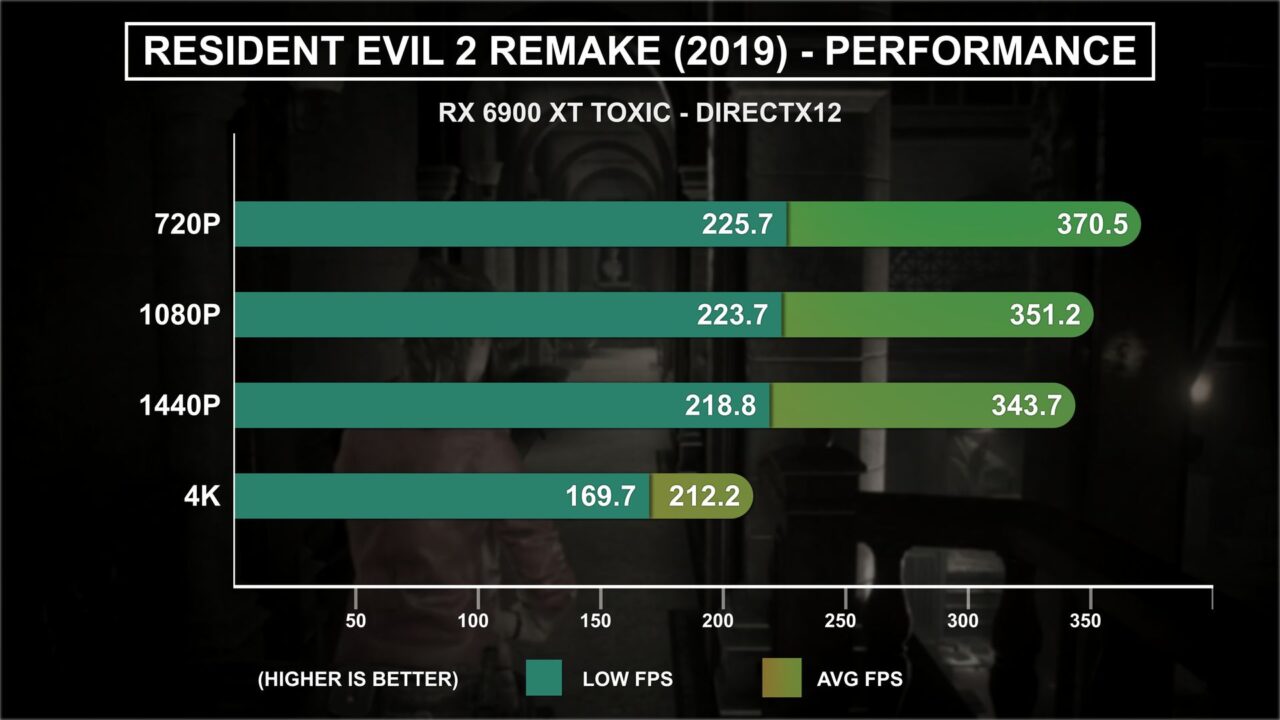
Switching to DX12 at the performance preset again sees a slight reduction to performance at the most GPU-bound resolution of 4K. Here average FPS fell from 240 to 212, and low FPS fell from 174 to 170. Low FPS performance did see a large boost at the very low 720p resolution, going from 165 FPS to 226 FPS for a massive 37% improvement.
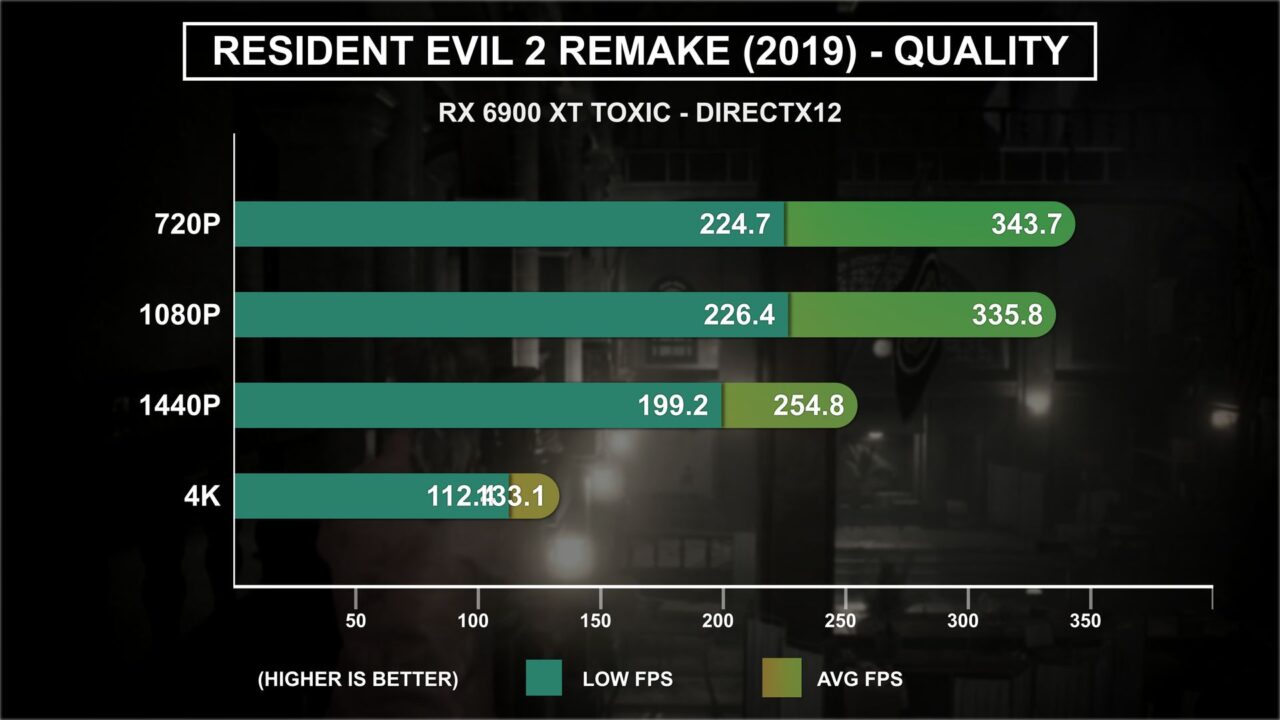
When using the “Graphics Priority” preset, however, DX12 saw an average drop in performance of 10% to average FPS across all resolutions, and an 11% drop to minimum FPS at 4k.
CYBERPUNK 2077.
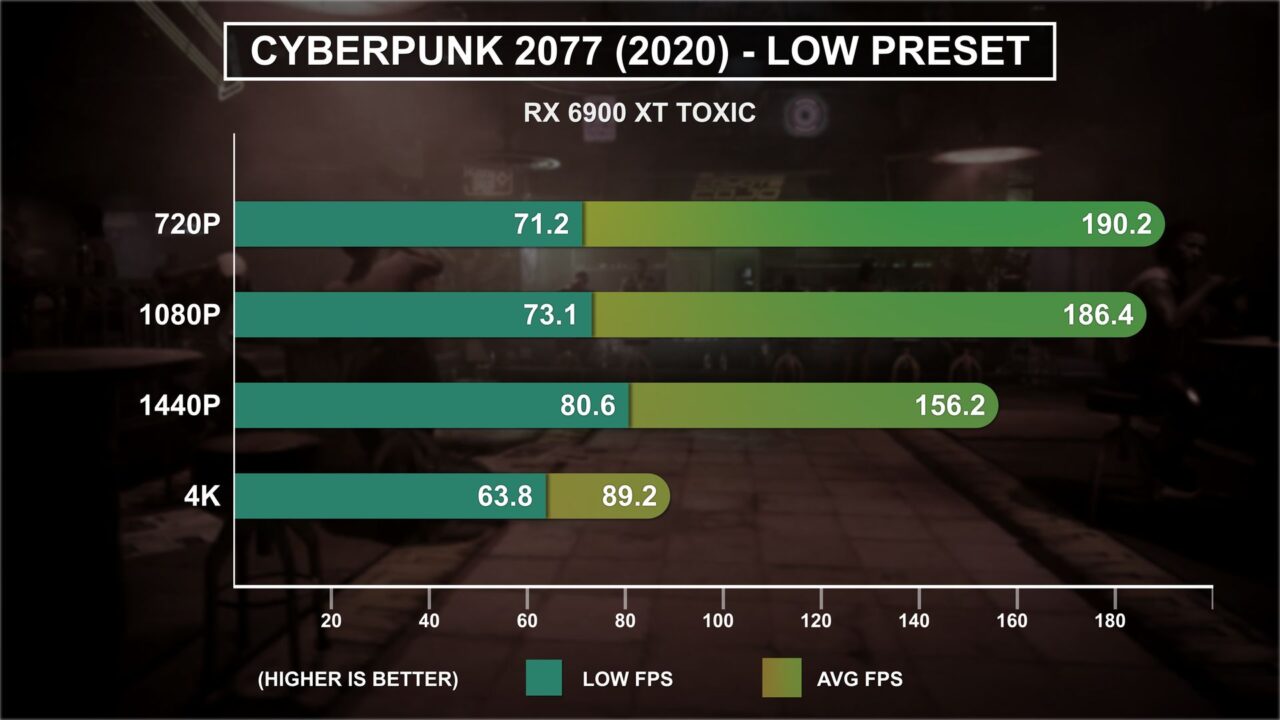
The first game that begins to really challenge the RX 6900 XT is 2020’s Cyberpunk: 2077. Here I am testing the latest version of the game that features FSR 2 support, but for testing I have deliberately disabled it for all tests, as I would with DLSS if I was testing an RTX GPU. In real-world use I would recommend using FSR, but since image quality is subjective I want to test using native resolution. Using the low preset, performance at 1440p and below is more than playable. Average and low FPS figures at 4K are still above 60, though do not bode well for performance with the high preset.
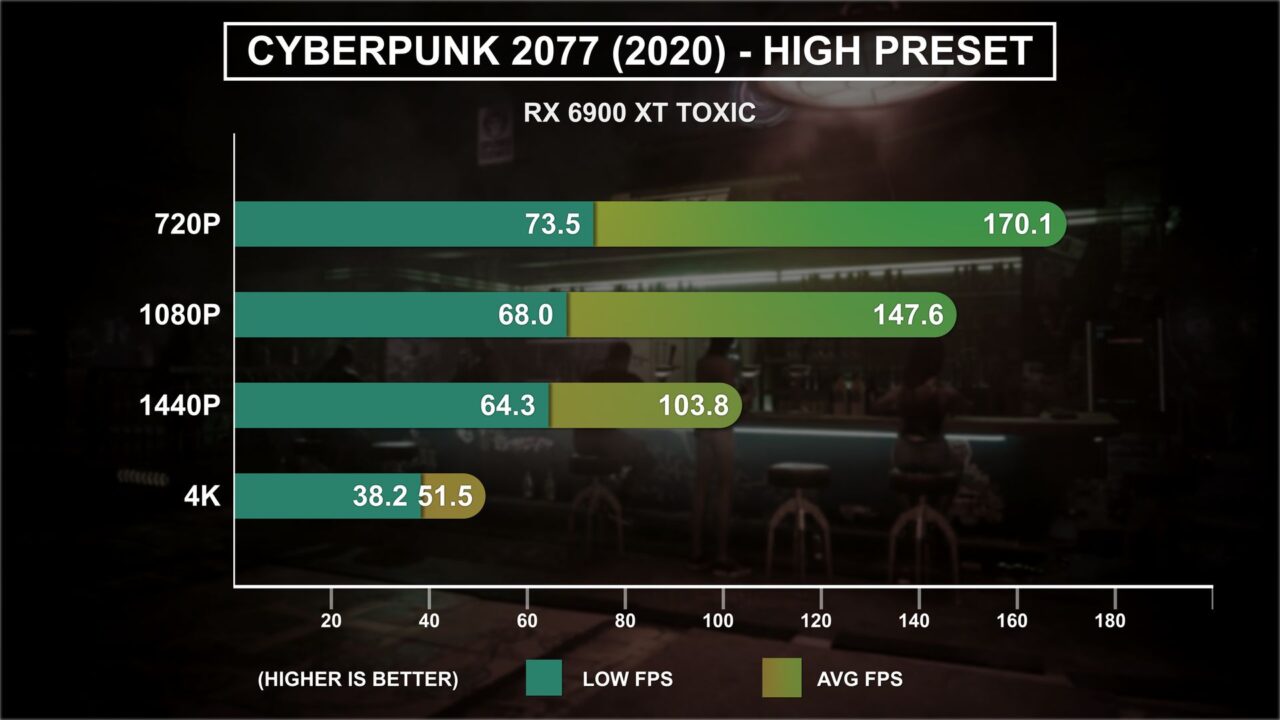
Predictably, performance using the high preset does take a big hit. Framerates at 1440p and below are still very good, but with only 51 FPS on average and minimums of 38 FPS, I wouldn’t give the RX 6900 XT a green light for Cyberpunk at 4K high settings. Still, image quality is very good and with a quality variable-refresh-rate display it could be a pleasant experience.
WATCH DOGS LEGION (DX11).
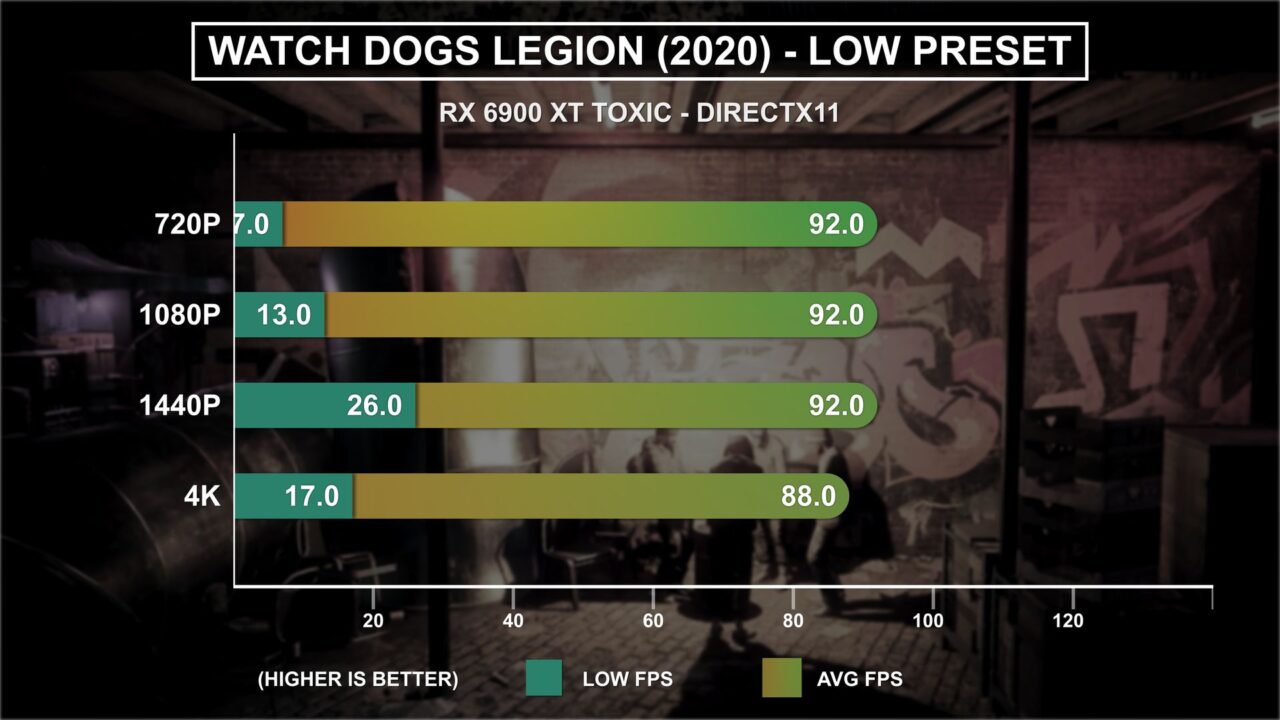
The fifth and final game tested that supports both DX11 and DX12 APIs, Watch Dogs: Legion tested using the low preset in DX11 shows an extreme CPU limitation using the Ryzen 5600. Low FPS figures are quite low, and serious stuttering could be seen in the test run even at 4K.
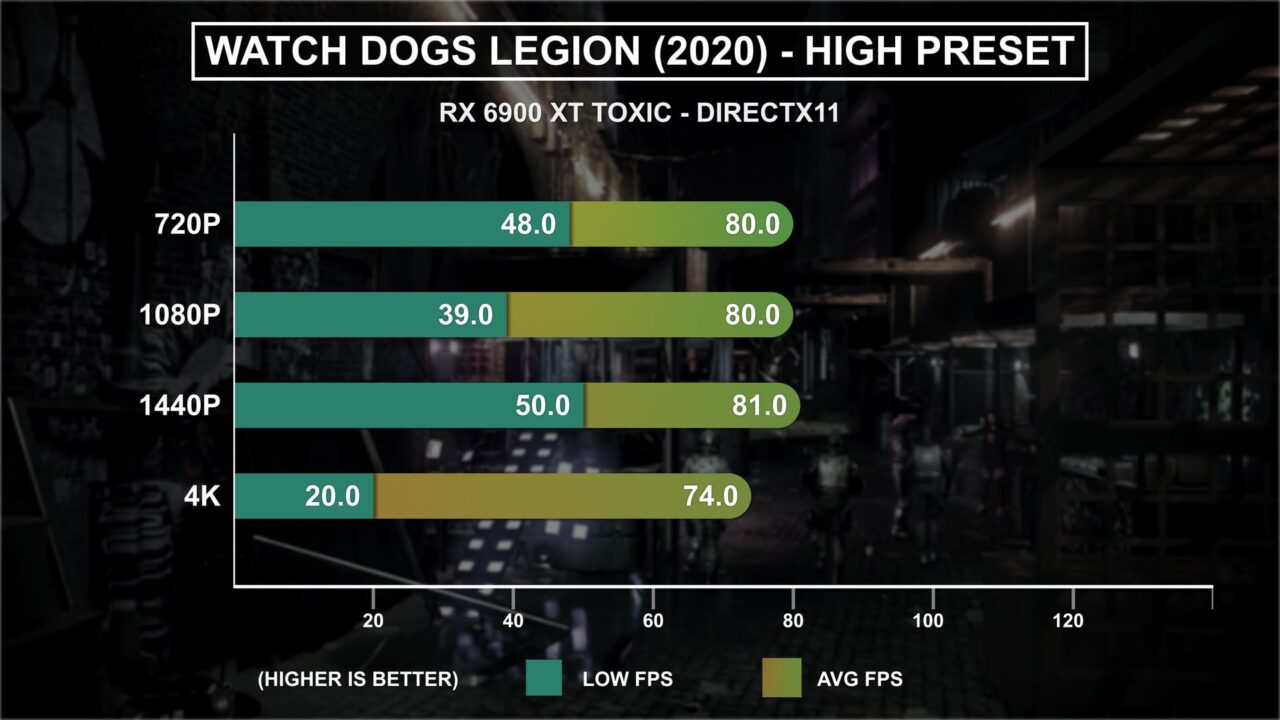
Switching to the high preset eases the CPU limit some, though as we can see in the results at the lower resolutions, performance is still heavily CPU-bound below 4K. Still, Big Navi’s 74 FPS on average at 4K high settings is rather impressive in the demanding title.
WATCH DOGS LEGION (DX12).
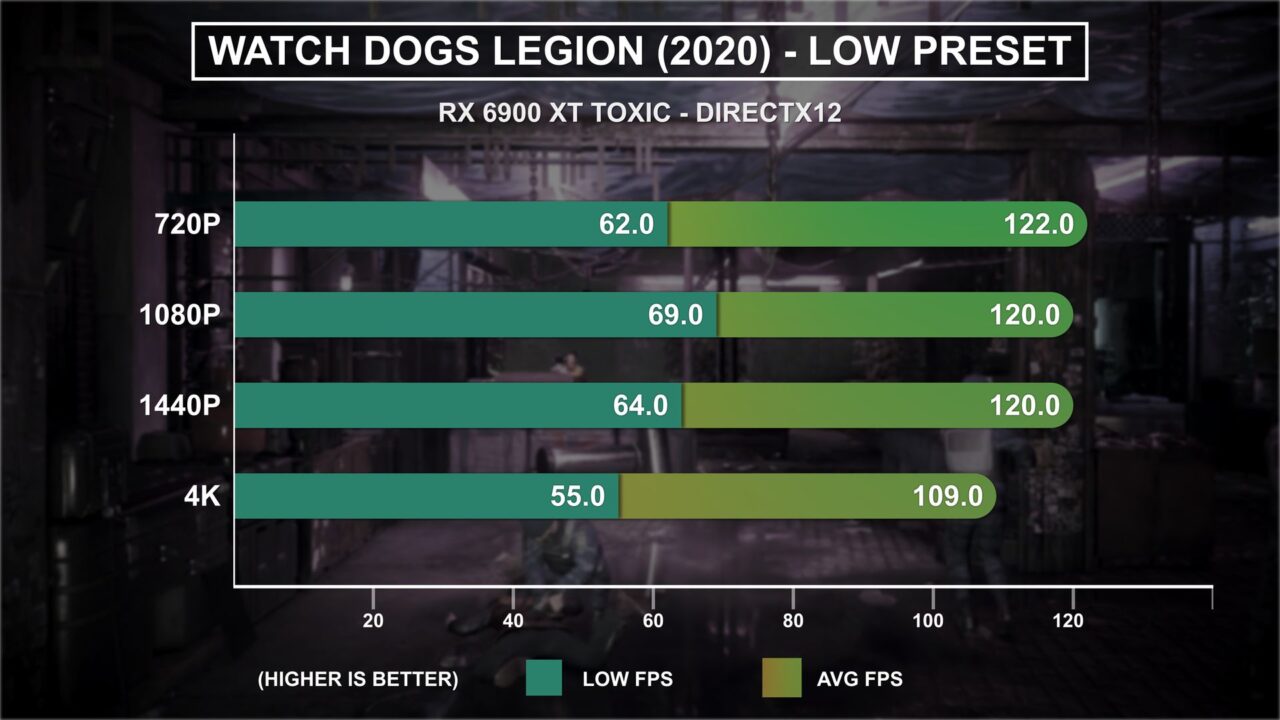
Testing with the DX12 API and low settings see a massive improvement to low FPS figures across all four resolutions. At the lowest resolution of 720p, DX12 raised the minimum FPS result from just 7 FPS, to 62 FPS; a 785% increase. Overall, minimum FPS results increased by 396%, and average FPS increased by 29%. Given the limited spread of results from 4K to 720p, it’s clear that the Ryzen 5600 is still a limit in this title, though DX12 does a much better job of leveraging its 6 cores.
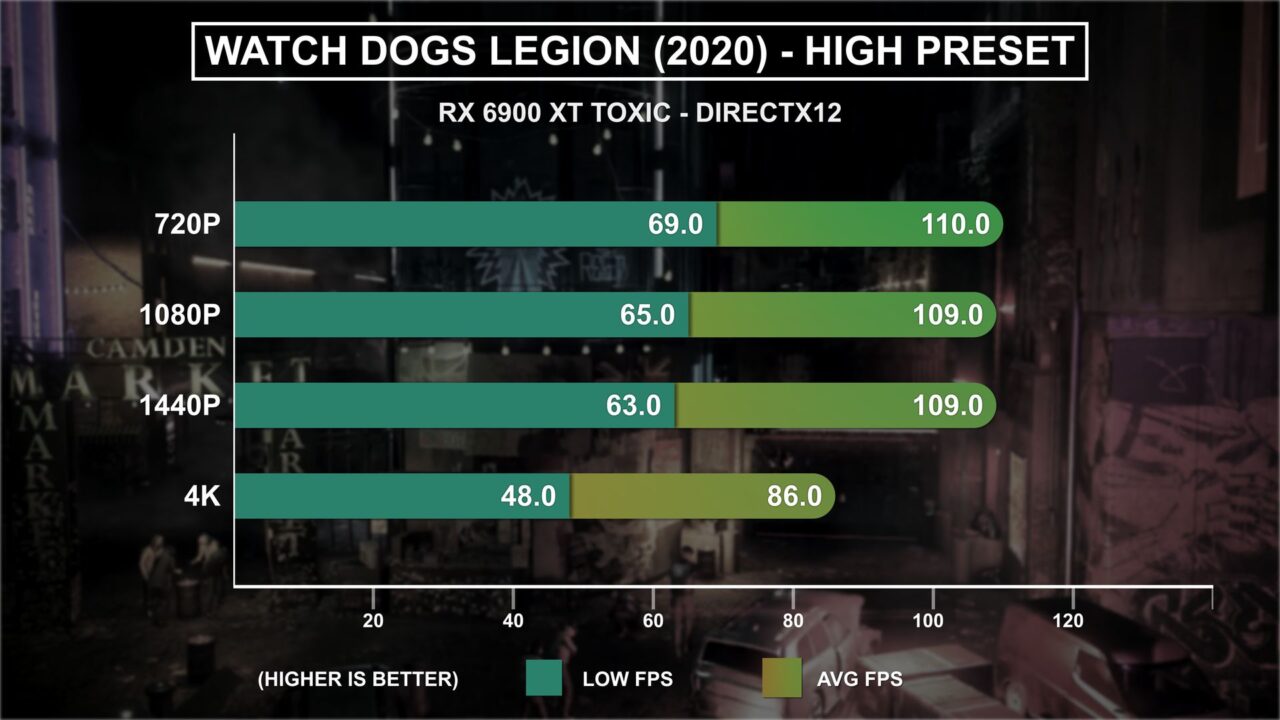
Comparing DX11 and DX12 using the high preset doesn’t provide as dramatic a result, though with averages increasing by 31% on average, the uplift is still impressive. Low FPS figures increased by 69% on average, with 4K seeing the biggest improvement going from 20 FPS to 48 FPS. Although it fails to maintain 60 FPS at all times, the RX 6900 XT can still provide a pleasant experience in this game at 4K high when using DirectX12.
HORIZON ZERO DAWN.
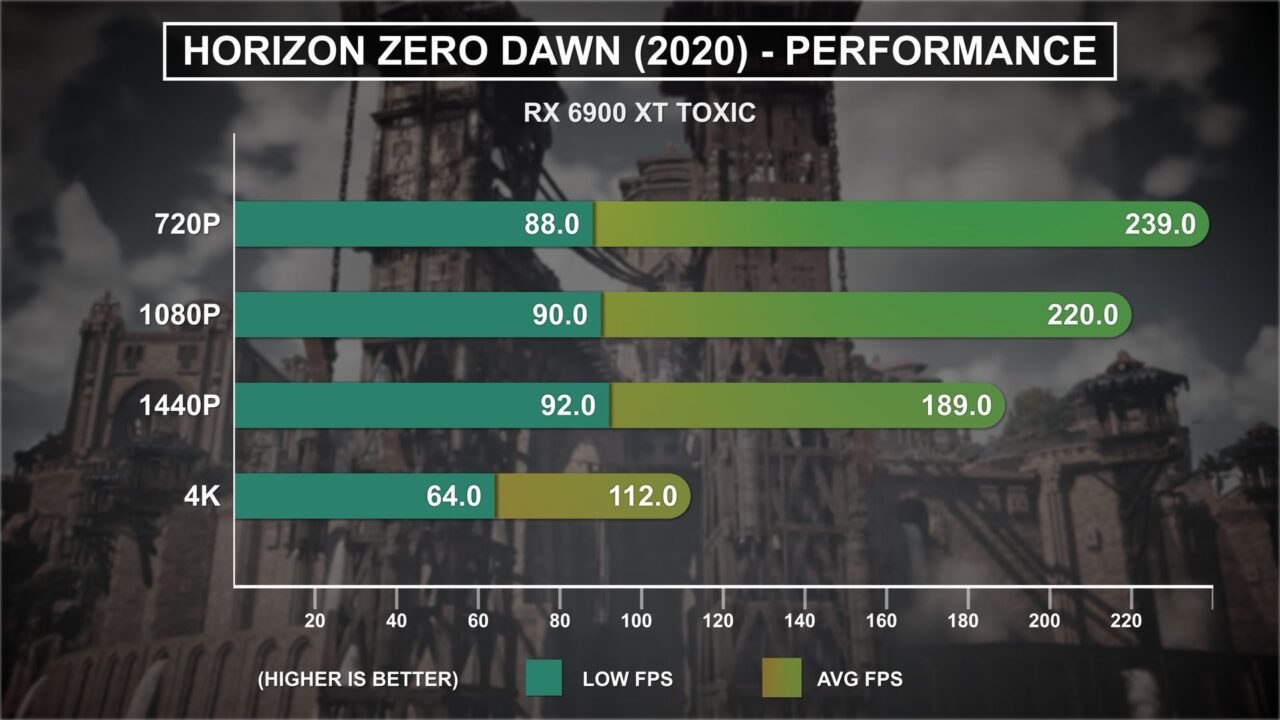
The PC port of Horizon Zero Dawn released in 2020 again sees the RX 6900 XT held back to some degree when running below 4K, and especially below 1440p. Using the Favor Performance preset, the minimum FPS results are capped around the 90 FPS mark below 4K, and average framerate sees a mild 8.6% increase from lowering resolution from 1080p to 720p.
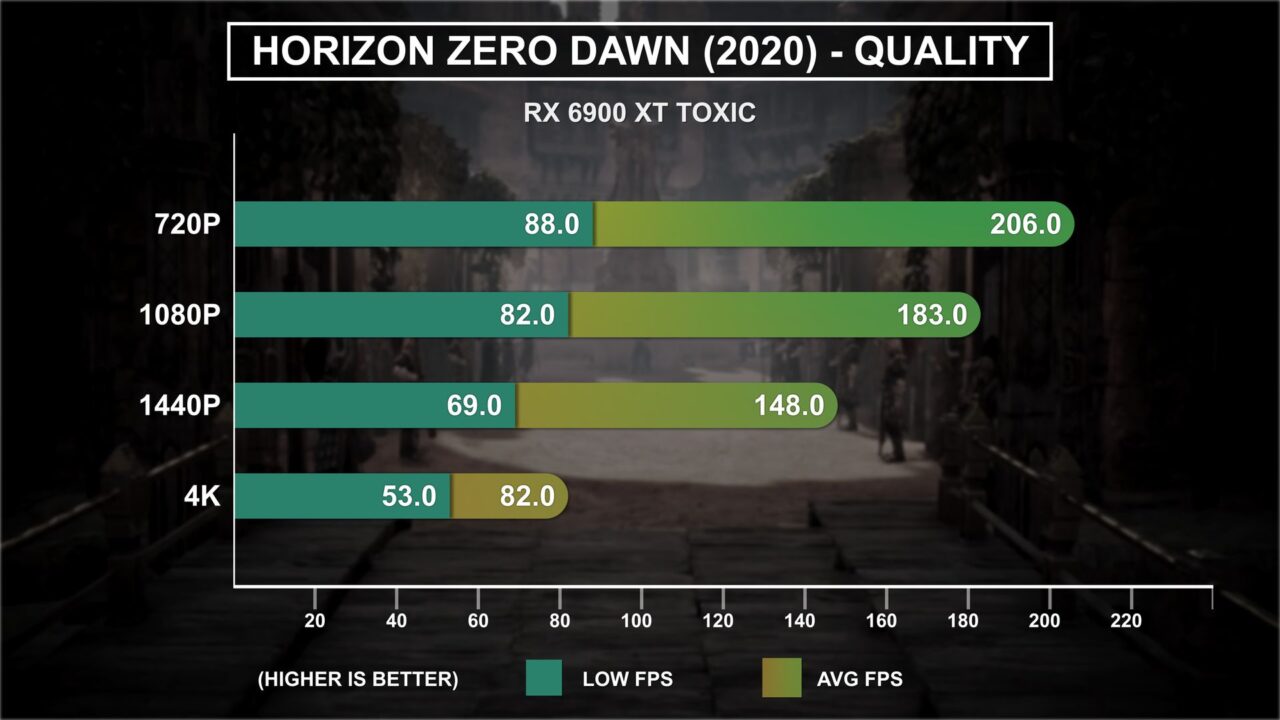
Using the higher, Favor Quality preset eases the CPU limit, putting the GPU to work especially at 4K. Here we see the average framerate drop by 27% from 112 to 82 FPS. In a single-player RPG like this, 82 FPS on average at 4K high settings is still an excellent experience.
TEARDOWN.
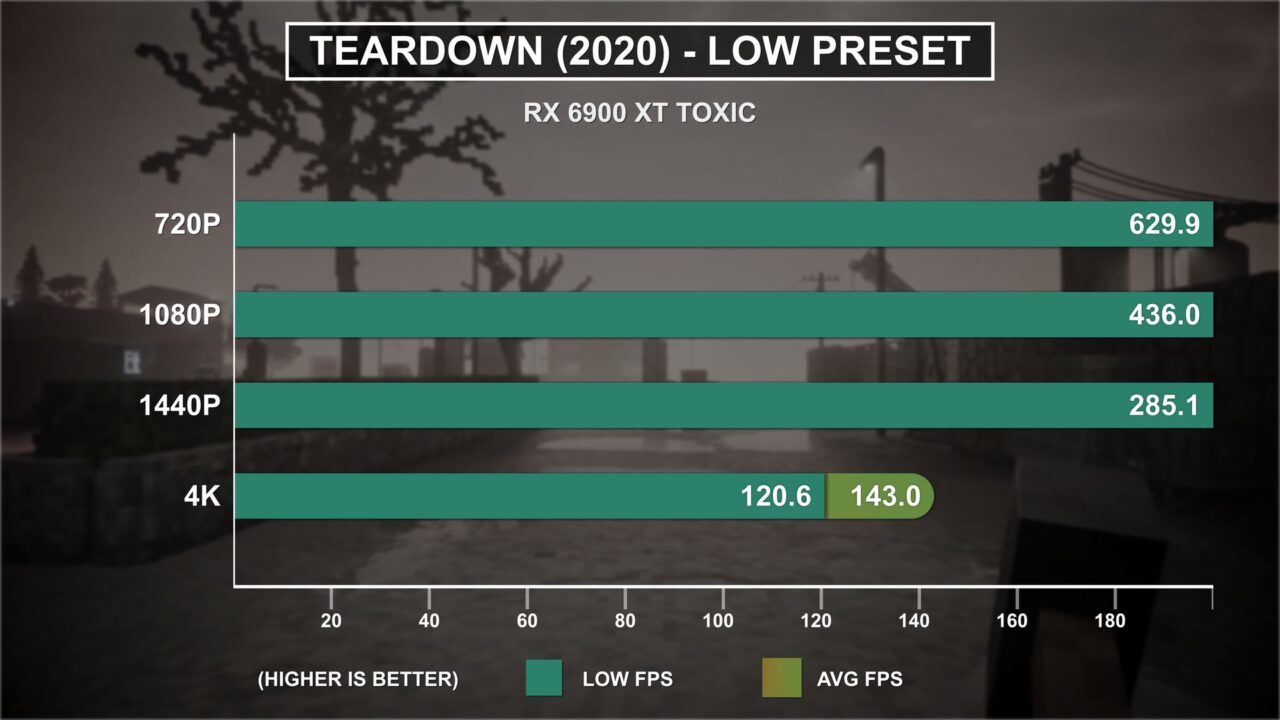
In contrast to Horizon, Teardown sees framerates mostly unrestricted. Using the low quality settings, the RX 6900 XT blazes into the several hundred FPS territory at 720p. At 4K, however, performance is somewhat more modest. With 143 FPS on average, and a steady low FPS of 120, gameplay was very smooth.
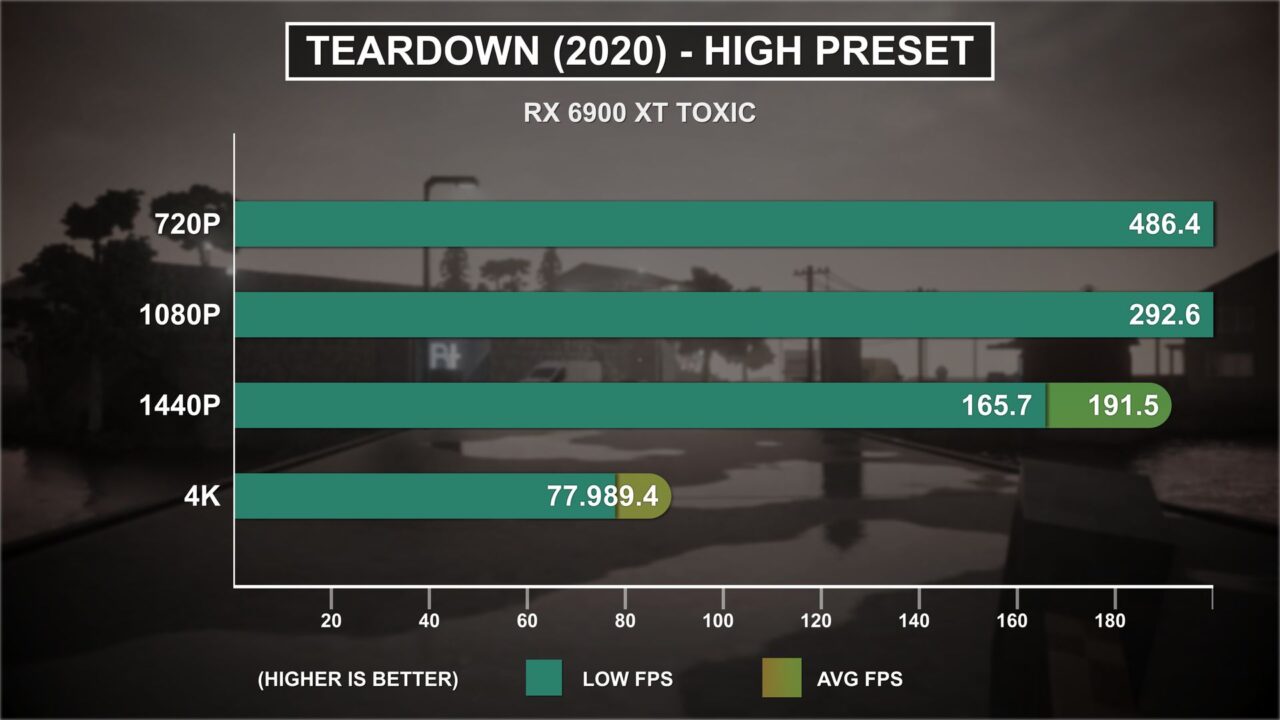
Turning the graphics settings up to high does see a hit to performance. At 1080p framerates are still unnecessarily high, though at 1440p with an average FPS of 191 it becomes more suited to a quality gaming monitor. At 4K the card managed 89 FPS on average, probably somewhat surprising given this was a $1,500 graphics card when this indie game was released. The reason for this title’s demanding performance is its use of path tracing. While it sure is beautiful, the performance impact at high resolution is substantial.
UNCHARTED 4.
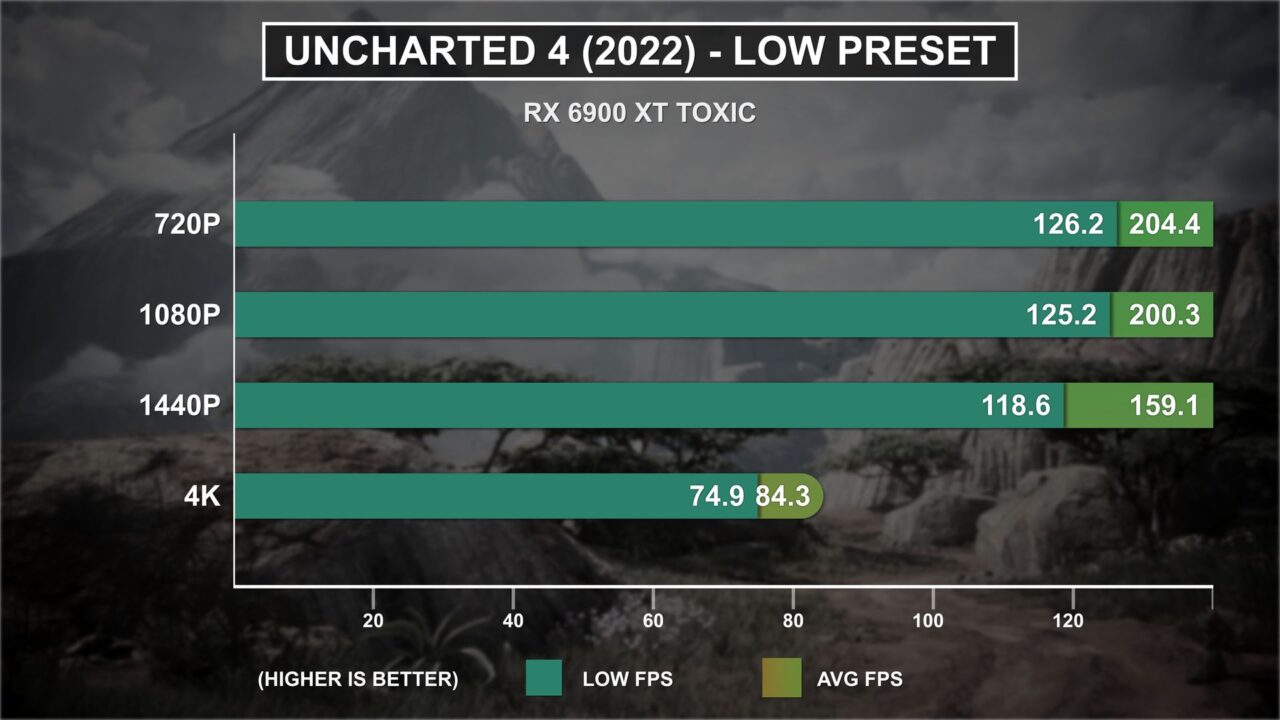
The last game in the test lineup is the 2022 release of Naughty Dog’s Uncharted 4. It is another PC port of an older PS4 exclusive title, but it is a beautiful game even today. Like games covered earlier in this review, Uncharted 4 does feature FSR support. However, I’ve tested with it disabled for the sake of testing. When running the low preset, performance doesn’t scale much when running below 1440p. The game appears to have a frame cap around 200 FPS. Running at 4K delivers a smooth 84 and 75 for average and low FPS figures respectively.
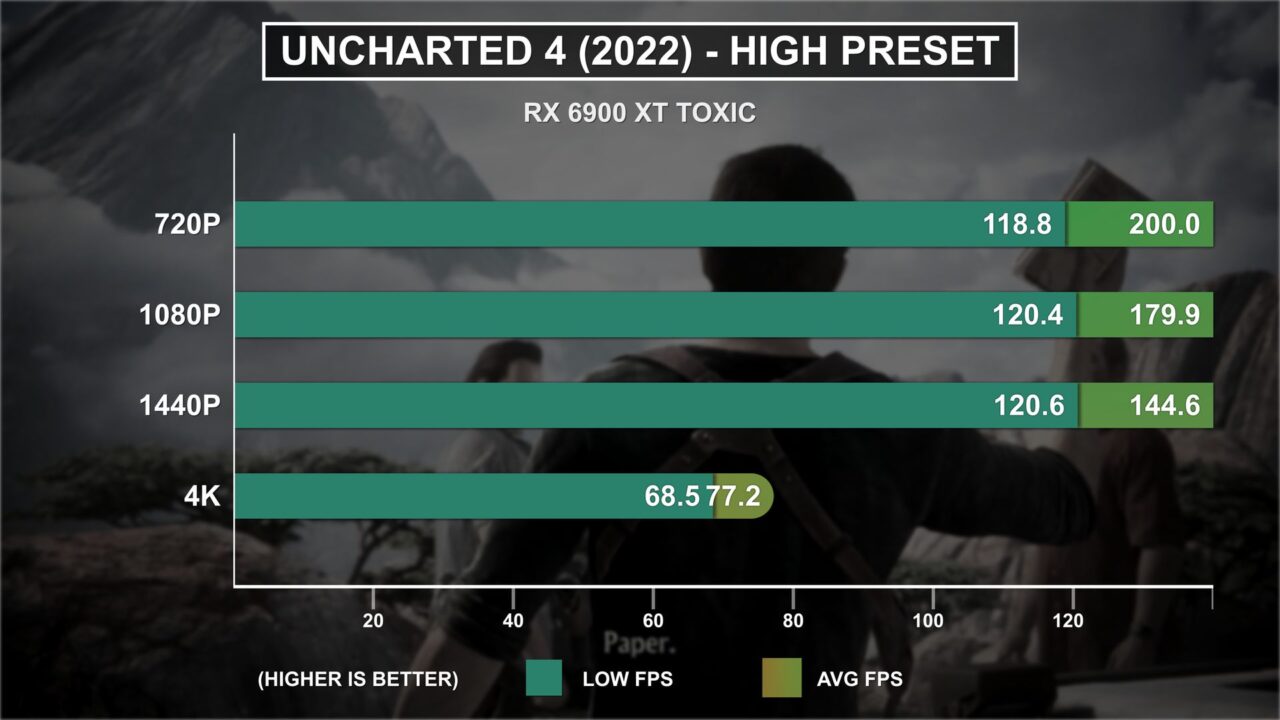
Turning up to the high preset only sees a slight drop to FPS on this card. At 4K framerates stay above 60 FPS at all times in my test pass. This game’s implementation of FSR does look pretty good to me, so if you do want a little more oomph at 4K the trade off may be worth it.
LET’S TAKE A LOOK AT THE 21-GAME AVERAGES
RX 6900 XT GAME SUMMARIES.
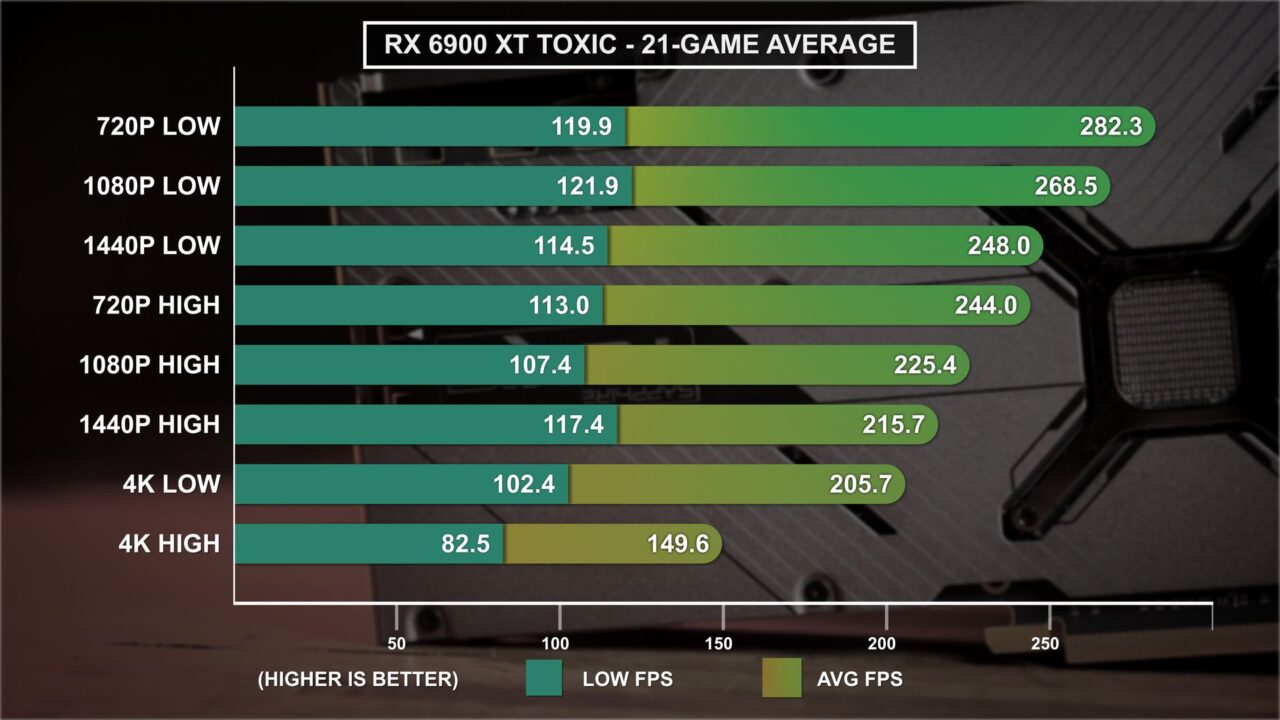
20-game FPS performance for each resolution and graphics settings tested:
RX 6900 XT IN SYNTHETICS.
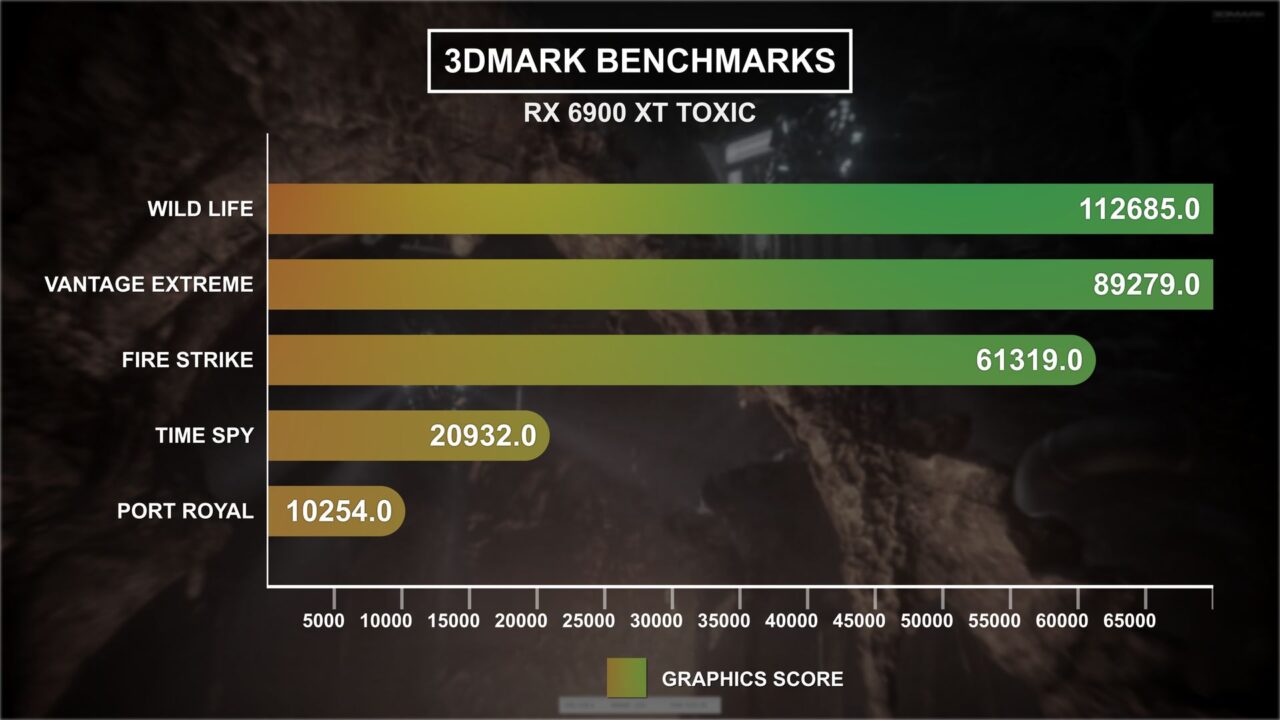
Testing with synthetic 3d benchmarks, we’ll start with 3DMARK. In both Wild Life and Vantage Extreme, the RX 6900 XT is literally off the chart. In Fire Strike, the Big Navi GPU produces an incredible 61,000 points. Time Spy and Port Royal are also very impressive at nearly 21,000, and over 10,000 respectively.
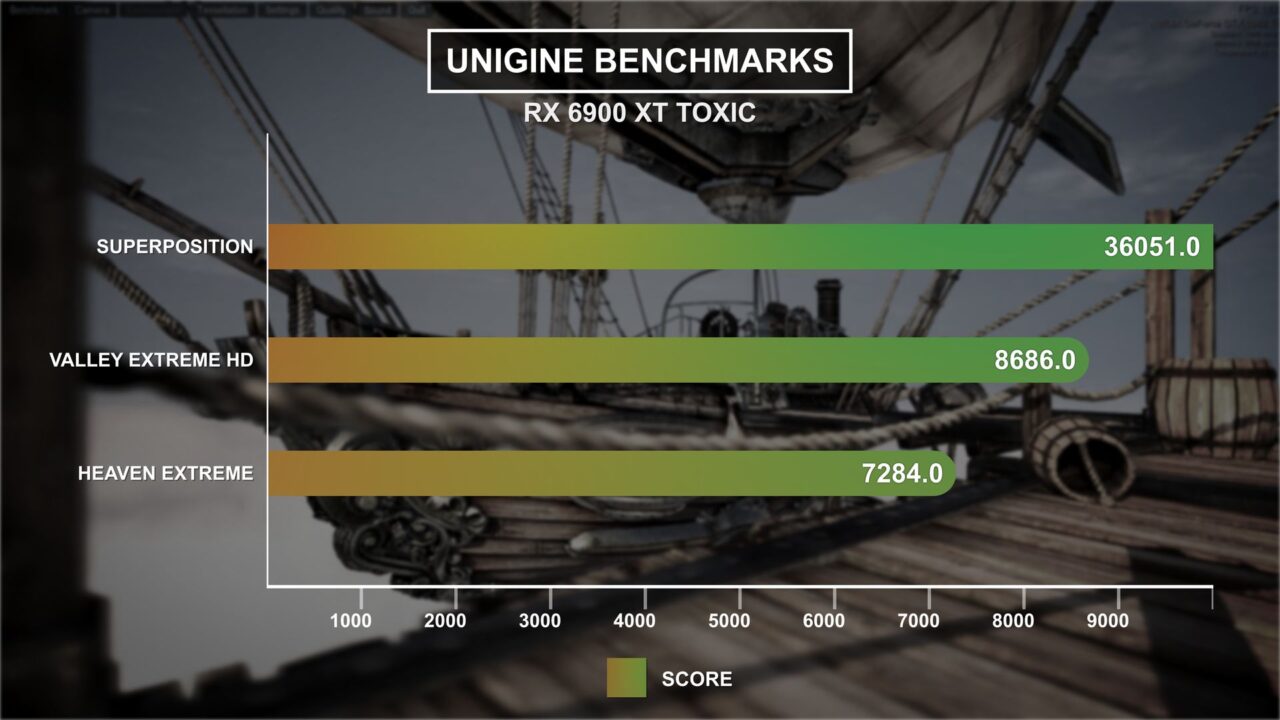
Unigine Superposition using the Medium preset ran at 265 FPS for a score of 36,000. Valley Extreme HD ran at 207.6 FPS for a score of nearly 9,000. And Heaven Extreme ran at 289 FPS scoring just under 7,300.
RX 6900 XT OVERCLOCKING.
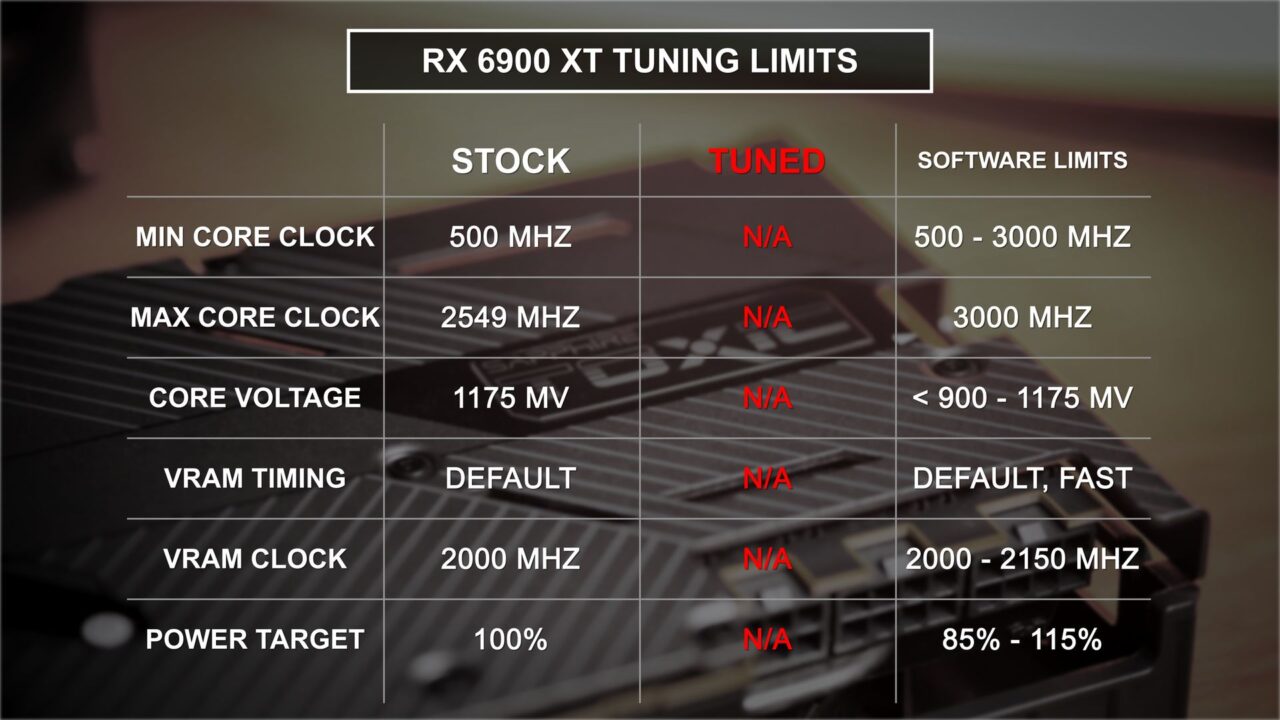
Since the card was on loan to me, I didn’t want to push my luck with overclocking. What I did instead was check out AMD’s tuning section in the Radeon driver to see what the software allows you to adjust. As you can see, the limits are somewhat restricted. There is plenty of room to lower core clock or voltage for more efficiency, but doing so will require extensive stability testing.
My preferred method of extracting more efficiency from a GPU is to just lower the power target. Here is the most disappointing part of this generation of Radeon GPUs in my opinion; we are only allowed a narrow window from 85% to 115% of stock power target. I am confident this GPU would still be very fast when limited to something much lower, like 50%, but the option isn’t there. At least not without 3rd party tools. Also, this card does have the same 3000 MHz clock limit that the standard RX 6900 XT cards have.
RX 6900 XT PRICE / PERF.
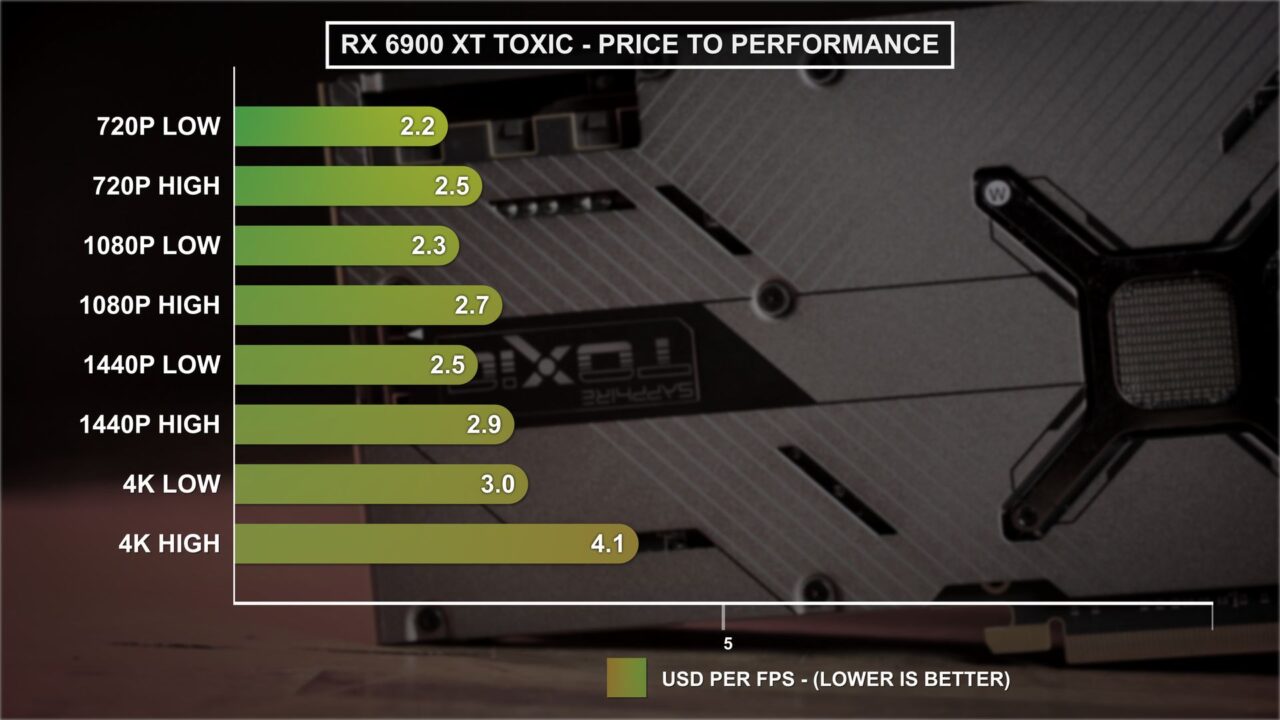
Unfortunately, this model of RX 6900 XT is no longer available new for a price competitive with other models. In lieu of new price, I’ve used the price of sold cards on eBay. The only two RX 6900 XT TOXIC Liquids sold in the last month sold for an average of 618.82 including shipping. That is quite the bargain compared to the card’s original MSRP, and especially compared to what scalpers would’ve been asking for it. Using this price, I’ve calculated the card’s value using the average performance figures gathered for this review. From 720p low to 4K low, cost per frame ranges from $2.20 to $3 per FPS. At the highest resolution and graphics settings, the price per frame increases to $4.10.
RX 6900 XT POWER AND EFFICIENCY.
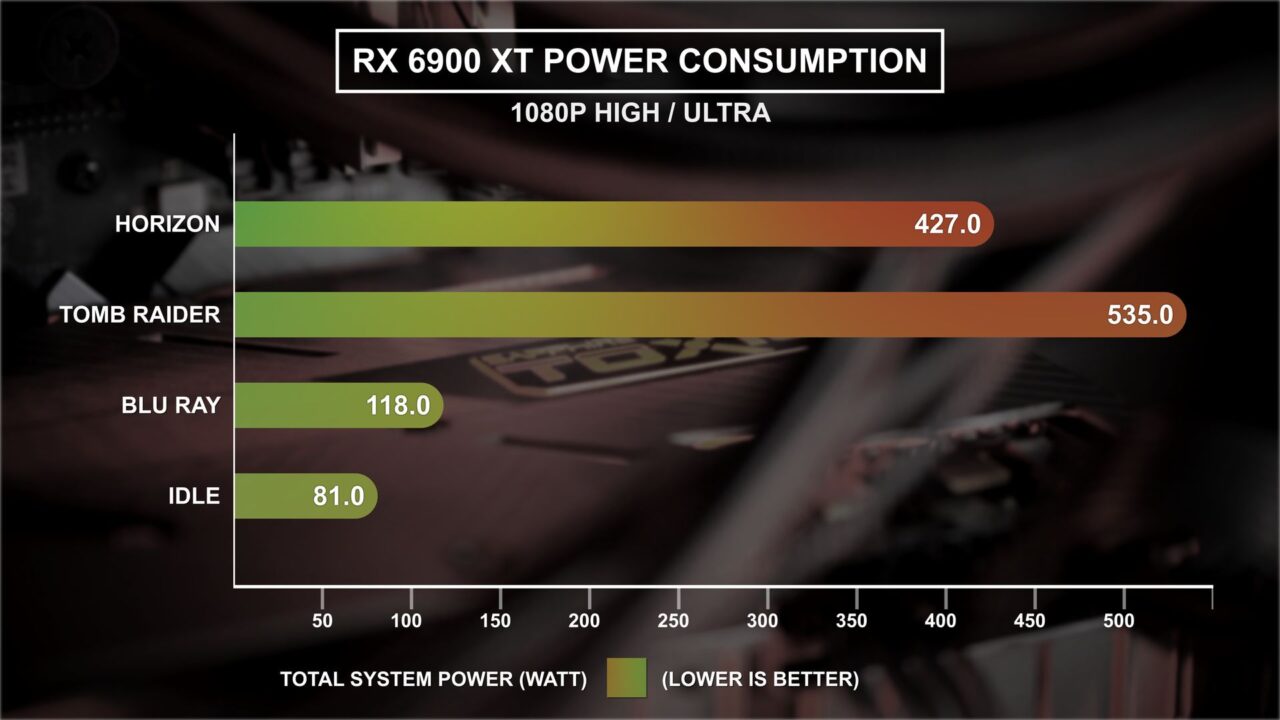
AMD rates the reference RX 6900 XT at 300 Watt TDP, and Sapphire rates the TOXIC Liquid version as less than 400 Watts. For power consumption testing I’ve tested using a watt meter at the wall to measure total system power. Running Horizon Zero Dawn at 1080p Quality preset results in a fairly CPU limited scenario, seeing total system power consumption hit 427 after 10 minutes. Tomb Raider, on the other hand, is much less CPU limited at the 1080p Ultra preset. Despite running at a framerate that breaks the benchmark tool, I was able to measure the power consumption at a whopping 535 Watts after 10 minutes in-game. Power consumption watching a blu ray movie was a far more reasonable 118 Watts, and the system drew just 81 Watts at idle.
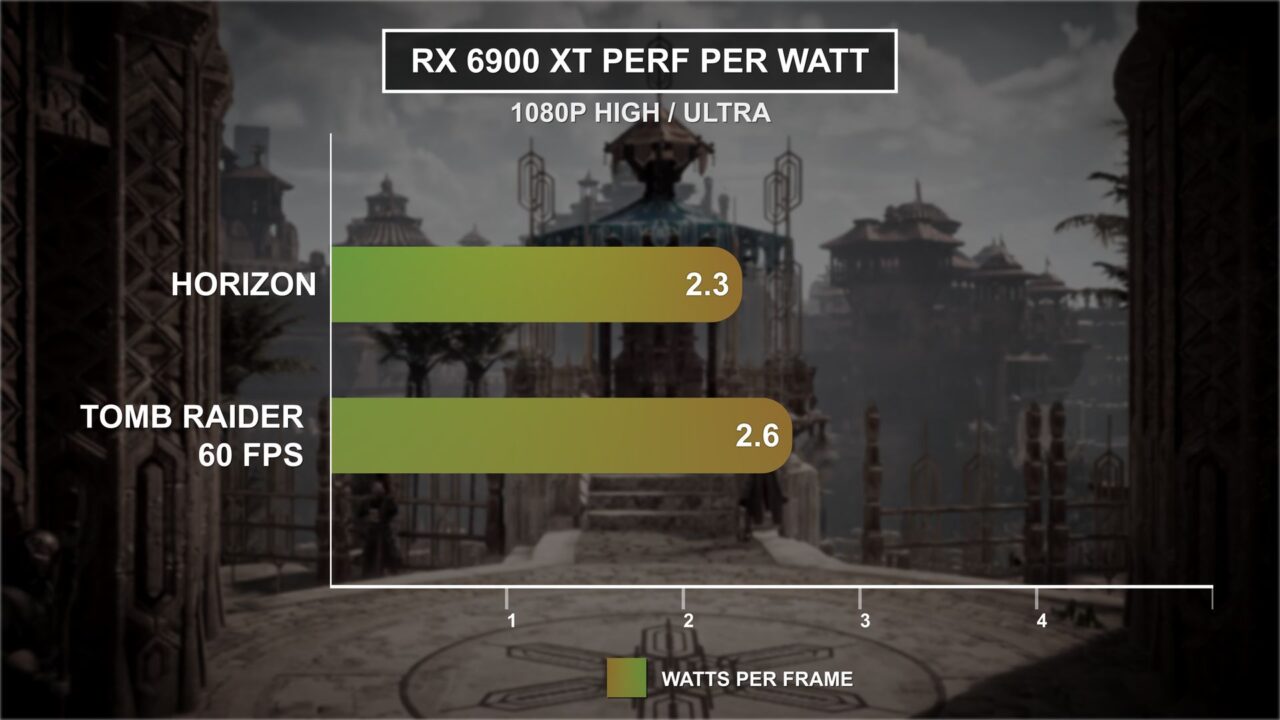
Since I wasn’t able to use Tomb Raider’s 1080p Ultra FPS for the performance per watt comparison, I’ve tested it when capped to 60 FPS. Capped to 60, the system drew just 157 Watts, for 2.6 Watts per frame. Horizon Zero Dawn ran more efficiently even uncapped, drawing just 2.3 Watts per FPS for its 183 FPS result.
RX 6900 XT TEMPERATURES.
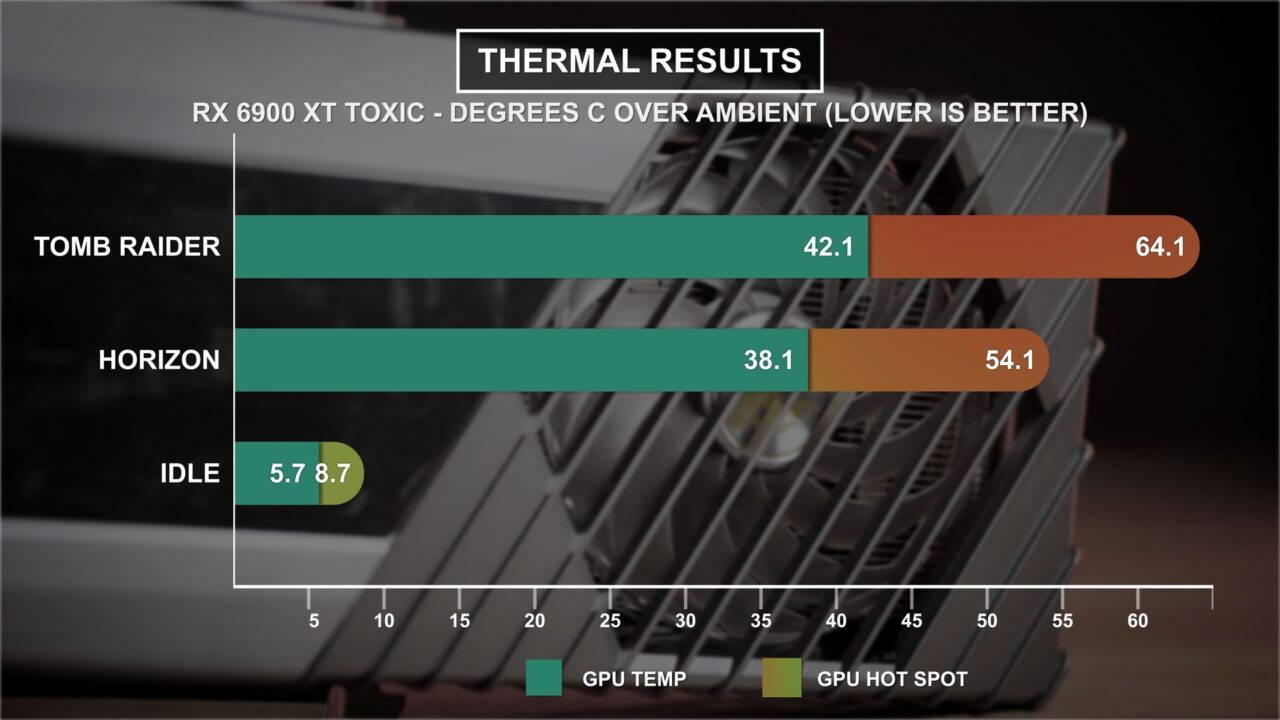
Thermals are no concern for the RX 6900 XT TOXIC. The massive 360mm radiator dissipates the power draw effortlessly. The GPU edge temp ran at just 5.7 C over ambient at idle, and under the heaviest load running Tomb Raider at 1080p Ultra, the GPU only reached 42.1 C over ambient at just 56 degrees when running in a cool 14 degrees Celsius room. Hot Spot temperatures were also very well controlled considering the power draw of this card.
RX 6900 XT NOISE TESTING.
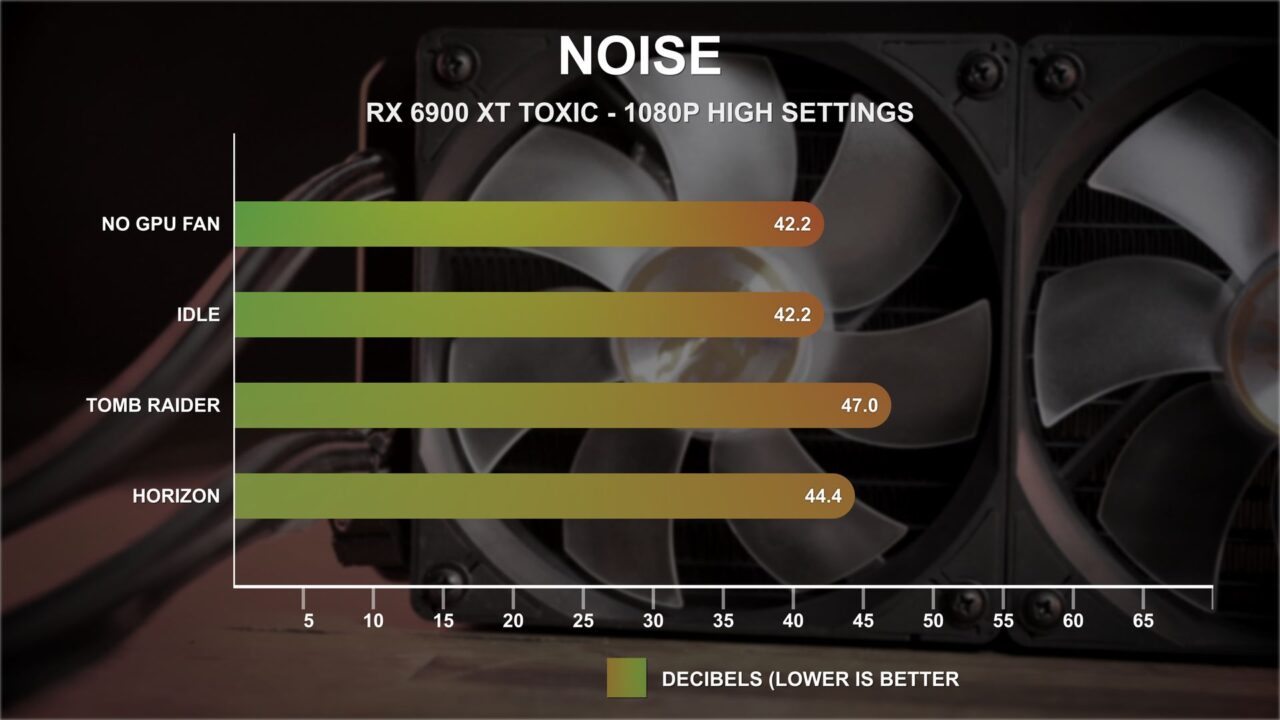
When idling, the three radiator fans stop fully. In fact, under lower loads the GPU runs cool enough to not even need the fans to run. In my testing in Space Engineers with the 120 FPS cap, the fans were stopped most of the time. When running under the heaviest load running Tomb Raider, the fan noise was only barely noticeable. I do want to point out that the case was not configured in an optimal configuration for this radiator size. It’s likely that a more favorable fan layout would result in quieter operation.
The trouble comes in when the fans need to spin up. They produce an audible “whoosh” noise briefly that can be noticed even within a closed case. This was particularly annoying when the game being played would see the GPU load just enough to barely need the fans. In this case the fans would start and stop every couple minutes, each time producing the distinct “whoosh” noise.
Also worth mentioning is coil whine. This sample produced noticeable coil whine when running at extreme framerates. This was much more noticeable on the older less demanding games that ran well above 200 FPS. In most games under 200 FPS it was not as noticeable.
FINAL THOUGHTS ON THE RX 6900 XT.
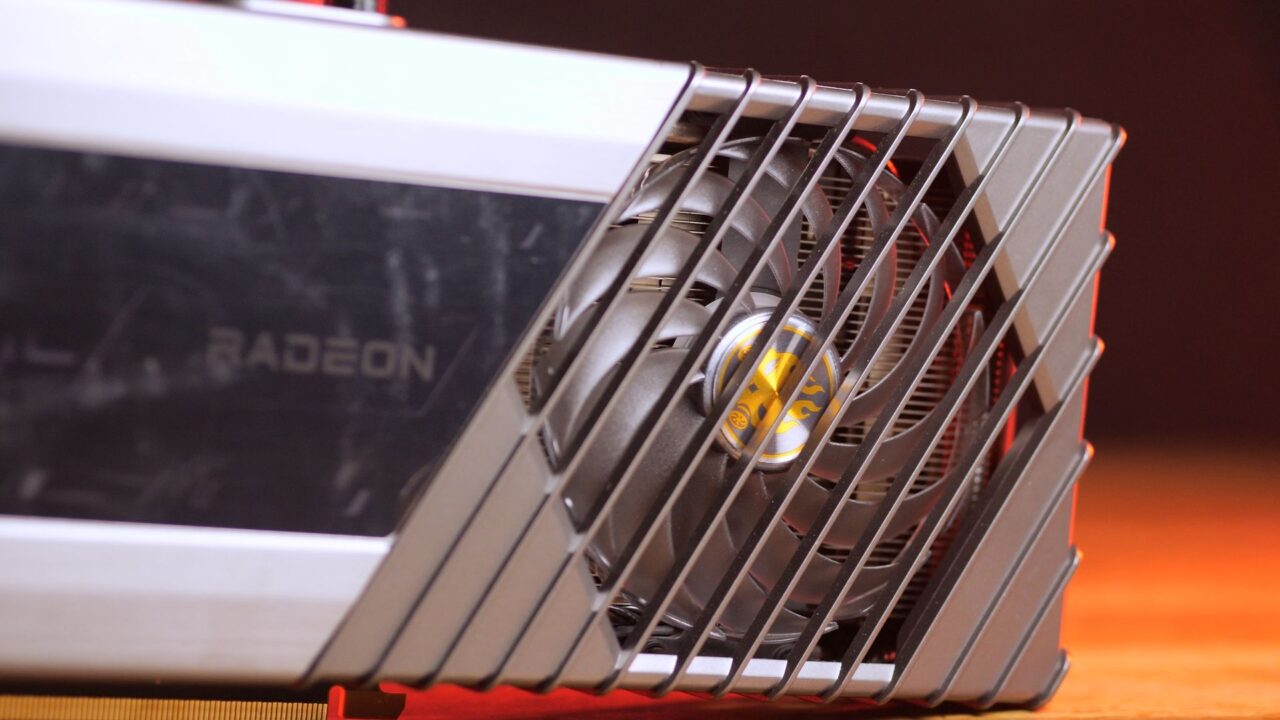
There is no doubt the RX 6900 XT is very fast GPU, and the TOXIC model is another step beyond that. Of course, in 2023 there are other GPUs on the market from both AMD and NVIDIA, so the RX 6900 XT is no longer the highest end. That said, this card made short work of every title tested. In particular at 1440p and below, this beast will probably continue to deliver great results for years to come.
So, would I recommend buying one in 2023? Yes, I would. If you’re in the market in the $500 to $700 price range, I think the RX 6900 XT is a great option. Should you get the TOXIC version with the built-in 360mm liquid cooler? That’s really up to you. Aside from the mentioned fan “whoosh” noise, the card was stellar. Though, personally I’d prefer the simplicity of an air-cooled card in exchange for a bit more noise and maybe a bit less performance.
Lastly, I want to recommend to anyone that does buy a card this powerful; make use of the driver’s FRTC ( Frame Rate Target Control). Limiting the card to something like 120 FPS may save you from unexpected issues from extreme framerates. It also has other benefits like saving power and saving your ears from possible coil whine.
This review has over 70 charts, and is the result of over 20 hours of testing. So, if you liked it, or think I could do something differently, let me know in the comments down below.
